


Marines Grapple With VC Major battle erupts in Operation Starlite Hell in the Highlands Two companies hold out against a fierce enemy onslaught BLACK TIGERS Secret Warfare Rare Images of Special Ops Unit in Action HOMEFRONT Natalie Wood’s last big box office score UNDERCOVER COMMANDOS STRIKE AT NIGHT SUMMER 2023 HISTORYNET.com VIEP-230700-COVER-DIGITAL.indd 1 4/24/23 2:37 PM
Ifyou’re anything like my dad, you give your family everything. Your name, your time, your values — the people in your life know they can depend on you for practically anything. In exchange for imparting all of this energy and experience, you expect nothing in return.




e point? You deserve to treat yourself once in a while. You do so much for the people you care about. Now it’s time to focus on you for just a few minutes. at’s where the Men’s Due Volta Watch comes in. is astonishing innovation provides a digital readout that’s powered by a precise quartz engine, combining both analog and digital timekeeping.





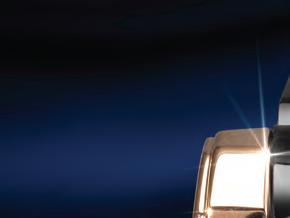


Out tted with a stopwatch, alarm, a.m./ p.m. settings, and day, date and month complications, this timepiece stands out from the crowd. With its large face and handsome, masculine design, this watch is perfect for the back nine and the happy hour afterwards. Water-resistant up to 3 ATM, this timepiece won’t wimp out if you have a run-in with a water hazard.


Other hybrid watches can sell for thousands of dollars, but because we’ve built more than 1 million watches, we know how to create real value. at’s why we can o er this timepiece for just $59! If you’re not completely satis ed with this watch, return it for a full refund.
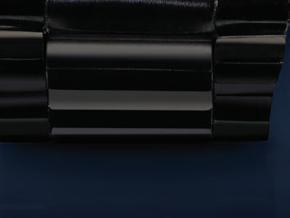


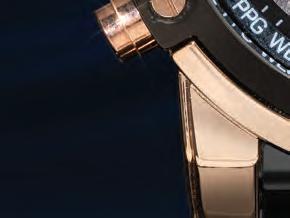

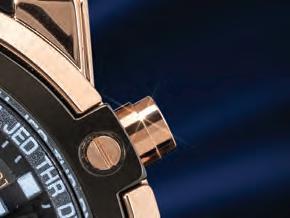
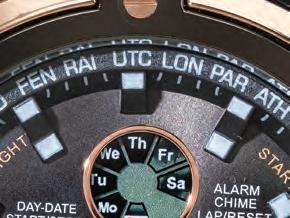


Act quickly! is one-of-a-kind watch has been one of our fastest sellers this year. Of our original run of 2,872, we only have 389 left for this ad! In the last couple of years there’s been a watch shortage, but Stauer has got you covered. If you’re the kind of man who gives everything and expects nothing in return, it’s time to treat yourself. Watch

Speci
Precision
chronograph
Stainless steel caseback and crown • Water-resistant to 3 ATM Men’s Due Volta Watch $399 $59* + S&P Save $320 *Special price only for customers using the offer code. Stauer, 14101 Southcross Drive W., Ste 155, Dept. DVW185-02, Burnsville, MN 55337 www.stauer.com Stauer® | AFFORD THE EXTRAORDINARY ® For the Man Who Gives Everything and Expects Nothing 1-800-333-2045 Your Insider Offer Code: DVW185-02 Stauer®Impossible Price ONLY 59 Join more than 1 million smart people who own stauer watches VIE-230523-013 Stauer Due Volta Watch.indd 1 3/31/2023 7:33:37 AM
cations: • Complications: stopwatch, alarm, a.m./p.m. settings, and day, date and month •
movement
•

VIE-230523-016 Veterans Commemorative-jb.indd 1 4/24/23 11:41 AM
SUMMER 2023

ON THE COVER
French commando units used disguises and the cover of darkness to beat insurgents at their own game–deadly ambushes.

BLACK TIGERS
Former fighters in World War II’s French Resistance applied their knowledge of guerrilla warfare to combating insurgents in Vietnam.
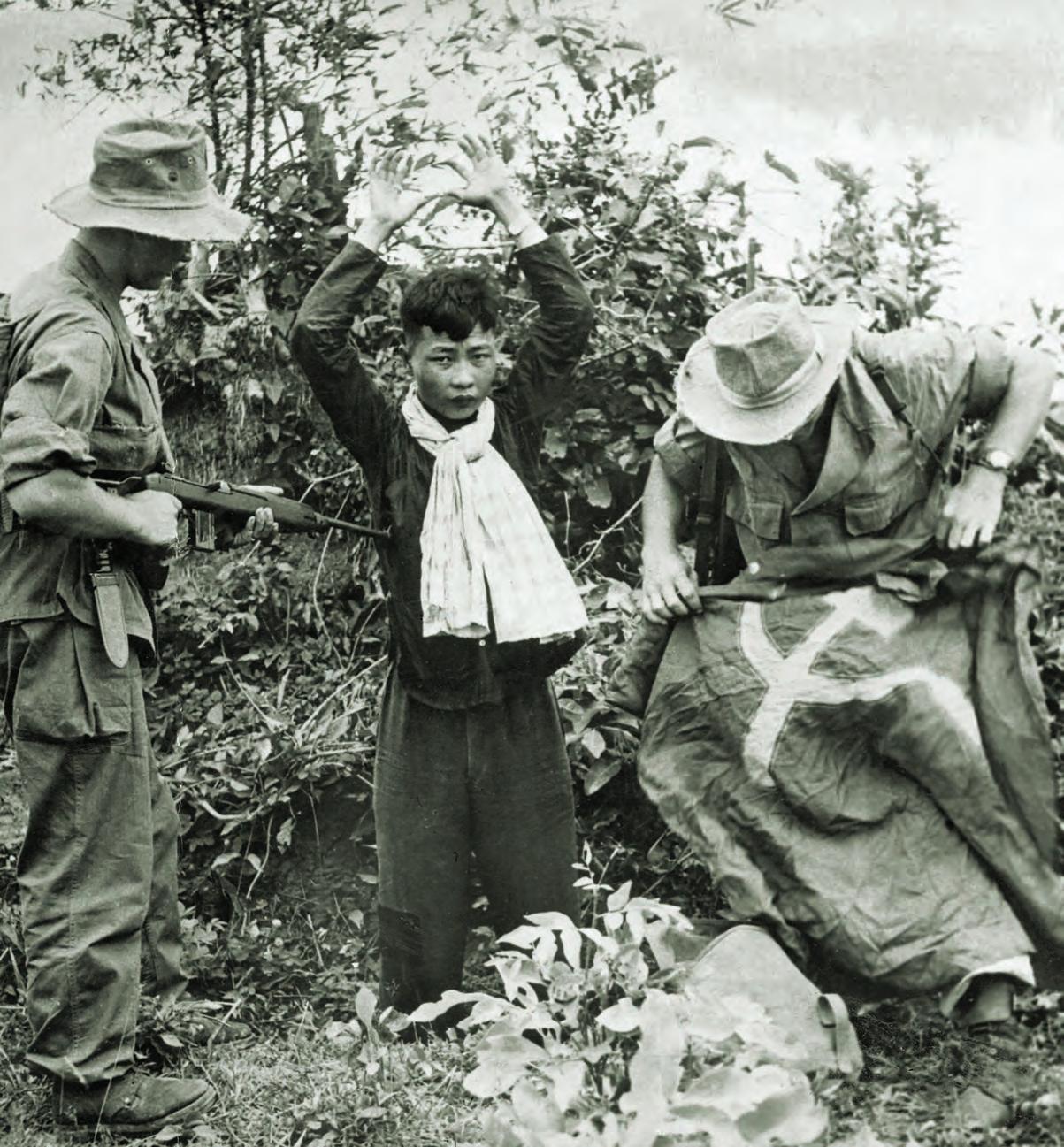 By Andrew McGregor
By Andrew McGregor
22
COVER: ISTOCK; PHOTO ILLUSTRATION BY BRIAN WALKER; INSET: PICTURELUX/THE HOLLYWOOD ARCHIVE/ALAMY; BELOW: AKG-IMAGES/TT NEWS AGENCY
VIEP-230700-CONTENTS.indd 2 4/21/23 8:36 AM
A young man caught carrying a communist flag is taken prisoner by French troopers in 1950.
8 Intel Warship Named for MOH Hero
14 Tactics
The Logic Behind Firebases
16 Arsenal
KC-135 Stratotanker
HIT MY SMOKE!
18 Reflections
Computers in Vietnam, The Fallen Temple
58 Media Digest
64 Hall of Valor
Kevin “Dasher” Wheatley
—See story, page 36
HELL IN THE CENTRAL HIGHLANDS
Two infantry companies were sent to look for missing comrades. The enemy was waiting for them.
By Warren Wilkins
The Cessna O-2 Skymaster proved an invaluable asset to Forward Air Controllers on dangerous assignments.
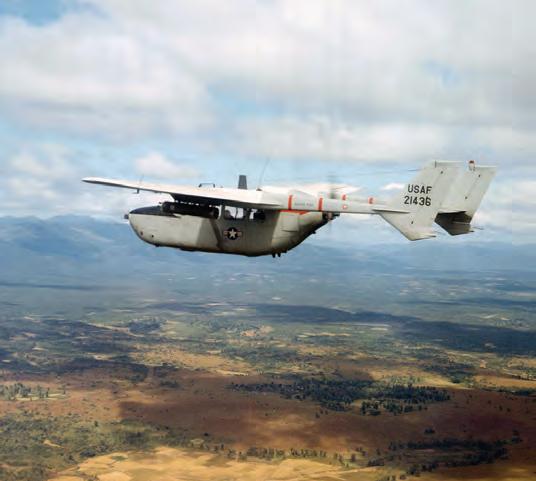 By Barry Levine
By Barry Levine
A HARD-FOUGHT VICTORY
U.S. Marines faced off against a tough Viet Cong regiment in the first major U.S. offensive of the Vietnam War.

 By John Walker
By John Walker
SNAPSHOTS FROM THE SECRET WARS
These rare images cast a light on the clandestine world of MACV-SOG fighters taking part in top-secret missions behind enemy lines.
By Zita Ballinger Fletcher

36
50
44 30
“We barely got lined out, when the First Platoon was hit.”
6 Feedback
VIEP-230700-CONTENTS.indd 3 4/21/23 8:37 AM
A. REINSTEIN CHAIRMAN & PUBLISHER
TRENDING NOW




In The Hornet’s Nest
Things looked hopeless for infantrymen ambushed in a rubber plantation in Vietnam until armored cavalry assault vehicles arrived.
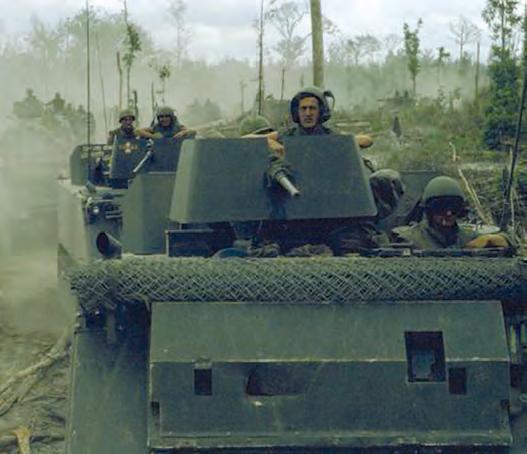 By Jeff Harvey www.historynet.com/loc-ninh-
By Jeff Harvey www.historynet.com/loc-ninh-
armored-cav
PLUS! Today
What happened today, yesterday— or any day you care to search. Daily
Test your historical acumen—every day!
What If?
Consider the fallout of historical events had they gone the ‘other’ way.
Weapons & Gear
The gadgetry of war—new and old— effective, and not-so effective.
HISTORYNET
Sign up for our FREE e-newsletter, delivered twice weekly, at historynet.com/newsletters

ZITA BALLINGER FLETCHER EDITOR
LARRY PORGES SENIOR EDITOR
JERRY MORELOCK SENIOR EDITOR
JON GUTTMAN RESEARCH DIRECTOR
DAVID T. ZABECKI EDITOR EMERITUS
HARRY SUMMERS JR. FOUNDING EDITOR
BRIAN WALKER GROUP DESIGN DIRECTOR
MELISSA A. WINN DIRECTOR OF PHOTOGRAPHY
JON C. BOCK ART DIRECTOR GUY ACETO PHOTO EDITOR
DANA B. SHOAF EDITOR IN CHIEF CLAIRE BARRETT NEWS AND SOCIAL EDITOR
ADVISORY BOARD
JOHN HOWARD, JIM KNOTTS, BARRY M c CAFFREY, PAUL MORANDO, CARL O. SCHUSTER, EARL H. TILFORD JR., SPENCER C. TUCKER, JAMES H. WILLBANKS, HEIDI ZIMMERMAN
CORPORATE
KELLY FACER SVP REVENUE OPERATIONS
MATT GROSS VP DIGITAL INITIATIVES
ROB WILKINS DIRECTOR OF PARTNERSHIP MARKETING
JAMIE ELLIOTT SENIOR DIRECTOR, PRODUCTION
ADVERTISING
MORTON GREENBERG SVP Advertising Sales mgreenberg@mco.com
TERRY JENKINS Regional Sales Manager tjenkins@historynet.com
DIRECT RESPONSE ADVERTISING MEDIA PEOPLE / NANCY FORMAN nforman@mediapeople.com
SUBSCRIPTION INFORMATION 800-435-0715 or SHOP.HISTORYNET.com
Vietnam (ISSN 1046-2902) is published quarterly by HISTORYNET, LLC, 901 North Glebe Road, Fifth Floor, Arlington, VA 22203 Periodical postage paid at Vienna, VA, and additional mailing offices. Postmaster, send address changes to Vietnam, P.O. Box 900, Lincolnshire, IL 60069-0900

List Rental Inquiries: Belkys Reyes, Lake Group Media, Inc. 914-925-2406; belkys.reyes@lakegroupmedia.com
Canada Publications Mail Agreement No. 41342519
Canadian GST No. 821371408RT0001
© 2023 HISTORYNET, LLC
The contents of this magazine may not be reproduced in whole or in part without the written consent of HISTORYNET, LLC.
PROUDLY MADE IN THE USA
U.S. ARMY
SUMMER 2023 VOL. 36, NO. 1
MICHAEL
VISIT HISTORYNET.COM
in History
Quiz
VIEP-230700-MASTHEAD.indd 4 4/21/23 9:08 AM
Your Service Military Outdoor Yard Sign

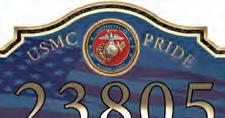
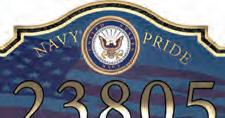





Show









Display your loyalty to your branch of service! This distinctive sign is proudly custom printed with official graphics as well as your address, with a subtle image of Old Glory waving in the background! For indoor or outdoor use, this Bradford Exchange exclusive is crafted of sturdy metal and coated with a clear finish to make it weather-safe and durable. It arrives ready to display indoors with hanging hardware, or outdoors with metal yard stakes (all provided).

Order your customized address sign today, in three payments of $39.99, totaling $119.99*. Send no money now. Your purchase is backed by our unconditional, 365-day money-back guarantee with no risk. Don’t wait. Complete and return the Reservation Application today!
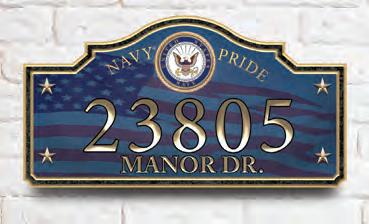
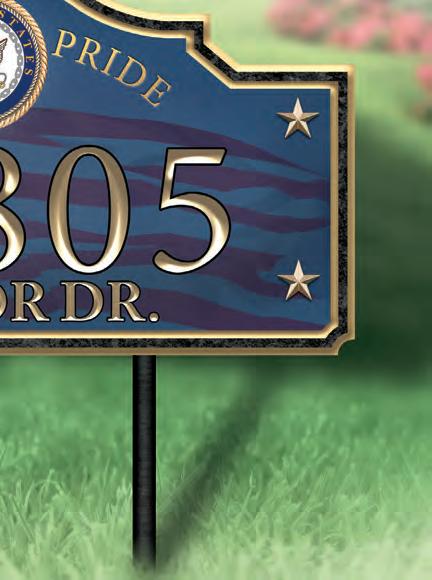
B_I_V = Live Area: 7 x 9.75, 1 Page, Installment, Vertical Price Logo Address Job Code Tracking Code Yellow Snipe Shipping Service ❏ YES. Please reserve the Military Outdoor Address Sign for me, personalized as indicated below: *Plus a total of $17.99 shipping and service; see bradfordexchange.com. Please allow 4-8 weeks after initial payment for shipment. Subject to product availability and order acceptance. Please Respond Promptly Over 1 Foot Wide! Shown smaller than actual size of about 13¾" W x 9" H. Hanging device and yard stakes included for easy, secure display indoors or outdoors. Display on a wall OR in your yard! ©2021 BGE 01-34213-001-BIP (Maximum 24 characters including spaces; total for both street name and number address.) Street Number Street Name Please print the branch name and 3-digit branch code from above right: By federal law, licensing fees paid to the U.S. Army for the use of its trademarks provide support for the Army Trademark Licensing Program, and net licensing revenue is devoted to U.S. Army Morale, Welfare and Recreation programs. U.S. Army name, trademarks and logos are protected under federal law and used under license by The Bradford Exchange. ™Officially Licensed Product of the United States Marine Corps. ®Officially Licensed Product of the Department of the Navy ™Department of the Air Force™. Officially Licensed Product of the Air Force™ www.airforce.com
in
Customized FREE with your address Choose from 5 branches! ARMY 001 NAVY 002 USMC 003 AIR FORCE 004 COAST GUARD 005
Pride
The Bradford Exchange P.O. Box 806,
Grove,
ORDER AT BRADFORDEXCHANGE.COM/MILITARYSIGN Officially Licensed Product of the United States Coast Guard Mrs. Mr. Ms. Name (Please Print Clearly) Address City State Zip Email (optional) 01-34213-001-E39572 VIE-230523-008 The Bradford Exchange Military Yard Sign.indd 1 3/31/2023 7:55:30 AM
RESERVATION APPLICATION SEND NO MONEY NOW
Morton
IL 60053-0806 Where Passion Becomes Art
Lost Chances?
FEEDBACK



Your article in the Winter 2023 issue of Vietnam magazine [“The Enemy Listened In”] prompted a memory from when I attended the Infantry Officer Basic Course at Fort Benning in 1978. During our class on OPSEC, the instructors played a film clip with audio that showed an example of Imitative Communication Deception (ICD). The command group of a U.S. infantry battalion conducting a sweep in Tay Ninh Province along the Cambodian border were reacting to an “Australian voice” warning the Americans that they were “stepping into their AO” and requesting they establish a “liaison” to deconflict operations. The film clip showed the
The letter from Ho Chi Minh to President Truman [Words from the War, Spring 2023] reminded me that Ho wrote the “Declaration of Independence of the Democratic Republic of Vietnam” based on the U.S. Declaration of Independence, citing the lines: “All men are created equal. They are endowed by their Creator with certain inalienable rights, among them are Life, Liberty, and the pursuit of Happiness.” It’s always made me wonder: What IF America had supported him and steered him away from communism in the 1940s?
—Phong Tran
confusion that followed as the command group attempted to verify the friendly unit and its location with higher headquarters. The instructors familiar with the incident stated the delay and confusion allowed a Viet Cong unit time to escape back to its sanctuary in Cambodia. I looked up this incident online after reading your article and found that it took place in January 1968 and involved an infantry battalion from 2BDE, 25ID. Known as the “Australian ICD incident,” the voice continued to confuse the Americans for several days until H&I [harassment and interdiction] fires were called on several possible locations. No trace of “the Australian voice” was found. Evidently, this voice continued to harass U.S. and allied units for several months until early 1969. Australians who listened to the tapes verified that the accent was authentic and that the person, who was never identified, was a real Australian. During my tour in El Salvador as a senior adviser to the ESAF during the civil war (1979–1992), the guerrillas used ICD quite often in attempts to confuse the advisors and our counterparts during combat operations.
John Lopez Jr.
Major, U.S. Army Retired (1975–1995)
Battle, Spring 2023] should have been learned at Lt. Col. Hal Moore’s battle at Ia Drang and the aftermath massacre at LZ Albany. It wasn’t, and that fact explains the U.S. loss of the war. The blame rests heavily on U.S. officers wearing four stars and on civilian suits in Washington. Their incompetence lost the war.
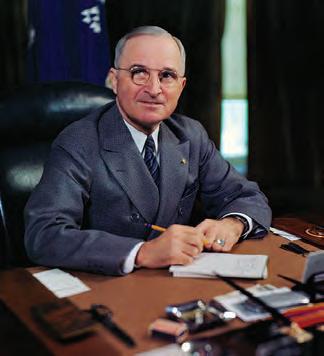
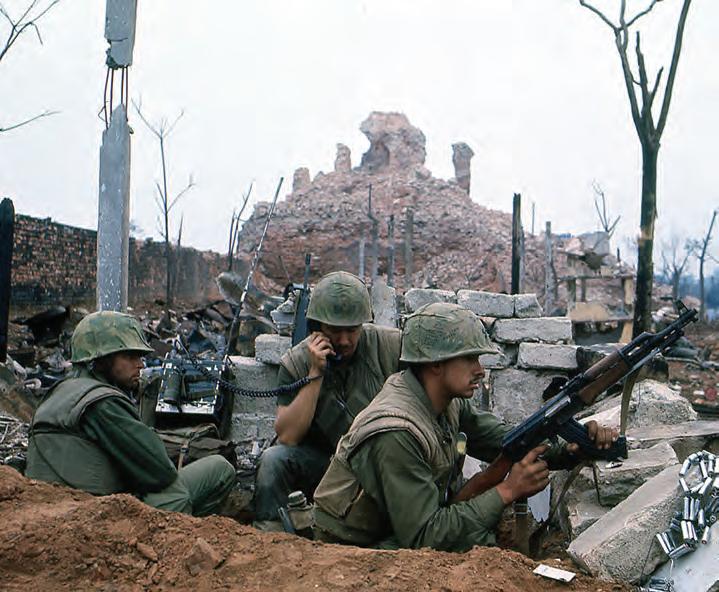 —James Creech
—James Creech
Glad she didn’t get hurt [Reflections: “The Last Miss America in Vietnam,” Spring 2023]…thank you for supporting us…Nam 69–70.
—Frank Nemeth Sr.
This lesson [Tactics: “Deadly Embrace: How Communist Forces ‘Hugged’ U.S. Units in @VietnamMag
6 VIETNAM TOP: JOHN OLSON/STARS AND STRIPES; BOTTOM: LIBRARY OF CONGRESS
Email your feedback on Vietnam magazine to vietnam@historynet.com, subject line: Feedback. Please include city and state of residence.
Enemy forces in Vietnam eavesdropped on U.S. radio communications to gather intelligence that could be used against American troops on the battlefield.
VIEP-230700-FEEDBACK.indd 6 4/21/23 8:50 AM
Truman
Get Your FREE Vietnam War
50th Anniversary Coin
Preserve history with this Vietnam War Anniversary coin. Yours FREE – send only $2.95 for shipping and guaranteed delivery.
Operation Chopper was the first major US combat operation of the Vietnam War.
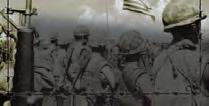


Send today and you’ll also receive special collector’s information and other interesting coins on approval. Strict limit of one coin. Satisfaction guaranteed.
Vietnam War Anniversary Coin

❏ Yes! Send me the FREE Vietnam War Anniversary Coin. Enclosed is $2.95 for shipping & guaranteed delivery. My satisfaction is guaranteed. Strict limit of one coin.


Quick order at MysticAd.com/YX145
Name ________________________________________________
Address ______________________________________________
City/State/Zip _________________________________________
❏ Check or money order
❏ Visa ❏ American Express
❏ MasterCard ❏ Discover Exp. Date ___/___
Please send payment to: Mystic, Dept. YX145, 9700 Mill St., Camden, NY 13316-9111
Get Mint Vietnam War Stamp Sheets


Only
$1 – Save $20.95
Now you can own mint stamp sheets documenting iconic moments from the Vietnam War – for only $1. You’ll save $20.95 off Mystic’s regular price plus get FREE shipping and guaranteed delivery! It’s a great value.
With these sheets, you can get a front-row seat to Vietnam War history. Take advantage of my special invitation and get all three mint Vietnam War stamp sheets for just $1. You’ll get FREE shipping and guaranteed delivery. Send today and you’ll also receive special collector’s information and other interesting stamps on approval. Limit of five collections at this low price.
Vietnam Mint Stamp Sheets
❏ Yes! Send me the 3 Vietnam Mint Stamp Sheets. Enclosed is $1. Limit of five collections. Shipping and guaranteed delivery are free.
Quick order at MysticAd.com/OY106
Name ________________________________________________

Address ______________________________________________
City/State/Zip _________________________________________

❏ Check or money order
❏ Visa ❏ American Express
*Add
❏ MasterCard ❏ Discover Exp. Date ___/___





Please send payment to: Mystic Stamp, Dept. OY106, 9700 Mill St., Camden, NY 13316-9111

✔
state sales tax to order total..
✔
state sales tax to order total.
*Add
VIE-230523-007 Mystic Stamps and Coins.indd 1 3/31/2023 7:21:40 AM
NAVY TO NAME NEW WARSHIP FOR MOH RECIPIENT
The Navy has announced that a new guided-missile destroyer will be named for Vietnam veteran Capt. Thomas Gunning Kelley, whose selfless bravery in the face of enemy fire earned him the Medal of Honor in 1970.
Kelley, born in Boston in 1939, joined the Navy as a lieutenant in 1960 and volunteered for service in Vietnam. On June 15, 1969, Kelley, commanding River Assault Division 152, was leading an effort to extract infantry soldiers from a riverbank in Kien Hoa Province when his column of eight boats came under heavy fire from the Viet Cong. Kelley exposed his boat to enemy attack while protecting his men and directing a counterassault. A shell exploded nearby, severely injuring Kelley in the head and eventually leading to the loss of his eye, but he continued giving orders and directing fire until the enemy threat was suppressed. Kelley was awarded the Medal of Honor the following year for his “extraordinary courage under fire” and “selfless devotion to duty.” After a 30-year career in the Navy, Kelley retired as a captain in 2011 and served in the Massachusetts Department of Veterans’ Services, eventually being named department secretary in 2003. He retired in 2011.
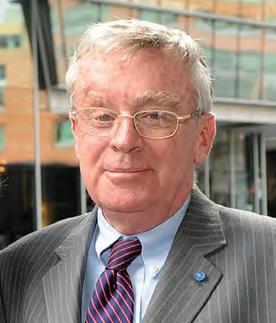
The ship to be named for Kelley is DDG-140, an Arleigh Burke-class

destroyer. These guided-missile warships incorporate stealth technology that allows them to conduct anti-air, anti-submarine, and anti-surface warfare and are considered pillars of the Navy’s surface fleet. The ship will be built in either Maine or Mississippi; a commissioning date has yet to be scheduled.
Capt. Kelley said the naming was a “tremendous honor,” and that he hopes that “those who sail in this ship will be reminded of service to their shipmates and that they will be carrying on a tradition greater than themselves.” During the naming announcement in January, Secretary of the Navy Carlos Del Toro said, “May we all, especially the future men and women assigned to this ship, always be inspired by Kelley’s brilliant leadership, bold initiative, and resolute determination.”
—Larry Porges
TOP: U.S. NAVY; INSET: TED FITZGERALD/MEDIANEWS GROUP/BOSTON HERALD VIA GETTY IMAGES FROM TOP: NASA; PICTORIAL PRESS LTD/ALAMY; ISTOCK PHOTO 8 VIETNAM
The U.S. Navy announced in January that a future Arleigh Burke-class destroyer will be named for Capt. Thomas Kelley, whose bravery in Vietnam in 1969 earned him the Medal of Honor.
VIEP-230700-INTEL.indd 8 4/21/23 9:06 AM
Kelley
LONG-DELAYED MOH AWARDED TO VIETNAM HERO
The firefight lasted an excruciating 19 hours. A pre-dawn raid on a North Vietnamese Army camp in the town of Bong Son on June 18, 1965, by the U.S. Army’s 5th Special Forces Group triggered a fierce counterattack that pinned down the entire group, including its commander, Capt. Paris Davis. Under withering fire, Davis engaged in hand-to-hand combat, directed air strikes against the enemy position, and constantly sprinted across a paddy field to pull injured members of his team to safety. In the melee, he was shot twice and maimed by shell fragments from an enemy grenade. Refusing medical evacuation to remain with his troops, Davis was credited with saving the lives of at least three men under his command and was recommended for the Medal of Honor later that year for his heroic actions.
But, somehow, the paperwork for the medal was lost. His commander dutifully re-submitted it...and it was just as soon lost again. In 2016, Davis’ supporters—including members of his team at Bong Son—submitted the paperwork a third time. Finally, on March 3, 2023, after a nearly six-decade delay, Davis was awarded the nation’s highest military honor in a ceremony at the White House. President Joe Biden presented the 83-year-old former Green Beret with the medal, saying, “You’re everything our nation is at our best. Brave and bighearted, determined and devoted, selfless and steadfast.”

The cause of the delay has been the subject of much speculation. Because Davis is Black, racism was suspected as a possible reason for the mysterious record disappearances. Although Maj. Gen. Patrick Roberson, deputy commanding general of Special Operations Command, told the AP that the Army hasn’t been able to “see anything that would say, “Hey, this is racism,’” Davis believes otherwise, telling CBS News in 2021, “I don’t think, I know race was a factor.”
The day of the medal presentation was one of celebration. Davis said through his daughter, “I am so proud to be an American soldier and a Green Beret. I am grateful for what the Army provided me and what America has given me— opportunity, purpose, and pride.”
—Larry Porges
SUMMER ’69
Apollo 11 propels astronauts Neil Armstrong, Michael Collins, and Edwin “Buzz” Aldrin (above) to the moon—a staggering 953,054 miles from home. Cultural aftershocks are many and include David Bowie’s “Space Oddity” and Gil Scott-Heron’s spoken-word poem “Whitey on the Moon,” spotlighting racial inequality in the United States. The phrase “If they can send a man to the Moon, why can’t they ...?” has since become part of American vernacular.
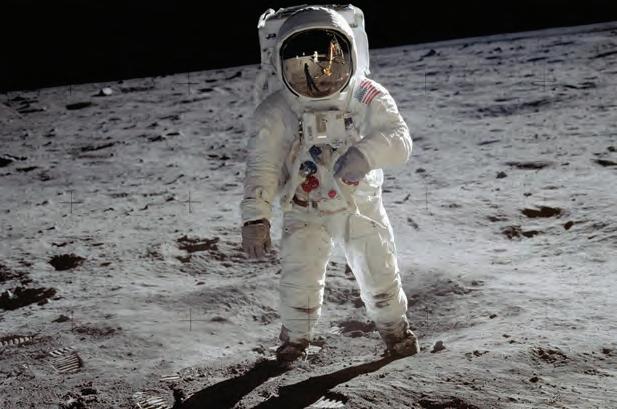
Natalie Wood (second from left) stars with Elliott Gould, Robert Culp, and Dyan Cannon in Bob & Carol & Ted & Alice New York Times film critic Vincent Canby wrote at the time, “Bob and Carol and Ted and Alice are conceived as cheerful but humorless boobs, no more equipped to deal with their sexual liberation than Lucy and Desi and Ozzie and Harriet.” Despite mixed reviews the offbeat of-the-era dramedy was highly successful at the box office, earning Natalie Wood (with a percentage of the gross) a cool $5 million over the next three years.
The Age of Aquarius comes to a close as Charles Manson and his “family” commit a series of nine murders in the Los Angeles area. During the high-profile Tate-LaBianca murder trial, a Los Angeles Times reporter tracked down Manson’s mother, who claimed that Charles was not neglected in his youth and was “pampered by all the women who surrounded him.” ...Folk singer Joni Mitchell watches news coverage of the Woodstock music festival from a New York City hotel room. She didn’t attend the festival for fear of missing a scheduled appearance on “The Dick Cavett Show.” Ironically, she would later write the definitive anthem of the event—simply titled “Woodstock”—inspired by the media coverage and a first-hand account from Graham Nash, her partner at the time. —Brian Walker

TOP: U.S. NAVY; INSET: TED FITZGERALD/MEDIANEWS GROUP/BOSTON HERALD VIA GETTY IMAGES FROM TOP: NASA; PICTORIAL PRESS LTD/ALAMY; ISTOCK PHOTO 9 SUMMER 2023
HOMEFRONT
VIEP-230700-INTEL.indd 9 4/21/23 9:06 AM
RELIC SPOTLIGHT
1967 may have been the Summer of Love in San Francisco, but President Lyndon B. Johnson may not have remembered it that way. This anti-war, anti-LBJ button, made in the City by the Bay in 1967, expressed many young Americans’ growing frustration with the political establishment and the Vietnam War. The year’s counterculture movement, centered in San Francisco’s Haight-Ashbury neighborhood and embodied by flower children advocating free love, psychedelic drugs, and communal living, darkened the following year. The anti-war protests grew less playful and more confrontational, culminating in the Chicago riots during the 1968 Democratic National Convention in August.

WORDS FROM THE WAR
This cable from April 19, 1975, was sent by U.S. Secretary of State Henry Kissinger to Graham Martin, U.S. Ambassador to South Vietnam about the impending evacuation of Saigon. It also contains advice about interactions with President Nguyen Van Thieu of South Vietnam. This very candid document is one of many that have been made available to the public by the National Archives.
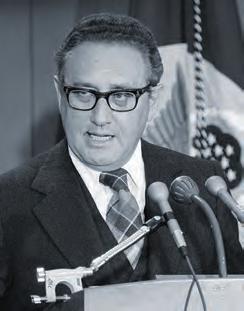

TOP: NATIONAL ARCHIVES AND RECORDS ADMINISTRATION, LYNDON B. JOHNSON LIBRARY AND MUSEUM, AUSTIN, TEXAS; ABOVE LEFT: NATIONAL ARCHIVES; ABOVE RIGHT: LIBRARY OF CONGRESS 10 VIETNAM
Kissinger
VIEP-230700-INTEL.indd 10 4/21/23 9:07 AM
Urgent: Special Summer Driving Notice
To some, sunglasses are a fashion accessory…
But When Driving, These Sunglasses May Save Your Life!
Drivers’ Alert: Driving can expose you to more dangerous glare than any sunny day at the beach can… do you know how to protect yourself?
Thesun rises and sets at peak travel periods, during the early morning and afternoon rush hours and many drivers find themselves temporarily blinded while driving directly into the glare of the sun. Deadly accidents are regularly caused by such blinding glare with danger arising from reflected light off another vehicle, the pavement, or even from waxed and oily windshields that can make matters worse. Early morning dew can exacerbate this situation. Yet, motorists struggle on despite being blinded by the sun’s glare that can cause countless accidents every year. Not all sunglasses are created equal. Protecting your eyes is serious business. With all the fancy fashion frames out there it can be easy to overlook what really matters––the lenses. So we did our research and looked to the very best in optic innovation and technology. Sometimes it does take a rocket scientist. A NASA rocket scientist. Some ordinary sunglasses can obscure your vision by exposing your eyes to harmful UV rays, blue light, and reflective glare. They can also darken useful vision-enhancing light. But now, independent research conducted by scientists from NASA’s Jet Propulsion Laboratory has brought forth ground-breaking technology to help protect human eyesight from the harmful effects of solar radiation
Eagle Eyes® Lens
light. This superior lens technology was first discovered when NASA scientists looked to nature for a means to superior eye protection— specifically, by studying the eyes of eagles, known for their extreme visual acuity. This discovery resulted in what is now known as Eagle Eyes
The Only Sunglass Technology Certified by the Space Foundation for UV and Blue-Light Eye Protection. features the most advanced eye protection technology ever created. The TriLenium Lens Technology offers triple-filter polarization to block 99.9% UVA and UVB— plus the added benefit of blue-light eye protection. Eagle Eyes® is the only optic technology that has earned official recognition from the Space Certification Program for this remarkable technology. Now, that’s proven science-based protection. The finest optics: And buy one, get one FREE! Eagle Eyes® has the highest customer satisfaction of any item in our 20 year history. We are so excited for you to try the Eagle Eyes® breakthrough technology that we will give you a second pair of Eagle Eyes® Navigator™ Sunglasses FREE––a $59.95 value!
That’s two pairs to protect your eyes with the best technology available for less than the price of one pair of traditional sunglasses. You get a pair of Navigators with stainless steel black frames and the other with stainless steel gold, plus one hard zipper case and one micro-fiber drawstring cleaning pouch are included. Keep one pair in your pocket and one in your car.
Your satisfaction is 100% guaranteed.
Studies by the National Highway Traffic Safety Administration (NHTSA) show that most (74%) of the crashes occurred on clear, sunny days

Navigator™ Black Stainless Steel Sunglasses
Receive the Navigator™ Gold Sunglasses (a $59.95 value) FREE! just for trying the Navigator™ Black



Navigator™ Gold Stainless Steel Sunglasses

was developed from original NASA Optic technology and was recently inducted into the Space Foundation Technology Hall of Fame.

Fit-ons available for $39 +S&H Black or Tortoise-Shell design
with absolute confidence, knowing your eyes are protected with technology that was born in space for the human race.
Two Pairs of Eagle Eyes® Navigator™ Sunglasses $119.90†
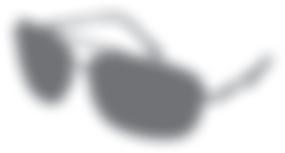
Offer Code Price $49 + S&P Save $70.90
Offer includes one pair each Navigator™ Black and Navigator™ Gold Sunglasses
1-800-333-2045
Your Insider Offer Code: EEN925-06

more vivid and sharp. You’ll immediately notice that your eyes are more comfortable and relaxed and you’ll feel no need to squint. The scientifically designed sunglasses are not just fashion accessories—they are necessary to protect your eyes from those harmful rays produced by the sun during peak driving times.
If you are not astounded with the Eagle Eyes® technology, enjoying clearer, sharper and more glare-free vision, simply return one pair within 30 days for a full refund of the purchase price. The other pair is yours to keep. No one else has such confidence in their optic technology. Don’t leave your eyes in the hands of fashion designers, entrust them to the best scientific minds on earth. Wear your Eagle Eyes® Navigators
You must use this insider offer code to get our special price.
Stauer ®
Rating of A+
14101 Southcross Drive W., Ste 155, Dept. EEN925-06 Burnsville, Minnesota 55337 www.stauer.com
† Special price only for customers using the offer code versus the price on Stauer.com without your offer code.
Smart Luxuries—Surprising Prices ™
simulation
Slip on a pair of Eagle Eyes® and everything instantly appears
VIE-230523-014 Stauer Navigator Sunglasses.indd 1 4/4/2023 10:42:23 AM
Jesse Treviño, acclaimed Mexican American artist who lost his dominant right hand in Vietnam but re-learned to paint with his left, died Feb. 13, 2023, in his home city of San Antonio, Texas. He was 76. Born in Mexico in 1946, he moved with his family when he was four years old to San Antonio and displayed talent as a painter. He won a scholarship to study art in New York, but his education was interrupted in 1966 when he was drafted into the Army and deployed to Vietnam.
In February 1967, Treviño stepped on a landmine while under sniper fire in the Mekong Delta. Badly wounded, his right arm was eventually amputated below the elbow. Learning to paint with his left hand, Treviño re-enrolled in art school in 1968 and began exploring his Chicano culture. He devoted himself to public artworks celebrating the heritage of San Antonio. One of his more visible projects is the nine-story mural “Spirit of Healing” on the Children’s Hospital of San Antonio. Treviño personally presented a painting of the Alamo to President Ronald Reagan in 1987. His works have appeared in exhibitions at the Smithsonian and reside in the presidential libraries of Lyndon B. Johnson, George H.W. Bush, and Reagan.
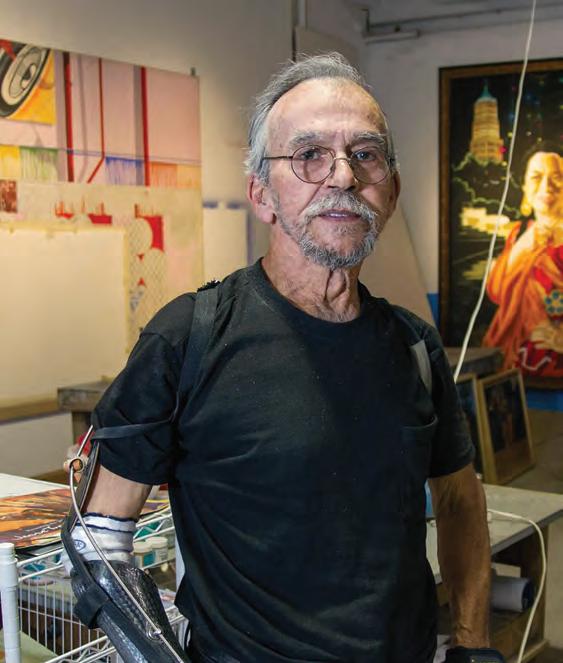
After his passing, San Antonio Mayor Ron Nirenberg called Treviño an “American hero,” and noted that his works of public art are “now icons across the landscape.”
Lt. Gen. Richard Trefry, whose U.S. military service spanned from World War II through Vietnam and into the first Bush Administration, died in Virginia on Feb. 25, 2023, at age 98. A native of Massachusetts, Trefry served in the Army Air Forces in World War II and attended West Point after the war, graduating in 1950. His career, specializing in field artillery, took him to Germany and Korea and then as an instructor to Fort Sill, Okla. In September 1966, as commander of an artillery battalion—the 2nd Battalion, 94th Artillery—he shipped to Vietnam, deploying with the U.S. Marines in Northern I Corps. Trefry was promoted to brigadier general in 1973 and assigned to Laos, where he served in critical advisory roles to the government and helped defeat an attempted coup d’état by exiled Laotian air force officers.
From 1977 until his retirement from active service in 1983, Trefry served as the Army’s inspector general. In 1990 he became director of the White House Military Office and military assistant to President George H.W. Bush. The Army in 2009 created a lifetime service award and named it after him—with Trefry himself chosen as the award’s first recipient. Retired Gen. Bob Brown, president of the Association of the United States Army, noted that Trefry was “a remarkable Army officer” whose “legacy will live on and guide future generations.”
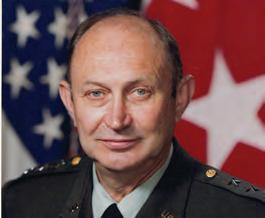
Brig. Gen. Theodore Shigeru Kanamine, the first active duty Japanese American general in the U.S. Army, died at his home in Florida on March 2, 2023, at age 93.
Born in 1929, Kanamine lived in North Hollywood, Calif., until President Franklin D. Roosevelt’s 1942 Executive Order 9066 forced his family to relocate to an internment camp. Kanamine attended law school in Nebraska and married his wife, Mary Stuben, in 1954 across the border in Iowa because Mary was White and interracial marriages were illegal in Nebraska at the time.
Kanamine joined the Army in 1955 and was commissioned as a second lieutenant
in the Military Police Corps. He served in Korea and Vietnam, the latter as an aide to Gen. Creighton Abrams. He led the 716th Military Police Battalion in charge of Saigon’s security. Returning to the United States, he led an inquiry into the 1968 My Lai massacre and later researched the Army’s use of Agent Orange. In 1976, he was promoted to brigadier general, becoming the Army’s first active service Asian American to attain the rank of general. He retired in 1981 as chief of staff of the First Army at Fort Meade, Md., and was awarded the Distinguished Service Medal, one of six medals he earned in his career. In a 2012 interview with Discover Nikkei, Kanamine reflected, “I believe in the philosophy of ‘Duty—Honor—Country.’”
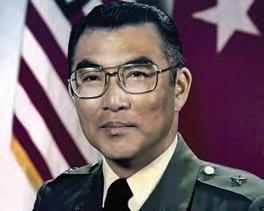
CLOCKWISE FROM TOP LEFT: ALMA E. HERNANDEZ/FOR THE EXPRESS-NEWS; U.S. ARMY (BOTH)
12
VIEP-230700-INTEL.indd 12 4/21/23 9:07 AM
VIETNAM


B_I_V = Live Area: 7 x 9.75, 1 Page, Installment, Vertical Price ❏ Logo Address ❏ Job Code ❏ Tracking Code ❏ Yellow Snipe ❏ Shipping Service ❏ Commemorate years of distinguished service and pride for America with the “United States Veteran” Personalized Commemorative Ring. Available only from The Bradford Exchange, this custom-crafted jewelry exclusive proudly pays tribute to those who have served with a personalized display of patriotism. A Masterful Achievement in Craftsmanship and Design Our “United States Veteran” Personalized Commemorative Ring is individually crafted and lavishly plated in sterling silver with rich 18K gold-plated accents, and features a hand-enameled American flag surrounded by gleaming stars and “UNITED STATES VETERAN.” Each side of the ring is expertly sculpted with a symbolic American Eagle design. Adding to the meaning and value, the ring is also engraved inside the band with “Proud to Have Served,” and personalized for FREE with your military rank and name (up to 20 characters). A Remarkable Value with Your Satisfaction Guaranteed Available in men’s whole and half sizes 8-15, this magnificent ring is available at just $119.99*, and you can pay for it in 4 easy installments of $30.00. A meaningful keepsake for yourself or a thoughtful gift for a veteran in your life, the ring arrives in a custom presentation case with a Certificate of Authenticity. To reserve yours, backed by our 120-day guarantee, just mail the attached Priority Reservation today! Proud to Have Served! Order Today at bradfordexchange.com/34159 UNITED STATES VETERAN Personalized Commemorative Ring A Commemorative Jewelry Exclusive from The Bradford Exchange FREE Personalization withYourMilitaryRankandName! Features a Hand-enameled American Flag and Sculpted American Eagle Design Hand-crafted and Lavishly Plated in Sterling Silver with Rich 18K Gold-plated Accents Engraved Inside Band with “Proud to Have Served” Along with Your Military Rank and Name! ★ ★ ©2020 The Bradford Exchange 01-34159-001-BI *Plus a total of $9.98 shipping and service (see bradfordexchange.com). Please allow 4-6 weeks for delivery of your jewelry after we receive your initial deposit. Sales subject to product availability and order acceptance. Signature Mrs. Mr. Ms. Name (Please Print Clearly) Address City State Zip Email PRIORITY RESERVATION SEND NO MONEY NOW LIMITED-TIME OFFER Reservations will be accepted on a first‑come, first‑served basis. Respond as soon as possible to reserve your ring. 01-34159-001-E39571 The Bradford Exchange P.O. Box 806, Morton Grove, IL 60053-0806 Uniquely Designed. Exclusively Yours. Please reserve the “United States Veteran” Personalized Commemorative Ring for me as described in this announcement, as engraved below Ring Size_____ (If Known) Satisfaction Guaranteed! To assure a proper fit, a ring sizer will be sent to you after your reservation has been accepted. Connect with Us! Name: (max 20 characters). Yes! VIE-230523-011 The Bradford Exchange - Commemorative Ring.indd 1 3/31/2023 7:50:36 AM
FIREBASES
WHAT WAS THE CONCEPT BEHIND FIRE SUPPORT BASES IN VIETNAM?
By David T. Zabecki
TACTICS
Vietnam was a non-linear war. There were no front lines with enemies on one side and friendlies on the other. Tactical problems could become very complex, with the enemy potentially in any or all directions. It was vital to be able to observe and fire 360 degrees all-around. Although atypical of most 20th-century warfare, those conditions were not necessarily unique to military history. Perhaps the closest American experience was the Indian Wars of the 19th century—with isolated forts established to control certain areas and provide security to overland travel routes and civilian settlements in the sector. One solution to the Vietnam War tactical problem was the fire support base (or firebase). Most 19th-century forts were isolated and had to be self-sufficient. Thanks to 20th-century technology, the firebases used by the allies in Vietnam could communicate with each other instantly and could be resupplied and reinforced by air.
The fire support base was a combined infantry-artillery position that sometimes included armor. Depending on the planned duration of the position, firebases could be dug-in heavily and reinforced with engineer assets. Perhaps the greatest strength of the firebases was their ability to cover each other with mutually supporting fires over great distances. It is a long-standing principle of firepower that massing fires is the most effective way to use artillery. Through the 19th century, the only way to mass fires was to physically group the guns together on the ground. Between World Wars I and II, improved communications combined with innovative advances in fire direction control techniques made it possible to mass fires instantly on enemy targets from many widely-dispersed guns. Firebases could reinforce the fires of their own internal guns with the guns of any or all other firebases within artillery range. It was a powerful multiplier effect.
The size, composition, and positional duration of a firebase depended on the planning factors of mission, enemy, terrain, and troop availability. Some firebases were very large and held positions for months or longer. Other fire-
bases were relatively small and remained in position for days or weeks. A smaller firebase might consist of a company of infantry with a two-gun artillery platoon in the center of the position. A larger firebase might consist of two or three infantry companies, or possibly an entire battalion. The artillery would consist of an entire six-gun battery. Instead of being positioned in the normal staggered line, the guns were deployed in a star position, with the base piece at the center and the other five guns forming the points of the star to provide rapid and effective fire in any direction. Smaller firebases with two or four howitzers deployed their guns when possible in square or triangle formations. Firebases on flatter terrain were usually round, and those on ridges generally were rectangular due to terrain. Most larger firebases contained a helicopter landing pad for resupply and medical evacuation. When a firebase deployed forward, the guns often were moved by air.
The firebases were not merely passive defensive positions. Infantry patrols aggressively pushed out from the perimeter, day and night, but usually stayed within the guns’ maximum effective range fan—roughly 11,000 meters for 105mm howitzers and 14,000 meters for 155mm howitzers. When a patrol made contact, it could call for fire support not only from the guns of its own firebase but those of any other firebase in range.
The firebases, of course, invited attack. One gun inside the firebase usually fired illumination rounds to deprive attackers of the cover of darkness. Other guns delivered fires where needed outward from the perimeter. Firing close to friendly troops could be complex because of the large bursting radius of HE ammunition. The solution to that problem was the M-546 Antipersonnel Round for the 105mm howitzer. Popularly called the “Beehive Round,” it fired 8,000 steel flechettes, triggered by a time fuze set to detonate just outside the perimeter. A green star cluster hand flare fired just before the Beehive warned troops on the perimeter to take cover.
Between 1961 and 1973, U.S. and allied forces established more than 8,000 fire support bases in Vietnam; only a small fraction existed at any given time. Some of the war’s fiercest battles were fought over firebases, including Firebase Ripcord in Thua Thien Province (July 1-23, 1970); Firebase Mary Ann in Quang Tin Province (March 28, 1970); and Firebase Gold in Tay Ninh Province (March 21, 1967). Neither the VC nor the NVA ever managed to overrun a U.S. forces firebase. V
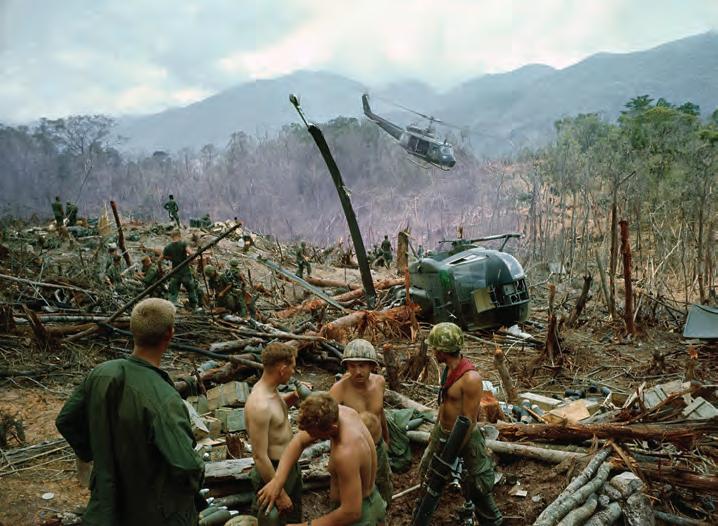
BETTMANN/GETTY IMAGES
14 VIETNAM
Similar to the 19th-century fort concept, fire support bases in Vietnam could reinforce each other across long distances with powerful effects.
VIEP-230700-TACTICS.indd 14 4/21/23 9:29 AM
You can’t always lie down in bed and sleep. Heartburn, cardiac problems, hip or back aches – and dozens of other ailments and worries. Those are the nights you’d give anything for a comfortable chair to sleep in: one that reclines to exactly the right degree, raises your feet and legs just where you want them, supports your head and shoulders properly, and operates at the touch of a button.


Our Perfect Sleep Chair® does all that and more. More than a chair or recliner, it’s designed to provide total comfort. Choose your preferred heat and massage settings, for hours of soothing relaxation. Reading or watching TV? Our chair’s recline technology allows you to pause the chair in an infinite number of settings. And best of all, it features a powerful lift mechanism that tilts the entire chair forward, making it easy to stand. You’ll love the other benefits, too. It helps with correct spinal alignment and promotes back pressure relief, to prevent back and muscle pain. The overstuffed, oversized biscuit style back and unique seat design will cradle you



OVER 100,000 SOLD
OVER 100,000 SOLD







in comfort. Generously filled, wide armrests provide enhanced arm support when sitting or reclining. It even has a battery backup in case of a power outage.

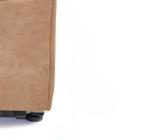




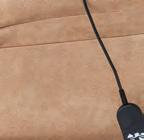

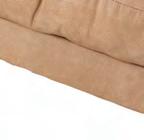



White glove delivery included in shipping charge. Professionals will deliver the chair to the exact spot in your home where you want it, unpack it, inspect it, test it, position it, and even carry the packaging away! You get your choice of Luxurious and Lasting Miralux, Genuine Leather, stain and liquid repellent Duralux with the classic leather look, or plush MicroLux microfiber, all handcrafted in a variety of colors to fit any decor. Call now!
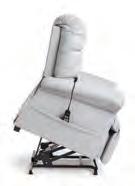



1-888-730-4237
Please mention code








“To you, it’s the perfect lift chair. To me, it’s the best sleep chair I’ve ever had.”
— J. Fitzgerald, VA
3CHAIRS IN ONE: SLEEP/RECLINE/LIFT
46642 Because
bedding product it cannot be returned, but if it arrives damaged or defective, at our option we will repair it or replace it. Delivery only available in contiguous U.S. © 2023 Journey Health and Lifestyle. ACCREDITED BUSINESS A+ enjoying life never gets old™ mobility | sleep | comfort | safety REMOTE-CONTROLLED EASILY SHIFTS FROM FLAT TO A STAND-ASSIST POSITION Now available in a variety of colors, fabrics and sizes.
each Perfect Sleep Chair is a made-to-order
MicroLux™ Microfiber breathable & amazingly soft New & Improved Long Lasting DuraLux™ stain & liquid repellent Genuine Leather classic beauty & style Chestnut VIE-230523-015 Journey Health & Lifestyle Perfect Sleep Chair.indd 1 3/31/2023 7:17:43 AM
Pictured is Luxurious & Lasting Miralux™. Ask about our 5 Comfort Zone chair.
Lots of Gas
KC-135s carried enough fuel to fill up eight F-111s or 10 F-4s.
Takeoff Power
Flexible Fueler
The refueling boom could have “basket” attachments for “drogue-andprobe” refuelers.
THE KC-135 STRATOTANKER
By Carl O. Schuster
In late August 1972, a KC-135 responded to a “mayday” call from a heavily damaged F-4D Phantom rapidly losing fuel. The tanker turned toward the fighter, guided it to rendezvous, and started pumping more fuel than the Phantom was losing. The fighter landed safely 30 minutes later. That unidentified Phantom pilot was one among hundreds saved by aerial refueling during the Vietnam War. Unheralded but not unappreciated, America’s tanker crews delivered over 1.6 billion gallons of jet fuel to the attack aircraft, bombers, and fighters of the war. The U.S. Air Force’s KC-135 Stratotanker provided most of that fuel.
ARSENAL
The KC-135 is based on the Boeing 707-80 commercial airline flight demonstrator. Boeing submitted a tanker variant as part of its bid for the Strategic Air Command’s (SAC) 1954 contract for a jet-powered aerial refueling aircraft. Although it lost the bid to Lockheed, Boeing’s mature manufacturing process, lower cost, and Lockheed’s production delays led the Air Force to order Boeing’s tanker. The first KC-135A entered service in June 1957. The last production model left the factory in 1966.

Its swept wings had four engine nacelles mounting Pratt and Whitney J-57-P-59W engines that used water injection to boost thrust during takeoff. It carried 187,500 lbs (31,250 gallons) of fuel in six wing and four fuselage tanks. The boom operator would “fly” the boom to the receiving aircraft’s fuel receptacle or probe. Its boom aft could have a special shuttlecock-shaped drogue mounted to refuel aircraft that require refueling by drogue-and-probe.
Initially intended to support only SAC operations, the KC-135 became the tanker of choice in Indochina as mission distances and Hanoi’s air defenses made in-air refueling critical to aircraft survival. Vietnam effectively became the world’s first “tanker war.” Over 100 KC-135s served in Vietnam, flying 194,687 sorties and conducting 813,878 refuelings. The KC-135 has undergone extensive avionics, communications, and engine upgrades since Vietnam. It is one of the few aircraft to pass the 60-years-of-service milestone and is expected to continue refueling America’s military aircraft through this decade. V
Designation:
KC-135A
Crew: 4
Length: 136ft 3in
Wingspan: 130ft 10in
Max Takeoff Weight: 135,000kgs/ 297,600lbs
Propulsion: 4 x PW
J-57-P-59W jet engines
Thrust: 4 x 13,750lbs (for takeoff)
Top Speed: 601mph/522.25kts
Cruise Speed: 552mph/479.7kts
Max Range: 4,000miles/3,478nm
Operational Ceiling: 40,000ft
Max Fuel for Delivery: 181,000lbs/ 30,000gallons
16 VIETNAM ILLUSTRATION BY GREGORY PROCH
Four J-57s generated 55,000 lbs. of thrust at takeoff. Guided Boom Winglets enabled the boom operator to “fly” a refueling probe to a receiving aircraft’s receptacle.
VIEP-230700-ARSENAL.indd 16 4/21/23 7:57 AM
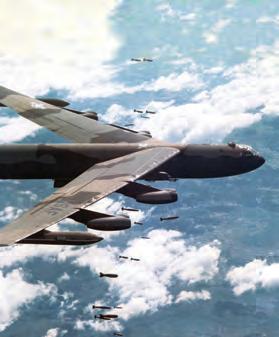



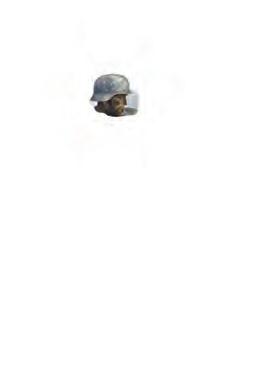




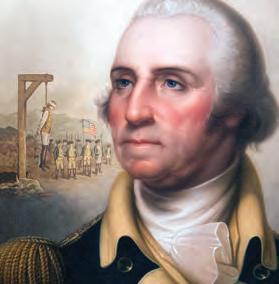

The Day the War Was Lost It might not be the one you think Security Breach Intercepts of U.S. radio chatter threatened lives 50 th ANNIVERSARY LINEBACKER II AMERICA’S LAST SHOT AT THE ENEMY First Woman to Die Tragic Death of CIA’s Barbara Robbins HOMEFRONT the Super Bowl era WINTER 2023 WINTER 2023 Vicksburg Chaos Former teacher tastes combat for the first time Elmer Ellsworth A fresh look at his shocking death Plus! Stalled at the Susquehanna Prelude to Gettysburg Gen. John Brown Gordon’s grand plans go up in flames MAY 2022 In 1775 the Continental Army needed weapons— and fast World War II’s Can-Do City Witness to the White War ARMS RACE THE QUARTERLY JOURNAL OF MILITARY HISTORY WINTER 2022 H H STOR .COM JUDGMENT COMES FOR THE BUTCHER OF BATAAN THE STAR BOXERS WHO FOUGHT A PROXY WAR BETWEEN AMERICA AND GERMANY PATTON’S EDGE THE MEN OF HIS 1ST RANGER BATTALION ENRAGED HIM UNTIL THEY SAVED THE DAY JUNE 2022 JULY 3, 1863: FIRSTHAND ACCOUNT OF CONFEDERATE ASSAULT ON CULP’S HILL H In one week, Robert E. Lee, with James Longstreet and Stonewall Jackson, drove the Army of the Potomac away from Richmond. H THE WAR’S LAST WIDOW TELLS HER STORY H LEE TAKES COMMAND CRUCIAL DECISIONS OF THE 1862 SEVEN DAYS CAMPAIGN 16 April 2021 Ending Slavery for Seafarers Pauli Murray’s Remarkable Life Final Photos of William McKinley An Artist’s Take on Jim Crow “He was more unfortunate than criminal,” George Washington wrote of Benedict Arnold’s co-conspirator. No MercyWashington’s tough call on convicted spy John André HISTORYNET.com February 2022 CHOOSE FROM NINE AWARD - WINNING TITLES Your print subscription includes access to 25,000+ stories on historynet.com—and more! Subscribe Now! HOUSE-9-SUBS AD-11.22.indd 1 12/21/22 9:34 AM
COMPUTERS IN VIETNAM
THE FADAC WAS USED TO CALCULATE ARTILLERY FIRING DATA. WAS IT ONE OF THE FIRST PERSONAL COMPUTERS?
By Paul Ingevaldson
REFLECTIONS
The next time you talk to someone of a younger generation about the war, you can rightfully tell them that we actually used computers in Vietnam. It was my job to repair them. I believe the FADAC computer was the first standalone digital computer ever used by the Army in a combat environment. The FADAC was developed to be used in the field to compute artillery firing data. It was supposed to replace the manual process used at the time to set the guns. It even had the capacity to enter weather information collected by weather balloons.

I was drafted into the Army on July 3, 1968. I had been working as a computer programmer for Sears, Roebuck and Co. I was initially assigned to radio repair school at Fort Sill, Okla., for advanced training and was then assigned to the Staff and Faculty Battalion, where I was introduced to the FADAC. Once I learned how to use the new machine, it became my job to train Army personnel to use it, primarily officers on their artillery rotation at Fort Sill. In May 1969, I was assigned to the 1st Cavalry Division in Phouc Vinh, Vietnam, as a FADAC computer repairman.
As stated by the Army, the purpose of artillery automation is to “make fire support more responsive, effective, and accurate and to minimize human error,” which led to automating gunnery with “the electromechanical M15 Gun Data Computer in the 1950s and later the electronic digital M18 Field Artillery Digital Automatic Computer (FADAC) in the 1960s.” The operator entered the gun and target locations and the computer told you
the correct settings. The FADAC was mobile to a certain extent but weighed over 200 pounds and had a heavy case plus a table and generator to provide power. In 1957, the Army specified that the FADAC “would be designed to operate under severe field conditions without a major overhaul for 2,500 hours” and “would be easily maintained and operated,” among other things.
The first FADAC we repaired in Vietnam was hit by shrapnel that evening and was sent to Saigon. We received a steady flow of computers to repair at Phouc Vinh afterwards. In most cases, the problems were loose circuit boards, filters hopelessly clogged with dirt and sand, or circuit boards made totally inoperable due to non-functioning filters. Over the years I’ve talked with a lot of artillerymen who for the most part have told me that “Freddie” FADAC was totally useless, since they could calculate the firing settings faster using the manual method. I also heard it was used for the larger 8-inch guns and not for the 105s and 155s since it was easier to fire a first shot more quickly and then adjust. The larger shells required more accuracy due to their killing radius. This comment also seems to imply that the FADAC may have been more accurate.
My two trips out to FSB Buttons and LZ Jaime in 1970 to repair the FADACs there verified that there were training issues. In one case the filters were so clogged that the machine overheated and would not work. In the other case, the power cables to the generator crossed a path used by vehicles, leaving the cables hopelessly frayed. Some people also complained that the generator was very loud and could be targeted by enemies outside the wire. Others admitted they used it as a coffee table.
There is little doubt that the FADAC was not correctly designed for life in the bush. It was heavy, required a dust-free environment, constant maintenance, and a certain level of training in those early days of computerization. We could perhaps say that this was one of the first personal computers. What a place to test the concept!
I have no axe to grind with the people who tried to use the FADAC. They had a much tougher job than I did. As a draftee, I did what I was told in the best way I could, considering the
Do you have reflections on the war you would like to share? Email your idea or article to Vietnam@historynet.com, subject line: Reflections
18 VIETNAM PHOTO COURTESY OF PAUL INGEVALDSON
Author Paul Ingevaldson is shown working on an M18 Field Artillery Digital Automatic Computer (FADAC) used for gun targeting in Vietnam.
VIEP-230700-REFLECTIONS.indd 18 4/21/23 9:27 AM
Honor Their Sacrifice!
50th Anniversary Salute to our Vietnam Veterans
KEY DETAILS
50TH ANNIVERSARY TRIBUTE: Commemorates the 50TH anniversary of Operation Homecoming in 1973. This event, the beginning of the release of American Prisoners of War, came to represent a welcome home for all who had served in the Vietnam con ict.





EXCLUSIVE RELEASE: This historic 50TH anniversary tribute is only available from The Bradford Exchange Mint. Due to expected strong demand, only the earliest applicants will be able to successfully secure this meaningful Proof coin.

ALL-NEW DESIGN: Intended as a collectors’ item, this exclusive commemorative is offered in coveted Proof condition. Fully 99.9% Silver plated, it features historic photographic imagery of service members cheering as their plane takes off on the front, plus vivid selective printing recalling the Vietnam service ribbon. A golden privy mark adds to its stature. The back showcases a U.S. soldier holding a U.S. ag.


SECURED AND PROTECTED: Your Proof arrives sealed in a crystal-clear capsule for enduring protection for years to come.
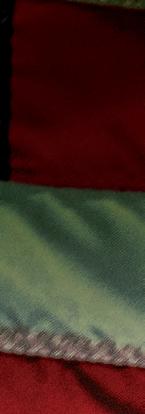
1973: THE YEAR COURAGE CAME HOME
I n 1973, just over 50 years ago, an unusual, peaceful, series of ights departed the longdisputed skies of Vietnam. We honor and appreciate the U.S. POWs and all Vietnam Veterans who sacri ced everything for our country. Known as “Operation Homecoming,” these ights restored these long-lost servicemen to their country and families. e positive response the returnees received sparked a transition in public opinion. As recognition of their heroism and courage grew, so did respect for all those who had answered our country’s call to service. Now e Bradford Exchange Mint salutes the undaunted spirit of America’s Vietnam veterans with the exclusive Vietnam Homecoming 50TH Anniversary Proof Coin. is exclusive, 99.9% Silver plated tribute begins with historic photographic imagery portraying joyful former POWs on their long-awaited ight home. Selective full-color accents recall the vivid hues of the U.S. Vietnam service ribbon. A golden “USA” privy mark accents the design. Proof-quality coining dies create its polished, mirror-like elds and raised, frosted images. It arrives secured in a crystal-clear capsule.





A superb value …100% guaranteed.





Acquire yours now at the $49.99* price, payable in two installments of $24.99 each. As always, it is backed by our unconditional, 365-day guarantee. is could be your only opportunity to preview e Vietnam Homecoming 50th Anniversary Proof Coin as well as additional issues in e Vietnam Homecoming 50th Anniversary Proof Coin Collection. Issues will arrive about once a month at the same price. You need send no money now, and you may cancel at any time. It is never too late to remember those who gave so much. So act now.

ACT TODAY AT BRADFORDEXCHANGE.COM/VIETNAM50
The Bradford Exchange Mint

9307 Milwaukee Avenue · Niles, IL 60714-9995




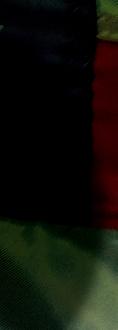









YES. Please send The Vietnam Homecoming 50th Anniversary Proof Coin for my review as described in this announcement. I need send no money now. I will be billed with shipment. I am under no obligation. I understand that I can return my item free of charge.
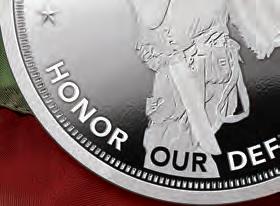
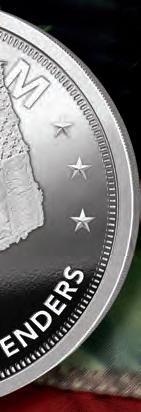
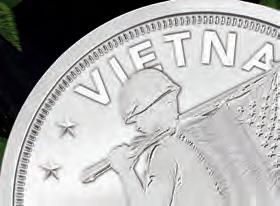
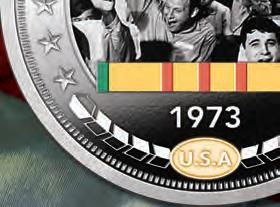

B_I_V = Live Area: 7 x 10, 7x10 Magazine Master, 1 Page, Installment, Vertical updated 11/2013
PLEASE RESPOND PROMPTLY SEND NO MONEY NOW ©2023 BGE 01-39035-001-BD23 e Bradford Exchange Mint is not a liated with the U.S. Government or U.S. Mint
Name (Please Print Clearly) Address City State Zip E-mail (optional)
*Plus $6.99 shipping and service per coin. Please allow 4-8 weeks for delivery of your rst coin. Sales subject to product availability and request acceptance. This could be your only opportunity to preview the rst issue in The Vietnam Homecoming 50th Anniversary Proof Coin Collection with the opportunity to collect future issues. You’ll also receive a deluxe wooden display box — FREE! You may cancel at any time.
Mrs. Mr. Ms.
923725-E39571
Shown larger than actual size of 38.6mm diameter
99.9% Silver plated is ne collectible is not legal tender and bears no monetary face value. Design subject to change
MINTED IN THE USA
Iconic Fully Sculpted Portrait of U.S. soldier with ag
Selectively colored accents recall the Vietnam War Service Ribbon
VIE-230523-009 The Bradford Exchange Vietnam Homecoming Coin.indd 1 4/10/2023 11:42:27 AM
Historic photographic imagery of returning service members
circumstances. I did not fully appreciate that this was one of the first—if not the first—use of a small computer in combat. Needless to say, the rollout and usage was not the best—but that often happens when a concept is brand new.
The Fallen Temple
By Jerry Dallape
Phu Bai was a raw, unpolished Marine Corps base. Many of the structures were only tents or dilapidated buildings. The airport could handle jets, but all the facilities were primitive. Our “home sweet home” was two or three rows of plywood and screened-in buildings with tin roofs.
his sign on the door “reserved” the place for him or not. So I did. But once I opened the door, the avenging angel materialized—Gunnery Sergeant Johnson himself, standing there right outside, glowering at me. He yelled at me for using his bathroom and demanded that I pull out the catch tank and burn the contents. The way that these bathrooms worked is that there was a barrel under the seat which was removed after use, doused with diesel, and burned. The indignant Gunny wanted me to remove all traces of my presence.
I apologized to the Gunny and assured him I would take care of the matter. He still wasn’t a happy Marine. I began cleaning up—as the Gunny posted one of his sergeants nearby to watch me do the job. I had everything under control. I pulled the barrel out, poured on a large volume of diesel, and threw in a match. The whole embarrassing situation was vanishing in a puff of black smoke when a helicopter came in for a landing, throwing red dust and dirt all over the place. The Gunny’s minion standing over me decided my job was done—or at least he did not like the dirt and dust, so he scurried back to his dingy little office.
I decided I had had enough. The red dust was heavy and was getting into my eyes, and the fire had gone out. I pushed everything back in place and closed the outhouse door. My debt to Gunny Johnson was paid in full. That was the end of the matter—or at least it should have been.
I called the Gunny everything I could think of in both English and Vietnamese as Gustafson and I continued our stroll to the PX. But since Gus and I were out of the field we were determined to enjoy ourselves here, Gunny or no Gunny. The PX was a fun place to go. Rear echelon people thought it was terrible because there were so few items in the store from which to choose, but Gustafson and I had a great time shopping. It had been a month since we had drunk soda. After rummaging through candy, stacks of soda, and things we had little access to, we each bought a case of Pepsi and a few other items. Then we started back to our hooch.
Each building had room for 15 cots. The living conditions were very poor, but it beat being in the field and sleeping on the ground. We didn’t have to worry much about being shot here. On the other side of the base, there was a PX that sold cases of soda and other necessities.
On Sept. 28, 1967, my friend Gordon “Gus” Gustafson and I decided we would walk the halfmile to the PX and buy some goodies. There wasn’t a road. We just walked over rolling hills dotted with various buildings and tents. The ground was dry and dusty with a distinctive red-colored dust. Our mood was light as we walked and talked. It was nice to be out of the field and in the relative safety of the base…but everyone that spends time in the field has diarrhea at one time or another, and mine was calling now. When it calls, you go.
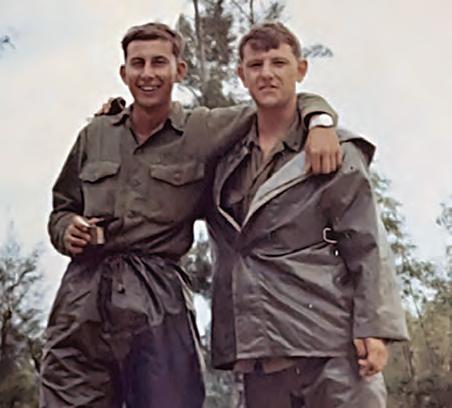
We happened to be walking past a plywood bathroom. I saw a sign on its door that read: GUNNY JOHNSON ONLY. Well, that was too bad for Gunny Johnson—I had to go, whether
We were happy and our conversation turned to our homes back in the States and what we planned to do when we first got back. Our minds were miles away. By this time I had almost forgotten about the outhouse mishap and the way that Gunny Johnson had lorded over his pathetic bathroom.
As we came over the crest of a small hill, I got the shock of my life. Gustafson stopped in his tracks. What had been a well-kept outhouse was now a smoldering pile of ashes. The outhouse had apparently caught fire and burned to the ground. I realized the barrel must have still been burning when I kicked it back in its place.
We just stared in stunned silence for a few seconds. Then Gustafson said: “Oh, my God! You burned down Gunny Johnson’s shitter!”
Suddenly I wanted to be back in the field. In an instant that seemed safer than being here. Still, the odds of escape were good—the Gunny had no idea who I was. He had never seen me before I used his bathroom and in his fit of outrage he had not bothered to ask me to identify myself. Also, thankfully he was nowhere in sight.
We took a very long route to avoid passing anywhere near the “fallen temple.” Once we returned to the safety of our hooch, we couldn’t stop laughing. If he could have found out who I was, he probably would have killed me. V
Jerry Dallape served as an M-60 machine gunner in Fox company 2/26 Marines, 3rd Marine Division. The above is an edited excerpt derived from his book, Vietnam Guns and Fury
20 VIETNAM PHOTO COURTESY OF JERRY DALLAPE
VIEP-230700-REFLECTIONS.indd 20 4/21/23 9:27 AM
Author Jerry Dallape (right) and his buddy Gordon “Gus” Gustafson had an unusual adventure in Vietnam.
Now, THIS is a Knife!
EXCLUSIVE FREE
In the blockbuster film, when a strapping Australian crocodile hunter and a lovely American journalist were getting robbed at knife point by a couple of young thugs in New York, the tough Aussie pulls out his dagger and says “That’s not a knife, THIS is a knife!” Of course, the thugs scattered and he continued on to win the reporter’s heart.
Our Aussie friend would approve of our rendition of his “knife.” Forged of high grade 420 surgical stainless steel, this knife is an impressive 16" from pommel to point. And, the blade is full tang, meaning it runs the entirety of the knife, even though part of it is under wraps in the natural bone and wood handle.
Secured in a tooled leather sheath, this is one impressive knife, with an equally impressive price.

This fusion of substance and style can garner a high price tag out in the marketplace. In fact, we found full tang, stainless steel
blades with bone handles in excess of $2,000. Well, that won’t cut it around here. We have mastered the hunt for the best deal, and in turn pass the spoils on to our customers. But we don’t stop there. While supplies last, we’ll include a pair of $99, 8x21 power compact binoculars, and a genuine leather sheath FREE when you purchase the Down
Under Bowie Knife
Your satisfaction is 100% guaranteed. Feel the knife in your hands, wear it on your hip, inspect the impeccable craftsmanship. If you don’t feel like we cut you a fair deal, send it back within 30 days for a complete refund of the item price.
Limited Reserves. A deal like this won’t last long. We have only 1120 Down Under Bowie Knives for this ad only. Don’t let this beauty slip through your fingers at a price that won’t drag you under. Call today!
Down Under Bowie Knife $249*
Stauer® 8x21 Compact Binoculars

-a $99 valuewith purchase of Down Under Knife
BONUS! Call today and you’ll also receive this genuine leather sheath!

Offer Code Price Only $99 + S&P Save $150

1-800-333-2045

Your Insider Offer Code: DUK369-01
You must use the insider offer code to get our special price.

Stauer ®
What
Stauer Clients Are Saying About Our Knives



“This knife is beautiful!”
— J., La Crescent, MN
“The feel of this knife is unbelievable...this is an incredibly fine instrument.”
— H., Arvada, CO
Rating of A+
14101 Southcross Drive W., Ste 155, Dept. DUK369-01
Burnsville, Minnesota 55337 www.stauer.com
*Discount is only for customers who use the offer code versus the listed original Stauer.com price.
California residents please call 1-800-333-2045 regarding Proposition 65 regulations before purchasing this product.
•Etched stainless steel full tang blade ; 16” overall • Painted natural bone and wood handle • Brass hand guards, spacers & end cap • Includes genuine tooled leather sheath
Stauer… Afford the Extraordinary ®
This 16" full tang stainless steel blade is not for the faint of heart —now ONLY $99!
VIE-230523-012 Stauer Down Under Bowie Knife.indd 1 3/31/2023 7:28:53 AM
BLACK TIGERS
HOW FRENCH COMMANDOS USED DECEPTION AND DARING TO STRIKE BLOWS AT NORTH VIETNAMESE FORCES
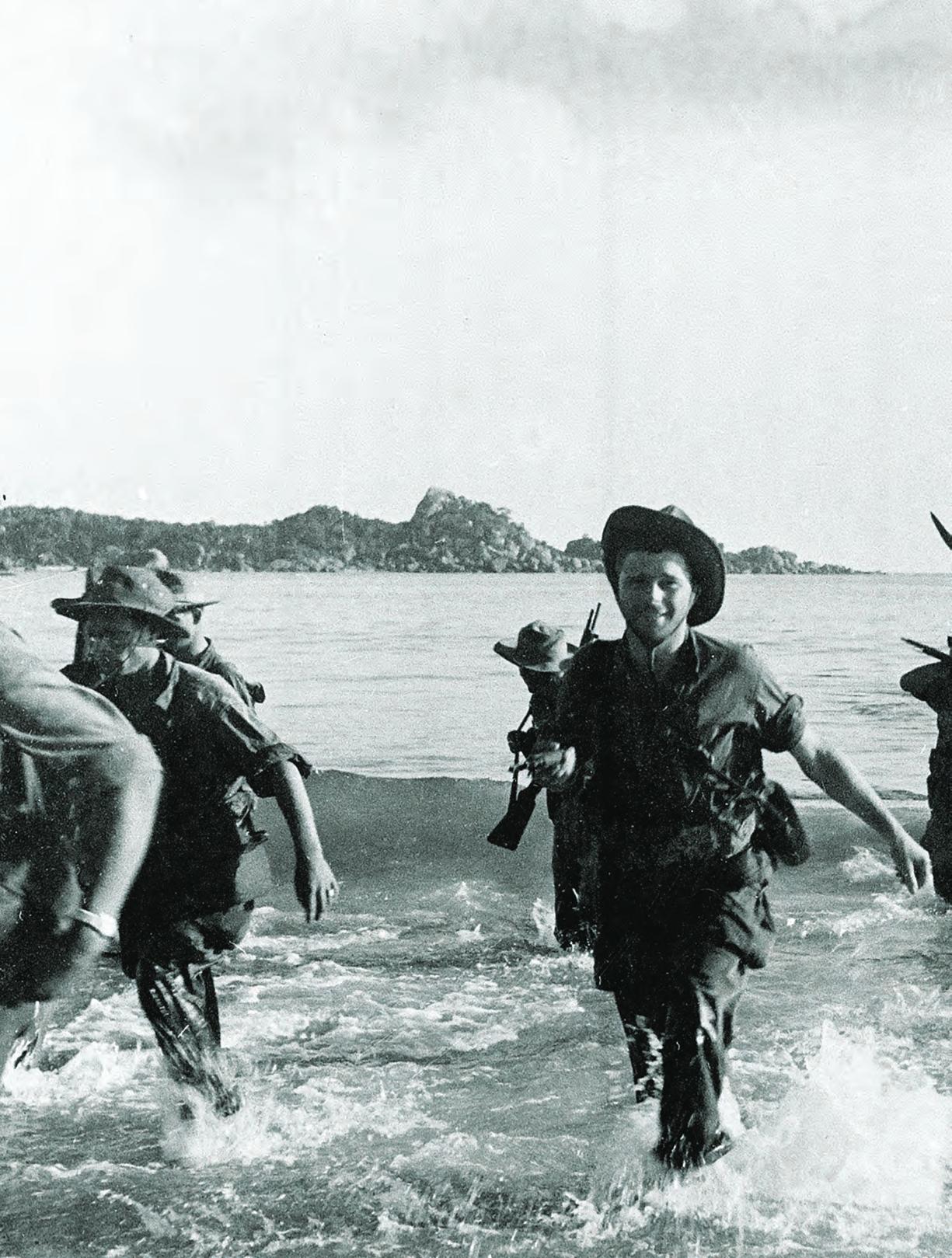 By Andrew McGregor
By Andrew McGregor
PHOTO CREDITS
VIEP-230700-BLACK TIGER.indd 22 4/21/23 10:11 AM

PHOTO CREDITS
23 SUMMER 2023 VIEP-230700-BLACK TIGER.indd 23 4/21/23 10:12 AM
Commandos of the French Expeditionary Corps come ashore in summer 1950 in Vietnam during France’s struggle against the Viet Minh. Commando operations and irregular warfare increased under the oversight of Gen. Jean de Lattre.
Sampans glide silently in the darkness over an inland waterway in North Vietnam’s Red River Delta. Five Frenchmen and 120 Vietnamese commandos are on their way to make a deep behind-the-lines raid on Ho Chi Minh’s communist Viet Minh guerrillas. Their mission involves collecting intelligence, seizing prisoners for interrogation, and sowing confusion behind enemy lines. Among these nocturnal predators are many former Viet Minh fighters captured by the French. The lone French officer and his NCOs operate in the knowledge that they may be killed by their own men at any time. This was life for the French commandos in North Vietnam from 1951 to 1954, predecessors of the American Green Berets.
When Gen. Jean de Lattre de Tassigny became commander-in-chief of the French Far East Expeditionary Corps in December 1950, French forces had been struggling for nearly six years to reestablish control over the Indochina colonies. Japanese forces had destroyed the French occupation army in 1945, leaving a postwar power void exploited by Ho Chi Minh’s Viet Minh. The arrival of de Lattre, a legendary French soldier known to his men as “King Jean,” reinvigorated the badly demoralized Expeditionary Corps.
Realizing the futility of following the old rules of combat, de Lattre cleared out incompetent officers and introduced new ideas, weapons, and tactics, including a plan to create a series of new commando groups for use in northern Vietnam. Composed almost entirely of Vietnamese troops with a few French officers or NCOs in command, these units took the war to the Viet Minh using ruthless methods and intimate knowledge of the terrain. It was a war of no quarter, fought almost exclusively at night with
knives as much as submachine guns by men disguised as the enemy—men with a special gift for killing in the dark.
Even before the World War II liberation of Paris, Free French leader Gen. Charles de Gaulle planned to reestablish French control of the Indochina colonies of Laos, Cambodia, and the three regions of Vietnam—Cochin-China in the south, the central region of Annam, and the northern region of Tonkin. In 1944, the first Free French commando groups, known as Gaurs (wild buffalo), were dropped into Japanese-occupied Laos. Torture was inevitable in cases of capture, and cyanide pills were issued regularly. Some commandos were highly trained veterans of the Free French companies of the British Special Air Service (SAS) and continued to wear the regiment’s berets.
On March 9, 1945, the Japanese Army deposed the French Vichy government in Indochina, slaughtering entire garrisons in surprise attacks. Two French Gaur groups were dropped into Tonkin by British planes to assist the withdrawal of a column of starving and bloodied French co-
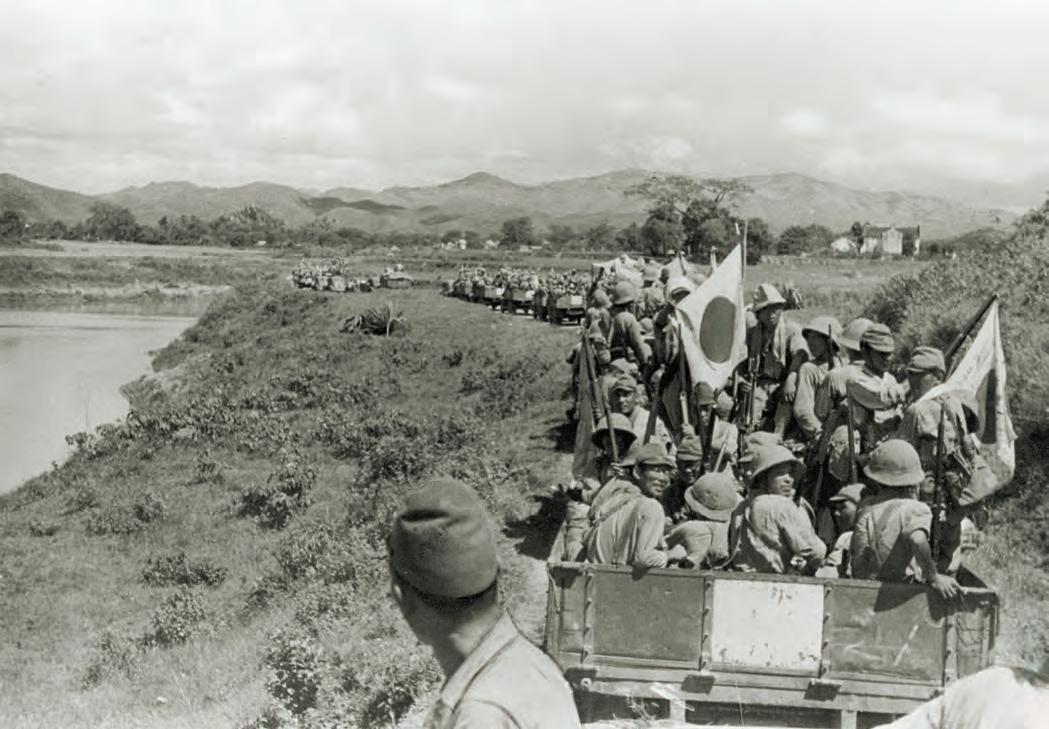
24 VIETNAM PREVIOUS SPREAD: AP PHOTO; TOP: ASAHI SHIMBUN VIA GETTY IMAGES CLOCKWISE FROM TOP LEFT: FREMANTLE/ALAMY; PICTURES FROM HISTORY/UNIVERSAL IMAGES GROUP VIA GETTY IMAGES (2)
VIEP-230700-BLACK TIGER.indd 24 4/21/23 10:12 AM
Troops of the Imperial Japanese Army march into Vietnam during World War II. The British supported Free French guerrillas while the U.S. lent aid to Ho Chi Minh’s communist forces in the fight against the Japanese.
lonial troops. Few Gaurs survived, most dying in suicidal attempts to delay the Japanese.
These early commandos were reliant on British training, transport, and equipment, as the American Office of Strategic Services (OSS, the predecessor to the CIA) initially supported Ho Chi Minh’s nationalist guerrillas over the French. This preference was in line with President Franklin D. Roosevelt’s vision of a postwar world where national self-determination would replace European imperialism.
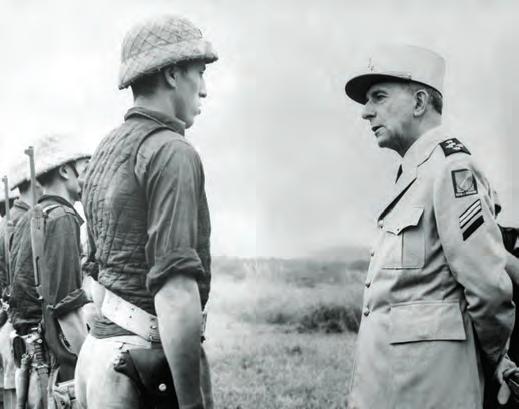
After years of bitter fighting in Vietnam’s jungles and mountains, the performance of mixed groups of French and Vietnamese commandos at the May-June 1951 Battle of Ninh Binh, also known as the Battle of the Day River, convinced de Lattre to make the commandos a formal part of the French Expeditionary Corps. When the Viet Minh’s 320th Division launched an offensive along the Day River, they were opposed by small French units holding two limestone crags at Ninh Binh. One of the peaks was held by “King Jean’s” son, Bernard de Lattre, following his father’s order to hold the French position at all costs. A mostly Vietnamese commando team led by a burly young NCO, Roger Vandenberghe, was called upon to reinforce the young lieutenant’s position by climbing the crag under heavy fire. Machine gun fire sent climbers plummeting down the cliff. Vandenberghe was eventually hit. Wounded, he signaled his second-in-command, Sgt. Tran Dinh Vy, to finish the assault. The slight but formidable Vietnamese sergeant was a former seminarian who had become a master of guerrilla tactics.
During the attack, the bleeding Vandenberghe retrieved the body of his friend, Bernard, who had become a victim of Viet Minh mortar fire. This deed endeared him to de Lattre, who was deeply
grieved by the loss of his only child. From then onward de Lattre acted as a patron to Vandenberghe, whose savage way of warfare nearly got him dismissed by French commanders who were alarmed by his methods. Days later, “King Jean,” who would later declare Vandenberghe “the greatest soldier in Indochina,” authorized the creation of formal French Army commando units. The French commandos fought brutal, no-quarter battles in a tropical darkness where the normal conventions of war held no sway.
Responsibility for organizing the commandos was handed to Louis Fourcade, commander of the 1st Battalion of Colonial Paratroopers. Fourcade spent World War II as an officer in the Vichy colonial army in Indochina, with secret contacts to Free French agents working across the border in China. He was involved in fighting the Japanese in the last months of the war. The new commando units normally included 120 Vietnamese under a European officer or senior NCO, aided by four other NCOs and at least one European radio operator. Captured Viet Minh prisoners were given the chance to avoid heavy labor by volunteering to join the new commando groups. This was a highly dangerous practice. While it recruited men intimately familiar with the enemy’s methods, it also handed arms to soldiers who might suddenly turn on their leaders at any time. Sleeping became as precarious for commando leaders as firefights with the enemy. To let one’s guard down for a minute was to invite death.
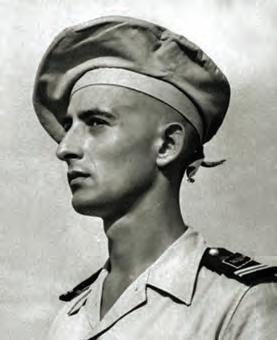
Training was carried out at the Vat Chay commando school by SAS veteran Capt. Michel Le-
Top left: Gen. Jean de Lattre de Tassigny (right), shown with Charles de Gaulle and Winston Churchill, was a famed World War II commander. Top right: Known as “King Jean,” de Lattre (right) favored commando leader Roger Vandenberghe (left), who became the leader of the fearsome “Black Tigers.” Below: De Lattre’s only child, Bernard, was killed in action at Ninh Binh. Vandenberghe recovered his remains, which endeared him to the young man’s influential father.

25 SUMMER 2023 PREVIOUS SPREAD: AP PHOTO; TOP: ASAHI SHIMBUN VIA GETTY IMAGES CLOCKWISE FROM TOP LEFT: FREMANTLE/ALAMY; PICTURES FROM HISTORY/UNIVERSAL IMAGES GROUP VIA GETTY IMAGES (2)
VIEP-230700-BLACK TIGER.indd 25 4/21/23 10:12 AM
grand. Later training of the commandos was undertaken by one of the hardest men in the French Army—Yvan Tomassi, an officer of the Colonial Paratroops and a Free French veteran of fighting in Africa and Europe. In 1950, he lost his right hand while seizing a bomb from the hands of a trainee who had mistakenly set it to explode. Rather than retire, Tomassi continued to jump. He was appointed trainer of the commandos in February 1952. Captured leading a raid in January 1953, Tomassi spent six months in a Viet Minh prison camp. Once interned he was singled out by French communist turncoat Georges Boudarel, who tried to break him by forcing him to dig all the graves for the camp with his left arm and the stump of the right. Tomassi was kept busy as 85 percent of the prisoners in Camp 113 died from torture and mistreatment while being forced to sing the praises of Ho Chi Minh. The resilient Tomassi survived and continued to serve as a paratrooper until 1966. Amazingly, the unrepentant Boudarel was hired as a professor by a Paris university after the war.
Tiger Badge

The commandos learned to fight at night. As Capt. Jean-Louis Delayen of 13 Commando recalled: “After having overcome the visceral fear of the night, and the completion of special training requiring the greatest discipline, the [Vietnamese] auxiliaries were convinced that, lightly armed as they were, only night action could allow them to dominate an adversary unaccustomed to not be the only ones operating at night.” Internal cohesion was achieved by recovering commando families living in Viet Minh-occupied zones, building schools, pagodas, and married quarters beside the commando base, and forming a “big family” at-

mosphere through the cultivation of vegetables and the raising of chickens and pigs. The commandos did not perform normal military duties such as routine patrols or guarding military posts. When necessary, they operated in conjunction with regular troops on larger military operations.
The commandos used weapons captured from the Viet Minh, including Thompson submachine guns and World War II-era Sten guns. Grenade launchers and small 50- or 60mm mortars completed the light armament of these highly mobile units. Many commandos disguised themselves in the black cotton uniform of the Viet Minh, complete with sneakers, palm helmets, and a Red Star insignia.
To gather intelligence, the commandos ventured deep into enemy territory to observe movements, take prisoners, and disrupt communist political networks. Attendees at Viet Minh meetings lived in fear of French commandos bursting in and firing their Thompson submachine guns from the waist. The commandos were taught to aim at the feet of their targets in close combat, as the Thompsons tended to jump upward with recoil when fired. In his memoir, Sgt. Bernard Gaudin of 25 Commando described a 1952 night ambush during a deep raid on the Viet Minh. Ambushes meant hours of silent misery, with uniforms soaked by an endless drizzle. The raiders’ nerves were on a razor’s edge as their eyes strained to detect movement in the inky darkness. The torment of mosquitoes was unrelenting but had to be endured noiselessly. “Canh, my faithful corporal,

26 VIETNAM TOP LEFT: INTERCONTINENTALE/AFP/GETTY IMAGES; RIGHT AND BOTTOM: HISTORYNET ARCHIVES AGS PHOTO
This cap badge, featuring the image of a gaping tiger and an anchor, was the emblem of Roger Vandenberghe’s 24 Commando unit, who were known as “The Black Tigers.” The inscription is the motto, “Rather death than shame,” or alternatively “Death before dishonor,” written in Vietnamese. Each commando unit had its own distinctive badge.
VIEP-230700-BLACK TIGER.indd 26 4/21/23 10:12 AM
Left: Leaders of French commando raiding forces were often drawn from the ranks of elite paratroopers. Right: Roger Vandenberghe, a tough Parisian orphan, joined the French Resistance and became known for his ruthless leadership of guerrilla troops.
whispers in my ear: ‘Chief, there are a lot of Viets.’ … Here we go, all the Commandos who are waiting for this break loose. We can finally cough, yell—it’s recommended. The bursts and explosions of grenades tear the night apart. Immediately, there is a pack of Viets on the mat. We hear them shouting orders to try a maneuver but we shoot at everything that moves.”
With prisoners taken and the Viet Minh column destroyed, Gaudin led his men back by a different route. The waiting Viet Minh began to rain down grenades as the commandos crossed a rice paddy. Two of Gaudin’s men were killed before fire raked the commandos from sharpshooters in the trees. A Dinassaut (armored landing craft squadron) made a welcome appearance on the river and laid down heavy fire until the shooting stopped.
The Dinassaut were squadrons of surplus American shallow-draft LCMs (Landing Craft Mechanized), modified to bring heavy firepower to support infantry and commando operations in the shallow waterways of the Red River Delta. For this, the Dinassaut deployed heavy machine guns, 81mm mortars, and even tank turrets welded onto the crafts. They saved more than one commando group and were effective enough to serve as a model for later American river operations in the south.
The commandos returned to camp, where a blazing fire enabled the start of “Operation Leech,” as the men burned off blood-engorged parasites with a cigarette, dropping them to sizzle in the flames. Gaudin’s raid yielded a treasure trove of intelligence documents, including the cipher to the Viet Minh code. At other times, however, commandos were the victims. When Commando 34 operated in support of the besieged French garrison at Dien Bien Phu in 1954, Sgt. Müller led it into a devastating ambush, losing 68 of its 107 men.

Despite the challenges, it was necessary for commando leaders to continually demonstrate physical and mental strength or risk losing the men under them. For officers of the French regular army, this dirty, stressful, and highly dangerous work was commonly viewed as more likely to lead to an early death than promotion. Leadership roles were thus open to audacious individuals who may not have graduated from the French Saint-Cyr military academy, but were capable of innovation, independent action, and, most of all, killing Viet Minh. Contrary to expectations, the experience of the surviving commando leaders propelled them rapidly through the ranks after the French withdrawal from Indochina. Men who understood this “new warfare” would be needed in Algeria.
In response to the pressure of the commandos, the ever-adaptive Viet Minh created their own counter-commando force, the Dich Van, in 1947. This covert unit was assigned the task of infiltrat-
27 SUMMER 2023 TOP LEFT: INTERCONTINENTALE/AFP/GETTY IMAGES; RIGHT AND BOTTOM: HISTORYNET ARCHIVES AGS PHOTO
VIEP-230700-BLACK TIGER.indd 27 4/21/23 10:13 AM
Captured Viet Minh are forced by French soldiers to carry radio equipment. It was common practice among the French to press-gang enemy POWs into service alongside commando troops. Acts of rebellion by former foes drawn from communist ranks were thus unsurprisingly frequent.
ing native troop formations aligned with the French Expeditionary Corps, often by intimidating the families of pro-French fighters. Dich Van propaganda teams recruited Foreign Legion deserters to persuade French Expeditionary Corps prisoners in French, German, and other European languages to adopt Marxist ideology and take up arms against their former comrades.
Lethally Simple
Both French commandos and the Viet Minh wielded the Sten gun. Although not known for reliability or accuracy, Stens were easy to assemble and required little skill to use. Favored by commandos and resistance fighters, Sten guns continued to be used in the postwar era. Stens were fielded by insurgents in Israel as well as by the Irish Republican Army.

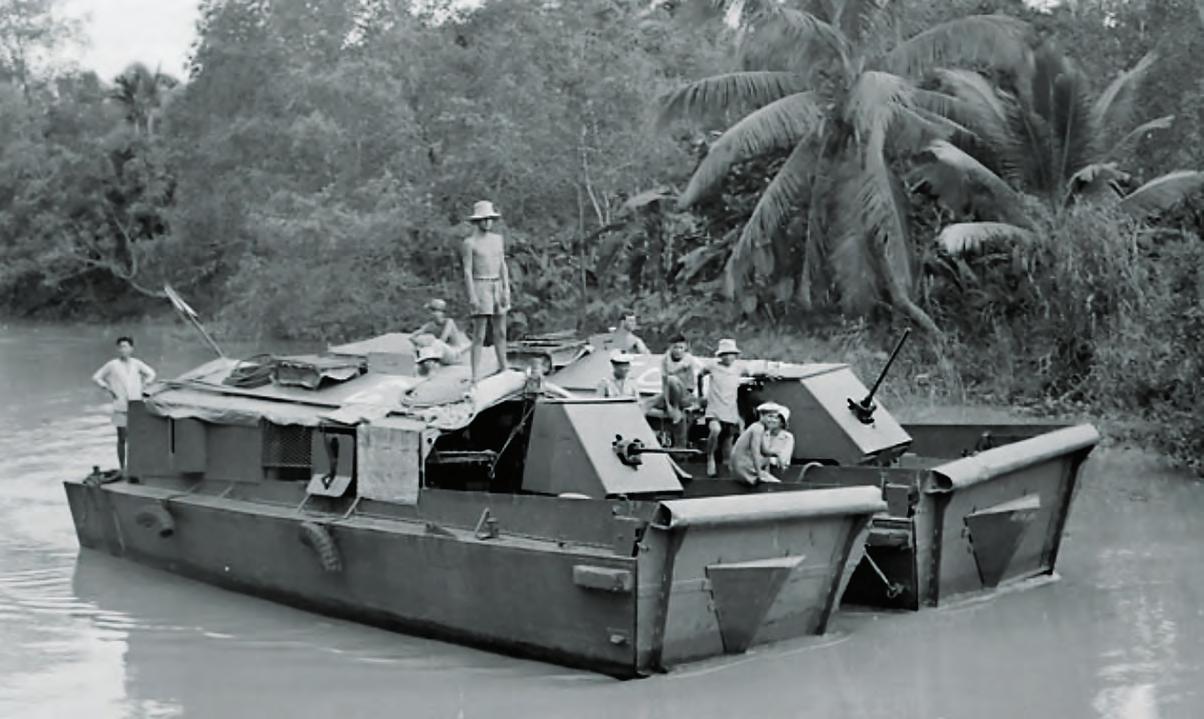
Several French commanders achieved fame in this highly unconventional form of combat, where merciless hand-to-hand fighting was the norm. One of these was a solid, thick-set Corsican lieutenant, Charles Alphonse Rusconi. For his ferocious fighting style, the Corsican was known as Le Sanglier, “the wild boar.” Rusconi began his military career in 1936 by joining the Colonial Army’s 10th Regiment of Senegalese Riflemen. He led several daring commando raids behind German lines in 1940 before being wounded and captured. Escaping two months later, he joined the French forces in Indochina in 1948, forming a commando group from Viet Minh prisoners and Black Colonial Army troops from Mali. The latter described their commander as “small, but cunning.” Through unrelenting attacks that shattered Viet Minh morale, his group battered down communist activity into a significant decline in his zone of operations. The 33-year-old Rusconi, survivor of four wounds, was killed in February 1952 when a former Viet Minh commando, influenced by the Dich Van, opened a way into the camp for a company of Viet Minh. Rusconi and most of his troops fell in vicious hand-to-hand fighting, knives, fists, and boots flailing to the last.
The most well-known commando was Roger Vandenberghe. Childhood for Roger and his younger brother, Albert, was extremely difficult. Born in a Paris slum, their father died from tuberculosis in 1939. Their mother, a Spanish Jew, was sent by Vichy authorities to a Nazi death camp. With little education, the boys joined the French Resistance as mere teenagers and later became commandos in de Lattre’s First French Army in Alsace and Germany. Vandenberghe and his brother arrived in Vietnam as part of the 6th Colonial Infantry Regiment. He was immediately taken with the country, a place far different from the crowded tenements of Paris. Already decorated with the Croix de Guerre for his Resistance work, Vandenberghe quickly made sergeant in command of a unit of Vietnamese auxiliaries that became 24 Commando, “The Black Tigers.”
Vandenberghe’s nemesis was Chapuis, a former French paratrooper who deserted to the communists. In June 1948, Chapuis killed Albert, Vandenberghe’s only family in the world. The deserter was captured by Vandenberghe in 1951 and sent to the French post at Nam Dinh, where he escaped.
Vandenberghe’s most famous exploit came when one of his turned commandos revealed the location of a Viet Minh command post. Vandenberghe allowed himself to be bound as a prisoner
28 VIETNAM TOP: NAVAL HISTORY AND HERITAGE COMMAND; BOTTOM: MCCOOL/ALAMY TOP: TEXAS TECH VIETNAM CENTER AND ARCHIVE; BOTTOM: CLAUDE THOMMERET
VIEP-230700-BLACK TIGER.indd 28 4/24/23 11:02 AM
A Dinassaut “floating fortress” consisted of surplus American LCMs modified with machine guns, mortars, and sometimes welded turrets to provide supporting fire from shallow river canals for commando operations.
and carried along by his men in Viet Minh uniform, passing through checkpoints by insisting they were going to collect the reward on Vandenberghe’s head. Once inside the command post, Vandenberghe was released. He and his men slaughtered everyone there, seizing a valuable cache of documents and weapons.
Top: Due to their black clothing and helmets, locally recruited commando troops led by Roger Vandenberghe were intended to appear indistinguishable from the Viet Minh during covert operations. Bottom: The grave of Vandenberghe is located in Castillond’Arthez, France.
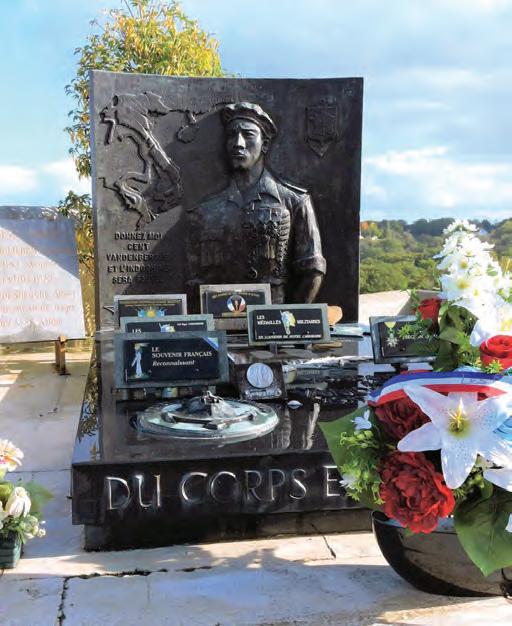
This fearsome NCO had little use for the officers of the French army but was impressed by the leadership of de Lattre, his former commander in France. He led his men 12 miles through enemy territory to see the general at a gathering in Phu Ly. The general was astonished to see this towering European in a Viet Minh uniform and helmet. Vandenberghe explained his appearance as necessary while he operated almost exclusively behind enemy lines. De Lattre was taken by this odd but unforgettable warrior, remarking a few days later: “It’s a bit as if a tiger, in addition to its fangs and claws, received a hunting license...”
Even in these conditions, Vandenberghe stood out for waging a vicious and pitiless war using methods the French command found disturbing. He drove his men hard—but any complaints were met with a reminder that, without him, his turncoat troops “would be in jail or eaten by maggots.” Desertions were frequent. Vandenberghe was shot in the back by one of his own men in 1949. After returning from medical treatment in France he became even more unrestrained. His NCOs struggled to keep him in check, especially in his dealings with the civilian population. Vandenberghe paid little heed to the criticism of his methods by French officers, insisting that war was about killing so they were best to leave him to it. This remark showed his disdain for his superiors.
On Jan. 6, 1952, at a time when most of 24 Commando was on leave, traitorous sentries allowed a Viet Minh team to enter the camp. The assassins moved silently and Vandenberghe was butchered in his sleep by a former Viet Minh officer under his command. Ten others were killed. The few wounded who survived included Sgt. Tran Dinh Vy, who went on to serve in the army of South Vietnam. Arriving in France after the collapse of South Vietnam in 1975, Vy joined the French Foreign Legion, attaining the rank of colonel.
Wounded seven times by bullets, grenades, and mines before his death, Vandenberghe became the most highly decorated French NCO of the 20th century. An obituary in a leading Paris newspaper noted that the war enabled Vandenberghe to “find in the combats of the jungle the blossoming of his barbaric personality.” Only five days after Vandenberghe’s death, de Lattre died of cancer in Paris and was laid to rest alongside his son, Bernard, marking the end of the short but eventful friendship between the king, his prince, and the tiger who defended them.
After the fall of Dien Bien Phu in May 1954, the French command decided to evacuate the southern half of the Red River Delta. Hundreds of Vietnamese began deserting the French forces. Two sections of 35 Commando murdered their French commanders and two French NCOs before joining the enemy.
With the French war over, the native remnants of the commando groups assembled at Haiphong and headed to South Vietnam to form the 1st Marching Commando Battalion (BMC). Their French officers and
NCOs were sent to Algeria to continue French experiments in counterinsurgency. Capt. Delayen of 13 Commando formed the Yatagan Commando in Algeria, a mixed unit of French and Algerians operating along the lines established by the North Vietnam commandos. Vandenberghe’s remains were repatriated to France from the Nam Dinh cemetery in 1989, where they were interred in a monument honoring the “Black Tiger” at the National NCO Academy outside Pau. V
Dr. Andrew McGregor is director of Aberfoyle International Security, a Toronto-based consultancy specializing in military and security issues.

29 SUMMER 2023 TOP: NAVAL HISTORY AND HERITAGE COMMAND; BOTTOM: MCCOOL/ALAMY TOP: TEXAS TECH VIETNAM CENTER AND ARCHIVE; BOTTOM: CLAUDE THOMMERET
VIEP-230700-BLACK TIGER.indd 29 4/21/23 10:14 AM
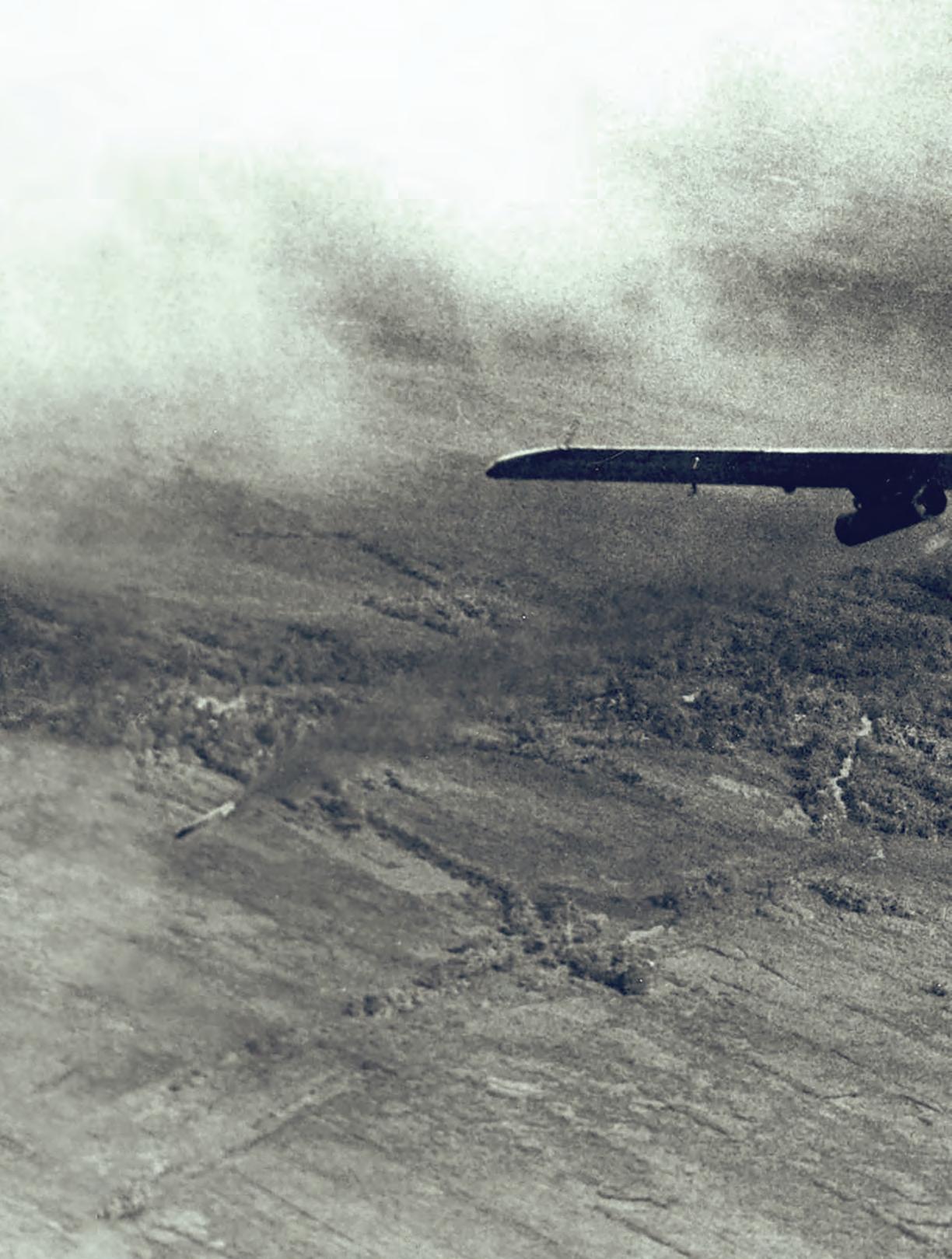
PHOTO CREDITS
30 VIETNAM VIEP-230700-CESSNA O-2.indd 30 4/24/23 11:04 AM
A O-2A Super Skymaster piloted by a Forward Air Controller (FAC) fires a smoke rocket at an enemy strongpoint to mark it as an airstrike target. The O-2 proved an ideal aircraft for the dangerous and demanding tasks of FAC pilots.
HIT MY SMOKE!
CESSNA O-2 SKYMASTER AVIATORS EXCELLED AT CRITICAL MISSIONS
 By Barry Levine
By Barry Levine
PHOTO CREDITS
VIEP-230700-CESSNA O-2.indd 31 4/24/23 11:04 AM
ACessna O-2’s night reconnaissance mission turned tragic on Christmas Day, 1967. Near the Demilitarized Zone, Maj. Jerry Sellers (pilot) and Capt. Richard Budka (observer) received a radio message about a ground patrol in trouble. Quickly flying towards the area, Sellers turned on his landing lights to direct fire from a nearby AC-47 gunship towards the enemy—putting himself and Budka at high risk. Hit by ground fire, the subsequent crash killed both men. Sellers was posthumously awarded the Air Force Cross. The crew’s bravery allowed the ground patrol to return to safety.
Forward Air Controllers (FACs) were integral to America’s war effort in Vietnam, using various aircraft. One such aircraft—the Cessna O-2—was a modified civilian 337 Skymaster and flew a wide range of missions during the war. Then-Lt. Mike Jackson’s memoir Naked in Da Nang noted: “FACs… plodded along at ridiculously low levels to direct airstrikes, observe troop movements, gather intelligence, and/or choreograph search-and-rescue missions…we were the traffic cops of Southeast Asia, telling everyone where to go, when to go, how to get there, and what to do once they were there.”
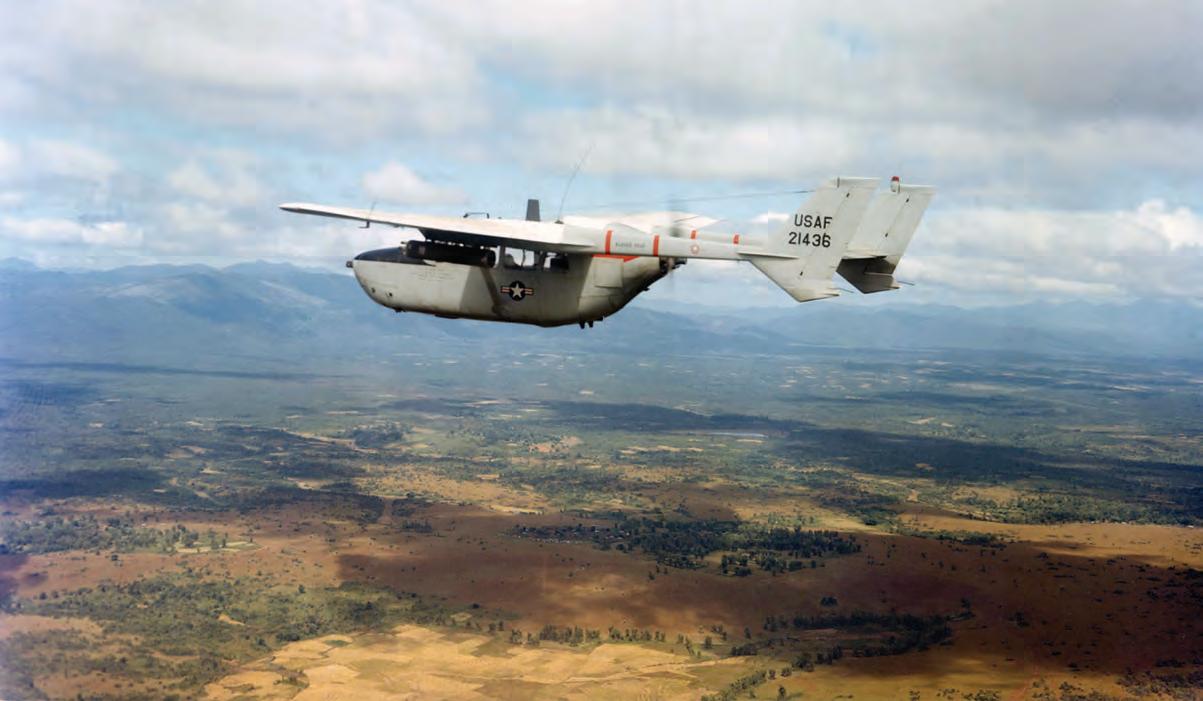
CESSNA AND MILITARY AVIATION have a long history together, as Cessnas were used as World War II trainers and transports. After the war, Cessna designed the single-engine Model 305 with tandem seating for recreational aviation. In turn, the 305s were repurposed by the military into the L-19 “Bird Dog,” seeing service in Korea as observation aircraft.
Redesignated as the O-1 in 1962, Bird Dogs were used extensively in Vietnam and Laos. Their slow speed, limited range, and small ordnance-carrying capacity reduced their effectiveness. The Air Force began searching for more advanced aircraft. At home, Cessna continued developing civilian models such as the 336—first flown in February 1961. This aircraft featured
engines in front of and behind the fuselage and twin cantilever booms, which helped avoid yaw if one engine failed.
Re-engineered with improved performance and retractable landing gear in 1964, the 336 aircraft became the Model 337 Skymaster. With two 210-hp Continental engines, these new aircraft had a top speed of about 200 miles per hour and a range of more than 1,000 miles. The Skymaster had a wingspan over 38 feet and were about 30 feet long. The Air Force evaluated over 100 civilian aircraft before deciding in 1966 that the Skymaster, while imperfect, was the best short-term option to replace the O-1. Renamed the O-2 (and earning nicknames such as “Oscar Deuce”), about 450 were deployed to Southeast Asia. O-2s were faster, had longer loiter time over a target, carried more ordnance, and had better instrumentation for night missions compared to O-1s. Two variants saw action: O-2As for FAC missions and O-2Bs for psychological operations.
Military reconfiguration of Skymasters added observation windows, 7.62mm miniguns, LAU59/A pods holding Folding Fin Aircraft Rockets, armored seats, self-sealing fuel tanks, and stronger landing gear.
O-2 pilots considered the Air Force-designed gunsights ineffective. To improve accuracy, some pilots used a grease pencil mark on the wind-

32 VIETNAM PREVIOUS SPREAD AND TOP: U.S. AIR FORCE; PATCH: GUY ACETO COLLECTION U.S. AIR FORCE
VIEP-230700-CESSNA O-2.indd 32 4/21/23 10:46 AM
Above: A Cessna O-2 soars above Pleiku in 1968. The O-2 was faster and could hover over target areas longer than its predecessor, the Cessna O-1 Bird Dog. Right: Cartoon character Snoopy was popular with Tactical Air Support Squadron (TASS) units.
shield, coordinated with the seat and pilot’s height, as an alternative gunsight.
The U.S. military introduced O-2s into Vietnam beginning in May 1967. This first required getting the aircraft to Asia, which was not a straightforward process. Civilian pilots flew O-2s in flights of four from Cessna’s Wichita, Kansas, plant to Hamilton AFB in California. At Hamilton, the Air Force removed all the seats except the left front and installed extra fuel and oil tanks and an emergency radio. Still flown by civilians, these aircraft island-hopped from California to Vietnam, with flight leaders earning $1,000 and other pilots $800 for the trip, plus airfare home. The Hamilton-Hawaii leg was the longest at about 13 hours flight time; fuel aboard provided for about 14.5 hours of flight, leaving a small margin for navigational error. Years later, an anonymous Air Force pilot wrote: “Civilian misfits ferrying Air Force airplanes across the Pacific to a combat zone? No way!… We began firing off messages to get this idiocy stopped.” The Air Force ultimately assumed responsibility for aircraft delivery.
O-1 pilots stationed in Vietnam received field training for the new aircraft. The 20th Tactical Air Support Squadron (TASS) was the first FAC unit to receive these aircraft and the first O-2 qualified pilot was Maj. James Leatherbee, who described the Cessna as “an ideal plane for FACing.”
FOR PILOTS receiving training in the U.S., flight qualification was at Hurlburt Field in Florida (sometimes referenced as “FAC U”). Instruction included Air Ground Operations schooling for coordinating with ground troops, and Fighter Lead-in Training (conducted at Cannon AFB in New Mexico) to ensure that airmen directing attacks near U.S. troops were qualified fighter pilots. Graduates from Cannon were classified as “A” pilots. Those without that training were rated as “B” pilots and relegated to directing attacks only near non-U.S. allied troops. There was an ongoing dispute within military leadership about the tradeoff between fighter pilot training (increasing FAC effectiveness) and the need for aircraft in the sky (given the expanding operational tempo).
Other facets of a pilot’s education included the Survival, Evasion, Resistance, and Escape School at Fairchild AFB in Washington State and the Jungle Survival School at Clark Air Base in the Philippines. After arriving in Vietnam, pilots provided detailed personal information to military intelligence, such as describing their tattoos and scars, to help search-and-rescue teams avoid potential North Vietnamese traps. After arriving

in-country, pilots would fly observation missions to become familiar with the terrain and received a check ride with an experienced FAC. They were then deemed to be ready for combat.

Call signs were ubiquitous for FAC pilots, regardless of the type of aircraft flown. For example, “Nail” FACS were assigned to the 23rd TASS and “Covey” FACS were at 20th TASS. These call signs were common self-references that the airmen might use long after their military service concluded.

The Air Force developed an extensive command structure for the FAC effort. The 504th Tactical Air Support Group headquarters had nearly 3,000 personnel by 1968. There were five TASS units: the 19th at Bien Hoa; the 20th at Da Nang; the 21st at Nha Trang and Cam Ranh Bay; the 22nd at Binh Thuy; and the 23rd at Nakhon Phanom in Thailand. These squadrons used about 70 forward operating bases.
Being a FAC was a high intensity job, both in the number of sorties flown and performance requirements on each mission. The 1967 flight manual
33 SUMMER 2023 PREVIOUS SPREAD AND TOP: U.S. AIR FORCE; PATCH: GUY ACETO COLLECTION U.S. AIR FORCE
VIEP-230700-CESSNA O-2.indd 33 4/21/23 1:36 PM
These illustrations from the F-100 Forward Air Control (FAC) operating manual show the flight patterns used by FAC pilots when conducting reconnaissance for air strikes. FACs marked enemy positions with white phosphorus, signaling where fighters should aim their bomb strikes. Being a FAC required great focus, accuracy, and fast reflexes.
S&W .38 Victory

to fly lower. The FAC should have a plan or system but should not establish a set pattern [and] take advantage of sun, clouds, speed, binoculars, etc., to protect and separate himself from the enemy.”
Once assigned to a squadron, FACs would be given specific areas of responsibility (AORs). Pilots were expected to become familiar with their AOR’s terrain and to be alert for changes indicating enemy troop or supply movements. Telltale signs of the enemy would be fresh tracks or smoke from a cook-fire. The movement of water buffalo out of the fields could signify an imminent fire fight—villagers would not want to put these animals at risk.
Intelligence, navigators, or maintenance personnel might accompany pilots for daytime missions. FAC missions involved marking enemy positions with white phosphorus (“Willie Pete” in G.I. vernacular) rockets, signaling where the fighters should aim their bomb strikes. If the FAC thought placement was satisfactory, he would call “hit my smoke” as the target for the first bomb. The pilot’s next call would be “cleared hot”—green lighting the first fighter attack. The initial action would be followed by any necessary coordination for additional strikes on the enemy.
Accuracy in marking enemy positions was paramount, as North Vietnamese forces were often close to U.S. and South Vietnamese troops. Given the proximity of the FACs to other U.S. aircraft, often moving overhead at very high speeds, O-2s might have their wing tops painted white to contrast with the jungle terrain. For night missions, O-2s would be painted black and the observer would use a starlight scope to amplify starlight and moonlight. These scopes were effective in illuminating


O-2S WERE EMPLOYED for other critical purposes, including assessing bomb damage after B-52 missions and, if circumstances warranted, requesting an attack by the B-52s. It was a risky assignment. The aircraft would circle at low altitude to review the bombing damage while simultaneously avoiding bombs dropped from the higher altitude B-52s.
FACs also supported the insertion/extraction of special forces teams in Laos and Cambodia. They coordinated helicopter and aircraft rescues of downed aircrews. Command Master Sgt. Craig Corbett recounted after bailing out of an AC-119 “Flying Boxcar” (7.62mm and 20mm mini-guns/ cannons) gunship near An Loc, South Vietnam: “I turned on my survival radio and heard the pilot of the O-2, whose call sign was Sundog, talking to one of our guys on the ground. Waiting a few seconds…I too made contact with Sundog who said, ‘Sit back, relax, Sandy [the call sign for the rescue teams] is on its way’.…I told myself all would be okay.”
Psychological operations involving O-2B missions included loudspeaker broadcasts and dropping leaflets into enemy positions from a chute installed for this task. The 9th Special Operations Squadron, operating from Da Nang, Phan Rang, Tuy Hoa, and Bien Hoa airbases, engaged in these exercises as part of a broader effort to break the will of enemy soldiers. Broadcasts included a series of pained moans interspersed with Vietnamese music, reminding North Vietnamese fighters of home and the risk of death if they continued fighting.
While these missions were challenging and risky, FAC pilots faced other complications. One was the Rules of Engagement, which provided restrictive, confusing, and contradictory proce-
34 VIETNAM TOP: U.S. AIR FORCE (BOTH); BELOW: ROCK ISLAND AUCTION COMPANY BILL CRUMP/ALAMY
trucks on the Ho Chi Minh trail, leading to the destruction of enemy vehicles.
Left: An F-100 Super Sabre, call sign Yellow Jacket 11, releases its bomb load over a designated target area in September 1969. Right: A FAC played an instrumental role in this air strike northwest of An Loc in September 1969, in which a 500-lb. bomb killed an estimated 12 enemy soldiers, destroyed 44 bunkers, and exposed additional enemy bunkers and resources.
If the FAC thought placement was satisfactory, he would call “hit my smoke” as the target for the first bomb.
The Smith and Wesson .38-caliber “Victory” 6-round revolver with its 4- or 5-inch barrel was used by U.S. Army, Marine, and Air Force personnel in Korea and Vietnam. Of limited use as a weapon, American airmen appreciated its light weight, although as a slow-reloading revolver it was of limited use as a defensive weapon.
VIEP-230700-CESSNA O-2.indd 34 4/24/23 11:21 AM
dures on what could or could not be done in combat situations. Attacking Buddhist temples in Cambodia was off limits, for example. The Communists exploited these constraints by purposely placing weapons in religious temples to shoot at U.S. aircraft. Having to strictly abide by these rules in the face of enemies exploiting them demoralized many American personnel.
Radio communications pilots required expert knowledge, adding to the other chal lenges they confronted. O-2s were equipped with UHF radios for coordinating with near by tactical aircraft, FM for communicating with ground troops, and VHF for contacting tactical air control and requesting air support.
Personal safety was a constant concern. Many pilots wore Kevlar flak vests and would sit on a spare vest when airborne for added pro tection. Flight helmets provided protection against small arms fire. Pilots would be issued personal weapons such as a Smith & Wesson Model 10/Victory Model .38 Special and an M-16. While enemy forces might withhold fire on the FAC if they had not been spotted, all bets were off if the enemy thought they had been seen.
Combat damage resulting from the heavy use of the O-2s required extensive field maintenance. Some maintenance personnel received stateside training from Air Force or Cessna technicians at bases such as Sheppard AFB in Wichita Falls, Texas. For others, on-the-job training was the norm. One airman recalled being given a toolbox, the O-2 instruction manual, and being told “go fix it.” All the same, pilots gave high praise to the quality of their ground maintenance crews.
COURAGE WAS NEVER in short supply in the FAC units. Lt. Jackson’s memoir describes an O-2 mission near Hue in mid-1971. Without an observer on board, he was in continuous contact with South Vietnamese forces on the ground (who had rudimentary English skills) while coordinating with nearby F-4 Phantom pilots in dealing with a North Vietnamese attack. Jackson came under heavy ground fire. The ARVN commander on the ground radioed for Jackson to be “careful.” He later wrote: “The ARVN Commander knew that…without me, his unit had a life expectancy of about 20 minutes.” Ultimately promoted to lieutenant colonel, Jackson later became the executive director of the National Aviation Hall of Fame at Wright-Patterson AFB.
Maj. Gerald Dwyer, who served with 23rd TASS, was awarded two Silver Stars in separate actions involving O-2s. In one incident, he was
trapped in a ravine surrounded by North Viet namese fighters after being shot down. He killed three North Vietnamese soldiers with his service revolver and the others fled before he was rescued.
Capt. Thomas Beyer was declared as MIA in July 1968 after he did not return from his O-2 mission in Quang Tin Province. Promoted to major while on MIA status, he was declared as Killed in Action in May 1978. He was awarded the Silver Star with his remains being identified in 2010 and returned home to North Dakota for burial.
These were not isolated incidents, and FAC casualties were high: 84 O-2 crewmen died in combat, part of the 223 total FAC fatalities on all aircraft during the Vietnam War. Two airmen were captured as prisoners of war. Over 100 O-2s were lost to enemy action, and another eight in ground attacks at South Vietnam bases.
There is no doubt that the FACs made a huge contribution to the air war and supporting ground troops in Vietnam. Col. Tom Petitmermet wrote in his memoir, Pretzel 06—Memories of a Forward Air Controller, about his 535 combat sorties in O-2s: “As a FAC I had a level of responsibility that I never came close to again in my future Air Force career. Never again would I have the direct power over the life and death of another person,” as there was virtually no margin for error when calling in airstrikes.
Cessna O-2
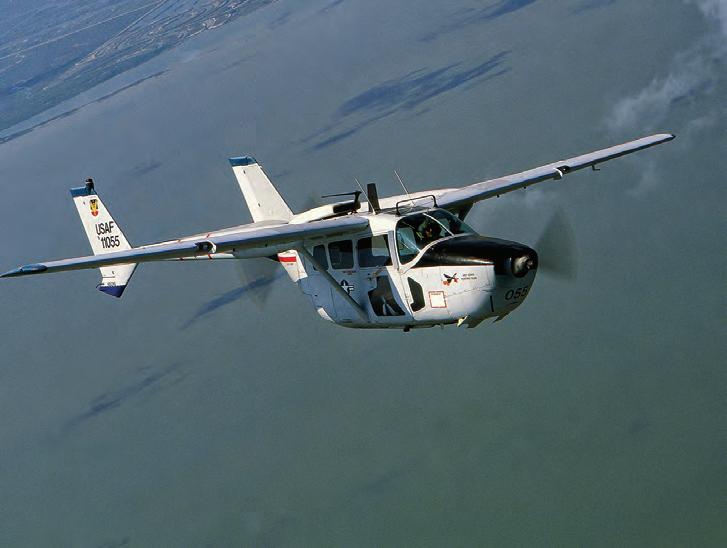
Crew: 2
Length: 29 ft 9 in
Wingspan: 38 ft
Height: 9 ft 4 in
Empty weight: 2,848 lb
Max. takeoff weight: 5,400 lb
Power: 2 × Continental
IO-360C/D air-cooled flat-six engines, 210 hp each
Maximum speed: 199 mph at sea level
Cruise speed: 144 mph at 10,000 ft
Range: 1,060 mi
Service ceiling: 19,800 ft
Guns: 7.62mm SUU11/A Minigun Pod
Hardpoints: Four
MAU-3A bomb racks
Rockets: LAU-59/A Rocket Launcher, MA-2/A Rocket Launcher
Bombs: SUU-14/A Bomblet Dispenser
The legacy of the FAC aviators is honored at locations such as Memorial Park in Colorado Springs, Colorado; Hurlburt Field in Florida; and the National Museum of the United States Air Force in Dayton, Ohio. There is also a memorial in Canberra, Australia, commemorating Royal Australian Air Force FAC personnel who served in Vietnam. V
Barry Levine works at the Henry Ford museum in Dearborn, Michigan, volunteers at the Yankee Air Museum in Belleville, Michigan, and writes on a variety of aviation and history topics.
35 SUMMER 2023 TOP: U.S. AIR FORCE (BOTH); BELOW: ROCK ISLAND AUCTION COMPANY BILL CRUMP/ALAMY
VIEP-230700-CESSNA O-2.indd 35 4/21/23 10:47 AM
A restored Vietnam-era Cessna O-2 Skymaster soars over friendly skies. The FAC pilots and their Cessna aircraft made tremendous contributions to the air war and supporting troops in Vietnam and are honored for their bravery in many places today.
Soldiers of the U.S. Army 4th Infantry Division move through a clearing in the Central Highlands of Vietnam near the Cambodian border in 1967, leaving behind the remains of a fallen comrade who lies where he fell, covered by a poncho.
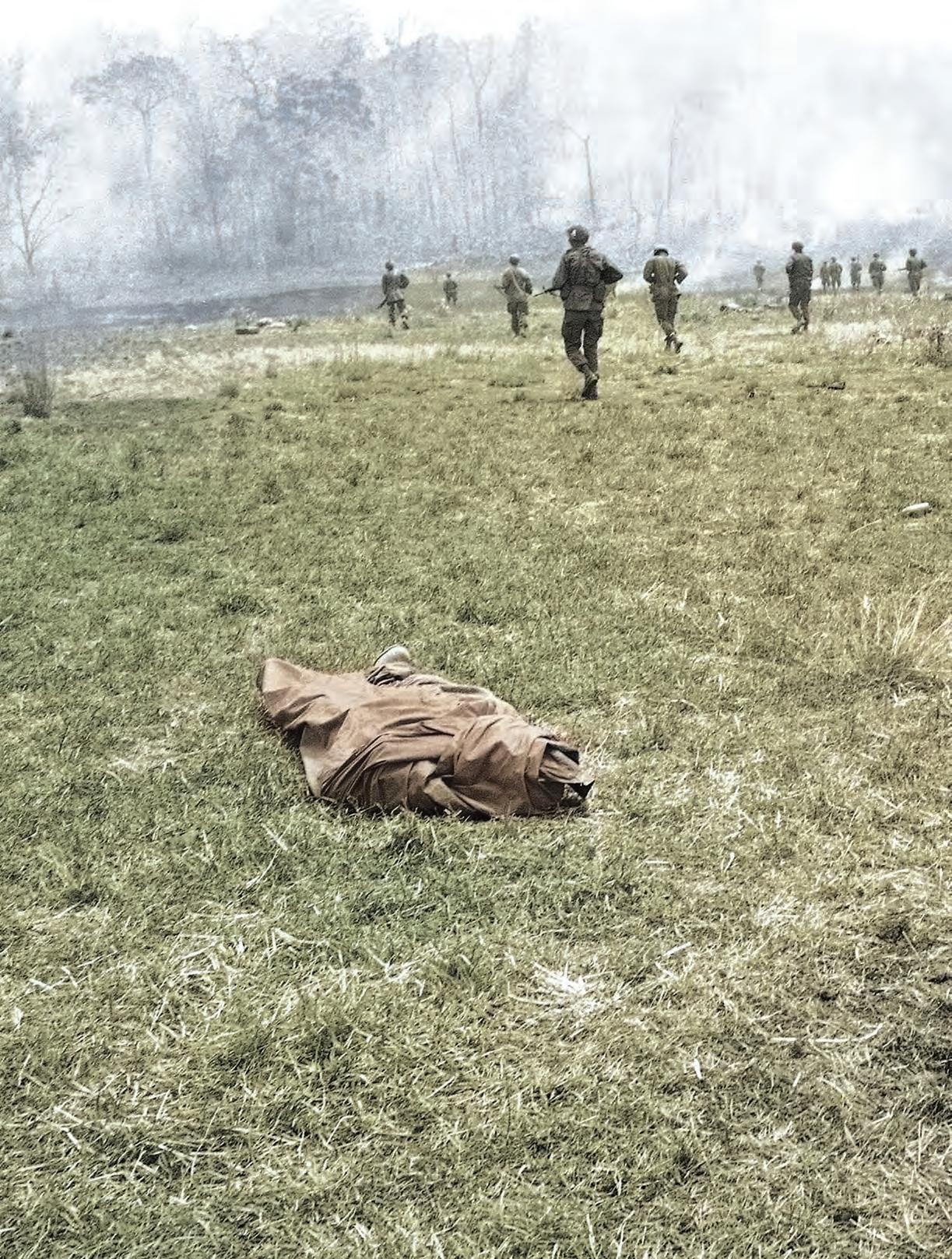
PHOTO CREDITS
VIEP-230700-HIGHLANDS.indd 36 4/24/23 11:07 AM
HELL IN THE CENTRAL HIGHLANDS
A SEARCH FOR MISSING COMRADES LED TWO INFANTRY COMPANIES STRAIGHT INTO AN ENEMY INFERNO
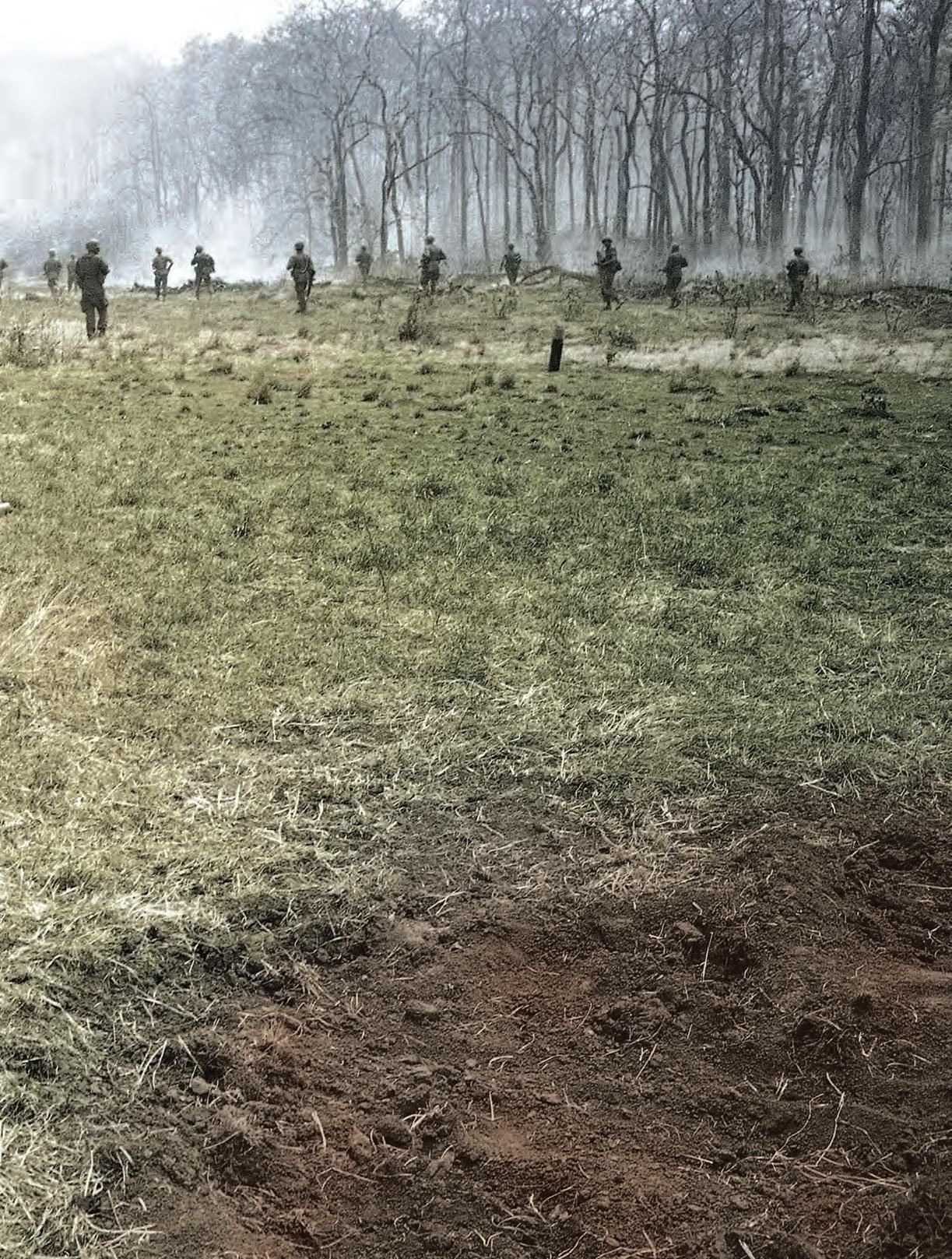 By Warren Wilkins
By Warren Wilkins
PHOTO CREDITS
37 SUMMER 2023 VIEP-230700-HIGHLANDS.indd 37 4/24/23 11:07 AM
Central Highlands

A Viper’s Nest
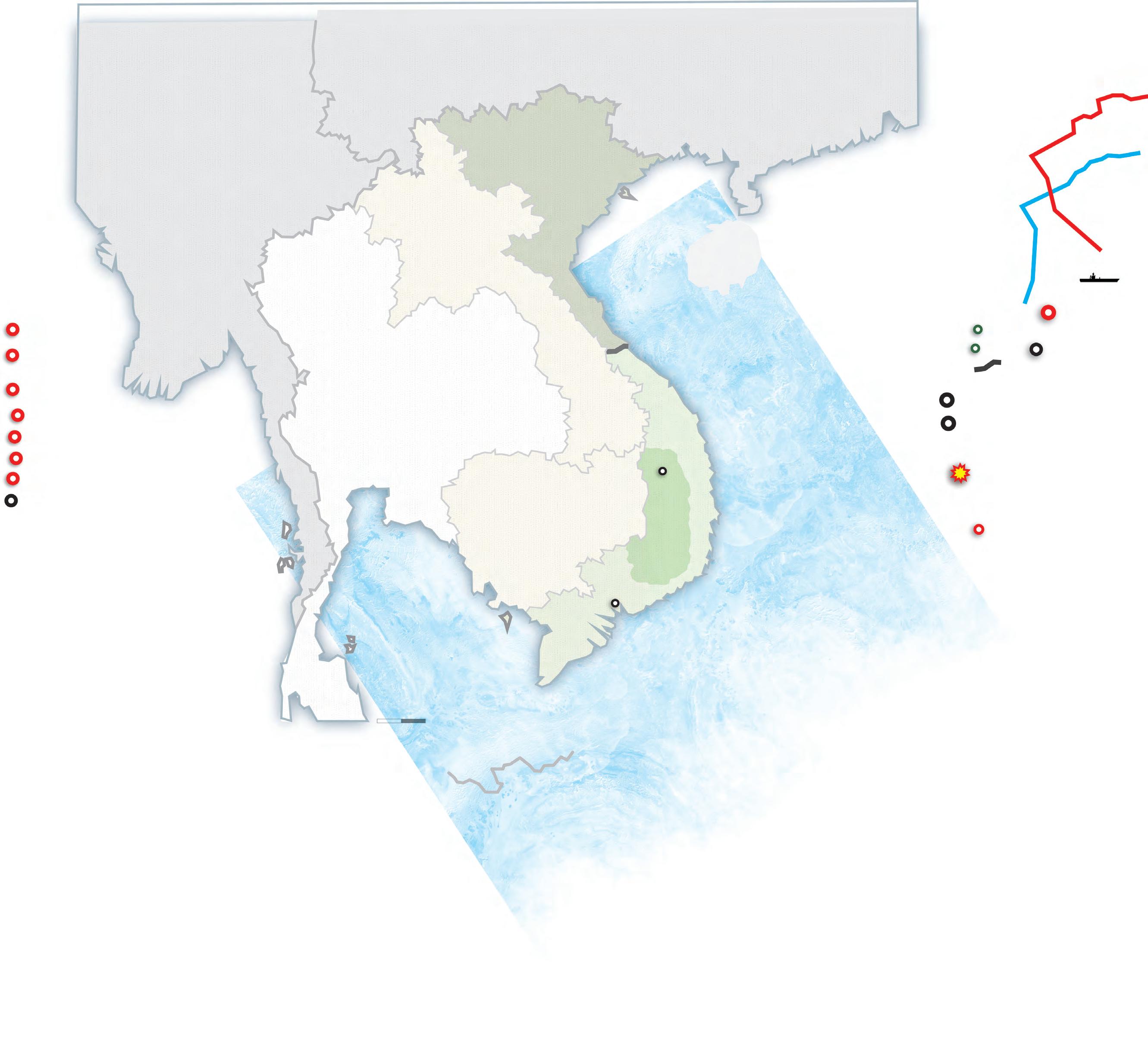
CAMBODIA SAIGON SOUTH VIETNAM SOUTH CHINA SEA
A Viet Cong detachment rushes into battle in January 1967. North Vietnam employed both conventional and irregular forces against American troops. The Central Highlands was a hotbed of enemy activity.
VIEP-230700-HIGHLANDS.indd 38 4/21/23 11:08 AM
PLEIKU
its battalions across the Nam Sathay on Feb. 12. Adamson would soon tangle with elements of Col. Nguyen Huu An’s battle-tested 1st NVA Division west of the river, prompting Peers to recall his 1st Brigade from Phu Yen Province on the coast. Commanded by Col. Charles A. Jackson, the 1st assumed responsibility for the area between the two rivers, while Adamson was to continue working west of the Nam Sathay to the Cambodian border.
Over the next few weeks, the two brigades made regular contact with North Vietnamese regulars. Smaller skirmishes sometimes developed into much larger fights. While operating east of the Nam Sathay on March 12, the 2nd Battalion, 35th Infantry attacked a bunker complex, but could not eliminate the enemy position despite air and artillery support. The daylong battle cost the battalion 14 killed and 46 wounded. Abandoning the complex that night, the North Vietnamese left behind 51 dead, though another 200 may have been killed in the fighting.
Four days later, the 2nd Brigade shifted to the Plei Doc, a heavily jungled area that abutted the Cambodian border south of the Plei Trap. When the brigade lost radio contact with a long-range reconnaissance patrol (LRRP) team late on March 21, Adamson ordered Lt. Col. Harold Lee’s 1st Battalion, 8th Infantry to retrieve the missing men. Lee, recognizing the urgency of the mission, dispatched two companies the following morning.
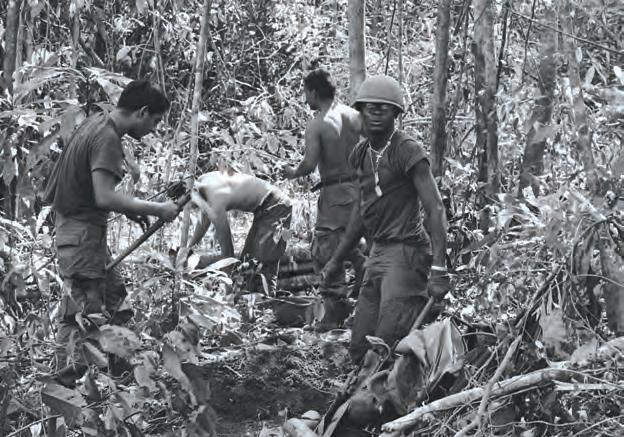
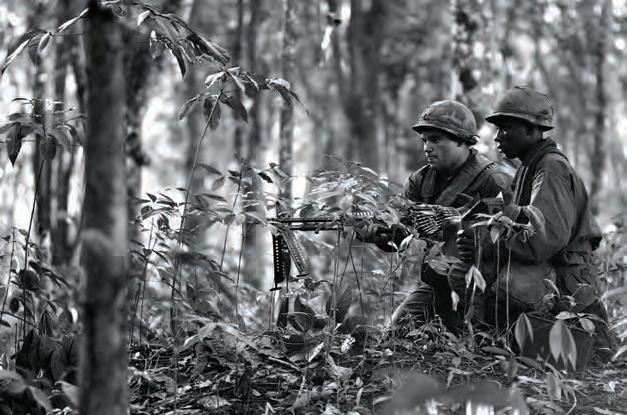
Breaking camp early on the 22nd, Company A—led by Capt. William Sands, a hardnosed Citadel graduate—moved west-southwest along a ridgeline, flanked by Company B to the south. Company A had only maneuvered a short distance through the dense vegetation when Sands halted the four-platoon column and instructed his 1st Platoon to move forward and join the 2nd Platoon up front. The 3rd and 4th Platoon were to remain in a column formation behind the two lead platoons.
Slipping out of the company column, the 1st Platoon moved abreast of the 2nd Platoon around 7:30 a.m. “The First Platoon was to the left of us, probably fifty to one hundred yards,” noted Sgt. Ron Snyder, a squad leader in the 2nd Platoon. “We barely got lined out, when the First Platoon was hit.” Snyder hit the ground as the roar of enemy rifle and automatic weapons fire reverberated across the jungle.
Struck in the groin, a young soldier wailed in agony while a torrent of fire sliced through the 1st and 2nd Platoons from hidden positions along
the ridgeline in front and to the left of Company A. The two lead platoons, trapped in what appeared to be the kill zone of a large enemy ambush, were being cut to pieces.
“I would say within the first four or five minutes, we had 27 killed and 45 wounded,” recalled medic John “Doc” Bockover. “I heard ‘medic’ and started running like hell to the front. There were NVA all around us.” While Bockover raced to treat the wounded, North Vietnamese troops swept around the pinned-down platoons, most likely in an attempt to outflank and encircle the entire company.
Sands, moving with the company command group behind the 2nd Platoon, requested artillery fire and attempted to organize a defensive perimeter. He also radioed Company B on the battalion radio net. “You got to get down here!” he shouted over the radio. “We are taking heavy casualties and don’t know how long we can hold out!”
Sands was adjusting artillery fire when a rocket-propelled grenade slammed into the command group. He was killed instantly. 1st Sgt. David McNerney, a tough career man on his third tour of duty in Vietnam, assumed command of the company and calmly rallied the shaken men.
39 SUMMER 2023 PREVIOUS PAGES: AP PHOTO/JOHNER; ABOVE: KEYSTONE/HULTON ARCHIVE/GETTY IMAGES; MAP BY JON C. BOCK AP PHOTO (BOTH)
VIEP-230700-HIGHLANDS.indd 39 4/21/23 11:09 AM
Top: Men of the 4th Infantry Division clear a landing zone for helicopters amid the dense foliage of the Central Highlands in 1967. Bottom: An M60 machine gun is brought into action against communist forces near the Cambodian border in 1967. The 2nd Platoon used M60s to defend themselves against an enemy blocking force.
Lee had spoken to Sands earlier in the battle and had directed Company B, commanded by Capt. Robert Sholly, to move at once to assist Company A. Company B, however, was already en route. Sholly had heard gunfire that morning. When he could not raise Sands over the radio, he immediately placed his four platoons online and headed west-northwest.
The sounds of battle grew louder as Company B made its way through the underbrush, hurried along by Sholly. Suddenly a pair of machine guns raked the 4th Platoon on the left flank of the company line. Pinned down in a bamboo field, the platoon returned fire. They could not silence the enemy machine guns nor the shadowy snipers perched in the trees above them. The North Vietnamese, later identified as a battalion from the 95B NVA Regiment, had positioned a blocking force between the two companies to prevent them from linking up.
Worried he would not reach Company A in time, Sholly instructed his 2nd Platoon to flank the enemy force from the right. He hoped this would relieve some of the pressure on the 4th Platoon. Forming up quickly, the 2nd Platoon dashed forward and leapt into a dry creek bed approximately five feet wide and four feet deep. The bed provided a measure of cover. However, as the platoon prepared to scramble
out of it to continue the assault, the startled troopers were met with a heavy volley of automatic weapons fire from enemy soldiers hidden on the opposite bank.
SP4 Victor Renza, one of two machine gunners in the 2nd Platoon, was setting up his M60 machine gun when a single rifle round whistled past his ear with an audible crack. Renza’s legs suddenly went limp, and he slumped back down into the creek bed without firing a shot. The color had drained from his face, and he could feel his heart thumping loudly. Convinced he had been targeted by an enemy sniper, Renza grabbed the M60 and, together with his assistant gunner, crawled along the bed in search of a new position for the gun.
The 2nd Platoon responded with M16s and M60s and was quickly drawn into a costly shooting match with the enemy blocking force. Stalled on the flanks, Sholly attempted to press ahead with the two platoons in the center of the Company B line, but the North Vietnamese refused to

40 VIETNAM
BETTMANN/GETTY IMAGES CLOCKWISE FROM TOP LEFT: U.S. ARMY; AP PHOTO/KIM KI SAM; U.S. ARMY; VICTOR RENZA
A U.S. Air Force F-100 Super Sabre drops bombs on an enemy position near a rural outpost. Air support played a vital role in saving the lives of the men of Company A as gunships and fighter bombers rained U.S. firepower on the enemy.
VIEP-230700-HIGHLANDS.indd 40 4/24/23 11:08 AM
They could not silence the enemy machine guns nor the shadowy snipers perched in the trees above them.
budge. “We could not see out of the brush and bamboo, so we were at a disadvantage,” he explained. “We set up fire in the trees but could not break the tie.” The advance had ground to a halt and the company had taken casualties. Facing the prospect of an even tougher fight, Sholly pulled his command post back and called on supporting arms.
Meanwhile Company A had been split into two separate perimeters. As the North Vietnamese maneuvered on its flanks, past pockets of pinned-down troopers from the 1st Platoon, they bumped into the 3rd Platoon as it moved forward to link up with the 1st. Firing from the hip, machine gunners from the 3rd and a handful of grunts armed with M16s succeeded in slowing the enemy advance.
Though no longer in any immediate danger of being overrun, Company A needed firepower— particularly close-in artillery fire, to shatter the North Vietnamese assault. McNerney recognized as much. After taking over command of the company from the late Sands, he skillfully adjusted artillery fire in support of the company to within 20 meters of friendly positions.

The storm of incoming artillery shook the surrounding jungle. “I can’t begin to tell you how many rounds landed around or on us,” Pfc. Tom Carty observed. “The artillery came screaming in and then exploded with a deafening roar. Shrapnel was hitting everyone and cutting vegetation like a weed eater. It didn’t seem like the artillery would ever stop.” He added, “Round after round after round of artillery came screaming in, exploding, and sending hot deadly metal in all directions, killing [North Vietnamese] and
Left: North Vietnamese commander Gen. Chu Huy Man is pictured trekking through the jungles of the Central Highlands in this undated photo. Enemy activity in the Plei Trap Valley was likely connected to his plans for a winter-spring offensive. Right: Artillery fire helped shatter the North Vietnamese assault.
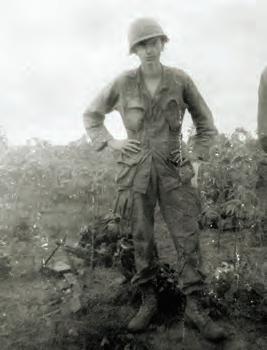
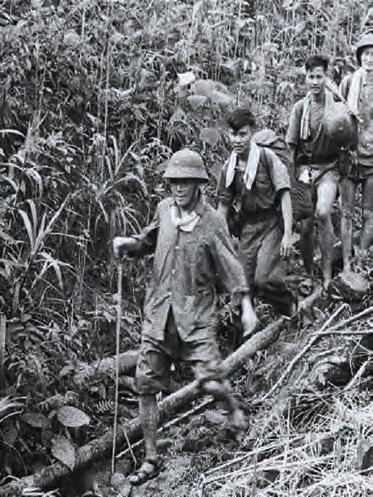
U.S. soldiers without discrimination.”
Gunships and fighter bombers hammered the enemy as well, and before long the sheer weight of American firepower began to ease some of the pressure on the embattled company.
Flying overhead in a UH-1B Huey helicopter, WO1 Don Rawlinson of the 4th Aviation Battalion asked Company A for a visual aid so that he could align his approach. McNerney, aware that Rawlinson’s overloaded bird carried desperately needed supplies, climbed a tall tree under intense enemy fire and tied a bright orange identification panel to the highest branch he could find to mark the company’s location. Rawlinson spotted the panel and hurriedly searched for a landing spot. “My God!” he yelled to his copilot as the chopper cruised in. “Can you believe someone climbed up there in that tree and did that?”
McNerney clambered up the tree although he had been knocked to the ground and injured by an enemy grenade earlier in the morning. Throughout the battle, he offered words of encouragement to the troops, checked in on the wounded, and at one point helped clear a landing zone for helicopters. For his extraordinary leadership and remarkable bravery, McNerney was awarded the Medal of Honor at a ceremony held at the White House in September 1968.
As the battle raged around Company A, the number of dead and wounded continued to increase. Bockover treated a wounded radioman and then moved with a squad leader from the 4th Platoon to aid a recent replacement who was lying against a tree, covered in blood.
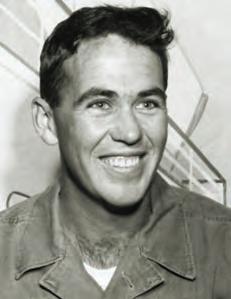
41 SUMMER 2023 BETTMANN/GETTY IMAGES CLOCKWISE FROM
TOP LEFT: U.S. ARMY; AP PHOTO/KIM KI SAM; U.S. ARMY; VICTOR RENZA
Renza
VIEP-230700-HIGHLANDS.indd 41 4/24/23 11:08 AM
McNerney
Chunks of flesh and bone had been ripped from his face, and he was having difficulty breathing. As Bockover prepared to perform an emergency tracheotomy so that the wounded man could breathe, the soldier gazed up at his squad leader and asked if he had finally earned a Combat Infantryman Badge, a highly coveted decoration signifying that the wearer had participated in ground combat. Heartbreakingly, when his squad leader replied that he had done enough to earn a CIB, the man inhaled one final time and then died.
To the south and east of Company A, Sholly summoned all manner of fire support to destroy or dislodge the enemy force blocking Company B’s advance. Sholly pounded the North Vietnamese with 105mm and 155mm guns, fighter bombers, and several flights of A1-E Skyraiders loaded with napalm. Bolstered by this support, Company B was able to maintain freedom of maneuver and establish a more defensible position.
“Saying the platoons were able to consolidate their positions is a cold and distant description of what really went on,” Sholly acknowledged in his book, Young Soldiers, Amazing Warriors. “Each man was looking for targets, moving and shooting, throwing grenades, trying to look out for his buddies, calling for more ammunition, and hearing that hated call for ‘medic.’”
The cumulative impact of concentrated American firepower softened up the enemy blocking force. By early afternoon Company B was moving west-northwest again, carrying its dead and wounded. The firing tapered off as the North Vietnamese, battered by air strikes and artillery fire and fought to a standstill by Company A, withdrew from the battlefield.
Companies A and B eventually linked up later that afternoon. Taking command of both companies, Sholly met with McNerney, who informed him that Sands had been killed. Sholly, after lamenting the loss of his friend, advised McNerney that a perimeter large enough to accommodate two companies would have to be completed before nightfall. Company A would take up positions in the center of the perimeter. For the remainder of the day, the exhausted troopers evacuated the dead and wounded and dug fighting positions.
Fought for the most part at close range, the battle in the Plei Doc cost the 1st Battalion, 8th Infantry 27 killed and 48 wounded. Company A suffered the lion’s share of the losses, including 22 dead. The missing LRRP team was never found.
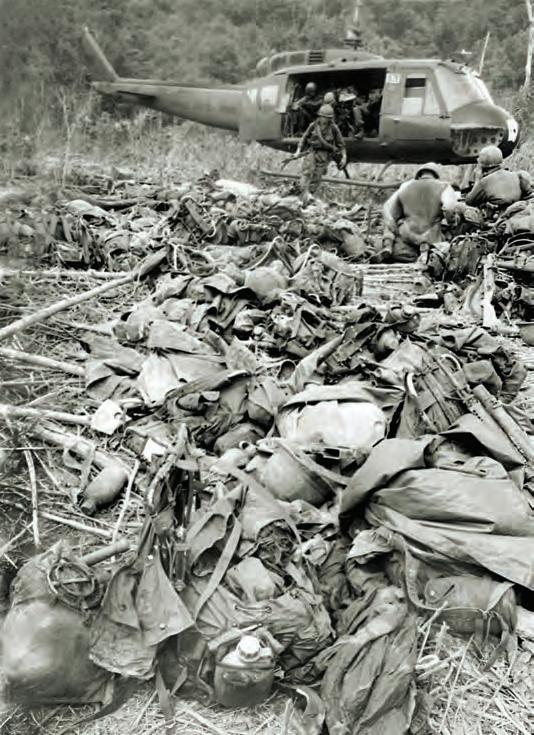
Adamson praised the performance of the battalion without considering the number of North Vietnamese killed in

42 VIETNAM FROM TOP: AP PHOTO/HONG; AP PHOTO FROM TOP: AP PHOTO; HISTORYNET ARCHIVES
VIEP-230700-HIGHLANDS.indd 42 4/21/23 11:09 AM
Top: The personal gear of U.S. soldiers belonging to a company of the 4th Infantry Division lies collected in a landing zone in the Central Highlands in 1967. As in our story, this company was nearly annihilated but was saved by air support and artillery. Bottom: An infantryman is comforted by a fellow soldier after witnessing the deaths of his comrades in the Central Highlands in 1967.
the fighting. “That evening at about 2300, General Peers asked me for an enemy body count—I said I had no idea,” Adamson admitted. “He said Saigon wanted to know. Later I received a call from Swede [Stanley] Larsen by secure radio asking the same question. I was to provide a number. I said ‘150.’ The next day we found about 45 bodies and had the body count previously given withdrawn and ‘45’ reported in its place.”
Officially, the 4th Infantry Division reported 136 enemy killed. Whatever the final number— and it was almost certainly higher than 45, given the North Vietnamese practice of removing their dead from their battlefield—Company A had survived the deadly ordeal. Many credit McNerney. “I know that God saved us,” wrote SP4 Willis Nalls of the 2nd Platoon, “but Top’s bravery was what got us out of that firefight.” While undoubtedly a critical factor, McNerney’s heroism alone would not have been enough to save the company without the courage and determination of the young “grunts” holding the line.
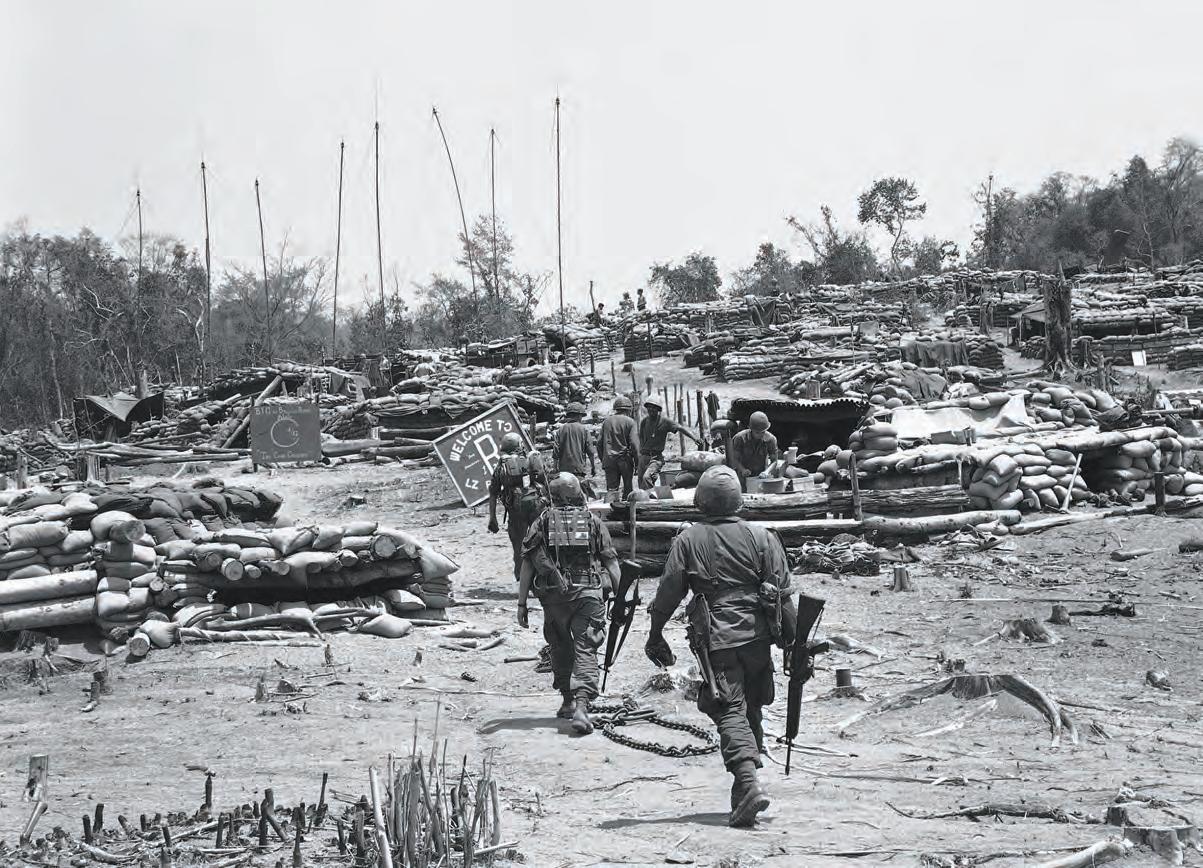
In May, Companies A and B moved into the remote Ia Tchar Valley in western Pleiku Prov-
ince. On the morning of May 18, while investigating a well-worn trail near the Cambodian border, a platoon from Company B was ambushed and surrounded by a large enemy force. Company A received orders to reinforce its stricken sister company, even as some of its soldiers privately feared that the battle had all the makings of another March 22, only this time in reverse.
Combat Badge

Established on Oct. 27, 1943, the Combat Infantryman Badge or CIB was awarded to any U.S. Army soldier or Special Forces member below the rank of colonel who used his infantry skills in battle. Troops who did not see combat but who met the standards during specialized training could receive the Expert Infantryman Badge.
That night Company A stumbled around in the dark for hours searching for the “lost platoon.” Overrun and all but wiped out, the platoon was eventually found the following morning. “Those two days [March 22 and May 18] created a bond and a brotherhood between the two companies that has lasted for over 50 years,” said Renza, one of the “lost platoon” survivors. “When we got to them [Company A] in March, they were so happy to see us. We didn’t know who was coming for us. But when they found me on May 19, after the North Vietnamese had overrun us the day before, I couldn’t believe it was those same guys we’d gone to help in March. I know that they were determined to get to us.” V
Warren Wilkins is the author of books and magazine articles about the Vietnam War and is a frequent contributor to
magazine.
43 SUMMER 2023 FROM TOP: AP PHOTO/HONG; AP PHOTO FROM TOP: AP PHOTO; HISTORYNET ARCHIVES
Vietnam
VIEP-230700-HIGHLANDS.indd 43 4/24/23 11:08 AM
Men at this U.S. base in the Central Highlands near the Cambodian border rely on the protection offered by sandbags, logs, and bunkers for defense. North Vietnamese forces launched constant attacks, including repeated mortar barrages, to harass American troops and gain control over the contested region.
SNAPSHOTS FROM THE SECRET WARS
RARE PHOTOS SHOW SPECIAL FORCES WARRIORS IN ACTION BEHIND ENEMY LINES
 By Zita Ballinger Fletcher
By Zita Ballinger Fletcher
44 VIETNAM
VIEP-230700-SOG-PORTFOLIO.indd 44 4/24/23 12:59 PM
Special operations missions are the stuff of legend. Shrouded in secrecy, these dangerous assignments are fit to be undertaken only by warriors who have proved they can excel at what others find impossible. Sometimes secrecy can give rise to myths. But there are no myths in John L. Plaster’s fine book, SOG: A Photo History of the Secret Wars—the incredible stories of heroism, sacrifice, and daring are all based firmly on fact and enriched with source materials provided by the men themselves.
Consisting of volunteers from elite special operations units across the spectrum of the U.S. military—such as the Army Green Berets, Navy SEALs, and Marine recon units—the Military Assistance Command, Vietnam-Studies and Observation Group (known by its acronym SOG) was an ultra-secret force that was practically invisible to all. Reporting directly to the Joint Chiefs of Staff and even at times the president, SOG left zero public footprint and performed clandestine missions that remain unknown to many today. Despite the challenges of chronicling the history of this unit, Plaster’s book provides a wealth of information about the SOG experience during the Vietnam War, using more than 700 photos snapped “in wartime by the very men who performed SOG’s amazing missions.” This portfolio contains a selection of those rare images, which Vietnam magazine is pleased to share with readers courtesy of Casemate Publishers.
The book features an array of remarkable and striking images. No less striking and remarkable are the stories of personal bravery that accompany them. “I’ve sought to humanize and make real these phenomenally courageous men, to help readers understand in our image-conscious era that it’s what’s inside such extraordinary warriors that makes them special,” writes Plaster in his introduction. It is a noble mission and one that the author has accomplished with excellence. V
HALO parachutists of SOG link up beneath a Huey helicopter above Camp Long Thanh. To perform HALO jumps, airborne troopers exit an aircraft at a high altitude and freefall before opening their parachutes close to the ground. The SOG used HALO jumps to infiltrate enemy territory during the Vietnam War.

VIEP-230700-SOG-PORTFOLIO.indd 45 4/24/23 12:59 PM
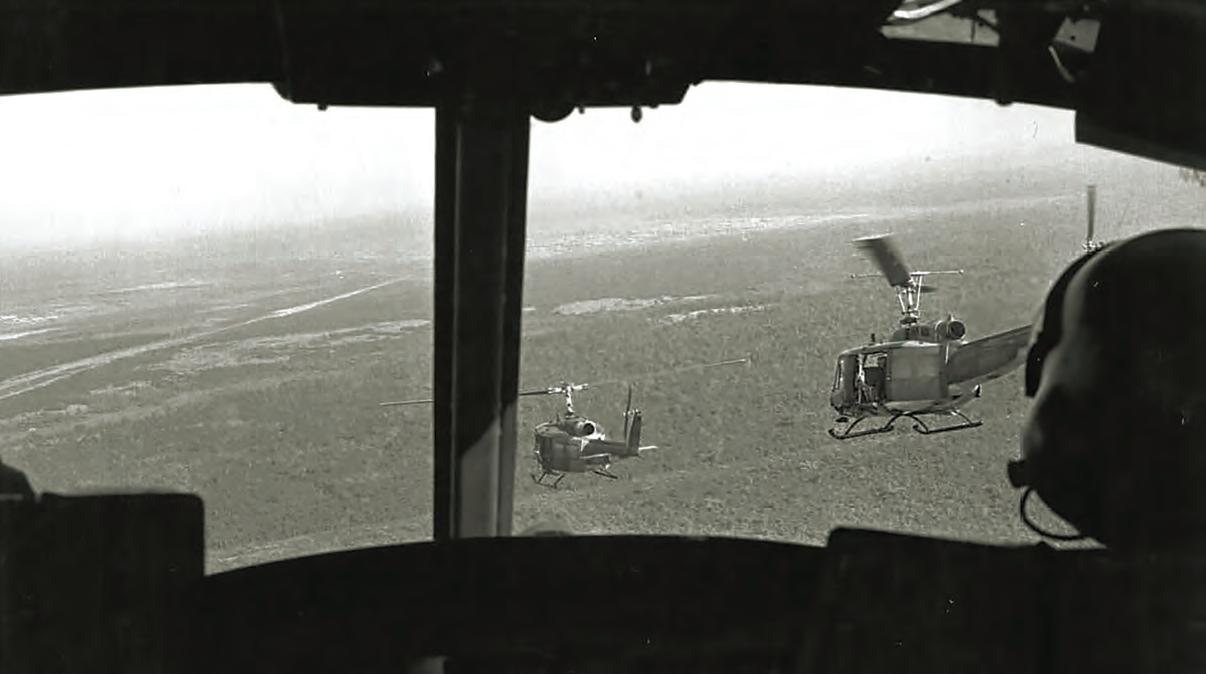

A PREVIOUS PAGES: COURTESY OF JIM STORTER VIA CASEMATE PUBLISHERS; TOP LEFT: COURTESY OF DALE BOSWELL VIA CASEMATE PUBLISHERS; BOTTOM: COURTESY OF RICHARD MADORE VIA CASEMATE PUBLISHERS; TOP RIGHT: COURTESY OF GEORGE GASPARD VIA CASEMATE PUBLISHERS; BELOW LEFT: COURTESY OF BILL KENDALL VIA CASEMATE PUBLISHERS; RIGHT: COURTESY OF THE COLBY FAMILY VIA CASEMATE PUBLISHERS B
VIEP-230700-SOG-PORTFOLIO.indd 46 4/24/23 11:11 AM
Due to official secrecy, SOG men were aware that their sacrifices and deaths would not be publicly acknowledged. Their valor was selfless.
Secret Wars
EDA Hueys of the 155th Assault Helicopter Company transport SOG reconnaissance troopers to an area near the Cambodian border. Due to official secrecy, SOG men were aware that their sacrifices and deaths in action would not be publicly acknowledged. Their valor was selfless. B Members of an SOG reconnaissance team from Command and Control Central (CCC) based in Kontum, South Vietnam, scale retractable ladders in midair during an emergency extraction from Laos. Rapid extractions saved many SOG men who were being threatened by enemy forces. C A reconnaissance team led by Sgt. Gerald Plank ascends to safety from a “hot area” in Laos. Retractable aluminum ladders were used both to insert and extract SOG units. Men extracted from enemy territory were often too tired to climb all the way up the ladders and hung from them across long distances while being flown to safety. D This model of an oil tank farm was one of many that CIA agents at Camp Long Thanh used to study raid tactics; the camp later became an SOG base. E CIA spymaster and Saigon station chief William Colby wears the “black pajamas” of the Viet Cong, often adopted also by covert operatives to deceive the enemy. Colby pioneered covert airdrops in Vietnam.
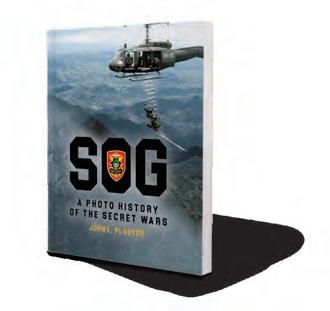

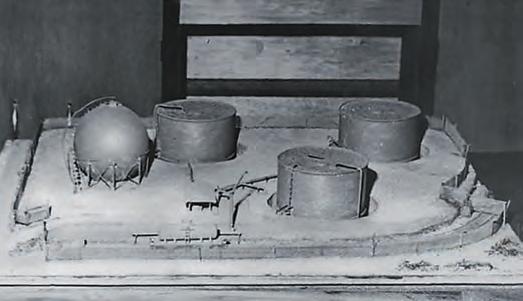

C47 SUMMER 2023 PREVIOUS PAGES: COURTESY OF JIM STORTER VIA CASEMATE PUBLISHERS; TOP LEFT: COURTESY OF DALE BOSWELL VIA CASEMATE PUBLISHERS; BOTTOM: COURTESY OF RICHARD MADORE VIA CASEMATE PUBLISHERS; TOP RIGHT: COURTESY OF GEORGE GASPARD VIA CASEMATE PUBLISHERS; BELOW LEFT: COURTESY OF BILL KENDALL VIA CASEMATE PUBLISHERS; RIGHT: COURTESY OF THE COLBY FAMILY VIA CASEMATE PUBLISHERS
VIEP-230700-SOG-PORTFOLIO.indd 47 4/24/23 12:48 PM
SOG: A Photo History of the Secret Wars gives readers a fascinating look at men who served in this top-secret unit, recounting their heroism and courage as well as insights into covert operations.
Secret Wars
intimidate the enemy. Some cards were left on dead enemy bodies and others were designed to be left in areas behind enemy lines to spook opponents. This skull and crossbones card was an improvised design “published untraceably in Thailand,” according to Plaster. J SOG men smile as they celebrate the success of a hazardous full-length mission involving a HALO jump; the troopers successfully landed together without sustaining any injuries and accomplished their objectives. They are, from left to right: Willard

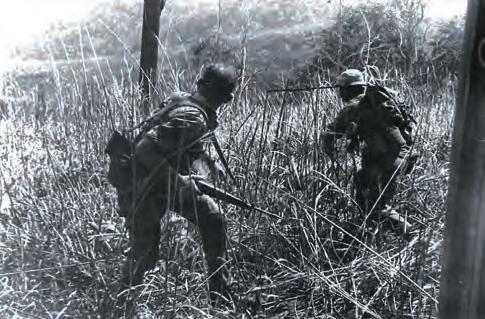

48 VIETNAM
G
TOP LEFT: COURTESY OF BILL DEACY VIA CASEMATE PUBLISHERS; BOTTOM LEFT: COURTESY OF BRENDON LYONS VIA CASEMATE PUBLISHERS; RIGHT: COURTESY OF BILLY WAUGH VIA CASEMATE PUBLISHERS; TOP RIGHT: COURTESY OF JOHN PLASTER VIA CASEMATE PUBLISHERS; BELOW: COURTESY OF JIM STORTER VIA CASEMATE PUBLISHERS VIEP-230700-SOG-PORTFOLIO.indd 48 4/24/23 11:12 AM
F SOG S. Sgt. Bill Deacy, pictured here, demonstrates how his CAR-15 saved his life by shielding him from an enemy AK bullet aimed at his head. The bullet mark appears on the buttstock tube in the center of the image just below Deacy’s nose. G This photo snapped from a SOG Cessna O-1 “Bird Dog” plane shows North Vietnamese Army units moving along a trail in Cambodia—capturing a rarely seen perspective of the enemy. H These SOG men (Sgt. Maj. Billy Waugh, left, and Sfc. Melvin Hill) duck from incoming fire from NVA soldiers after getting off a helicopter about 22 kilometers north of Khe Sanh. I SOG members often left behind “calling cards” to
Moye, Capt. Jim Storter, Newman Ruff, and Michael Bentley.
H F
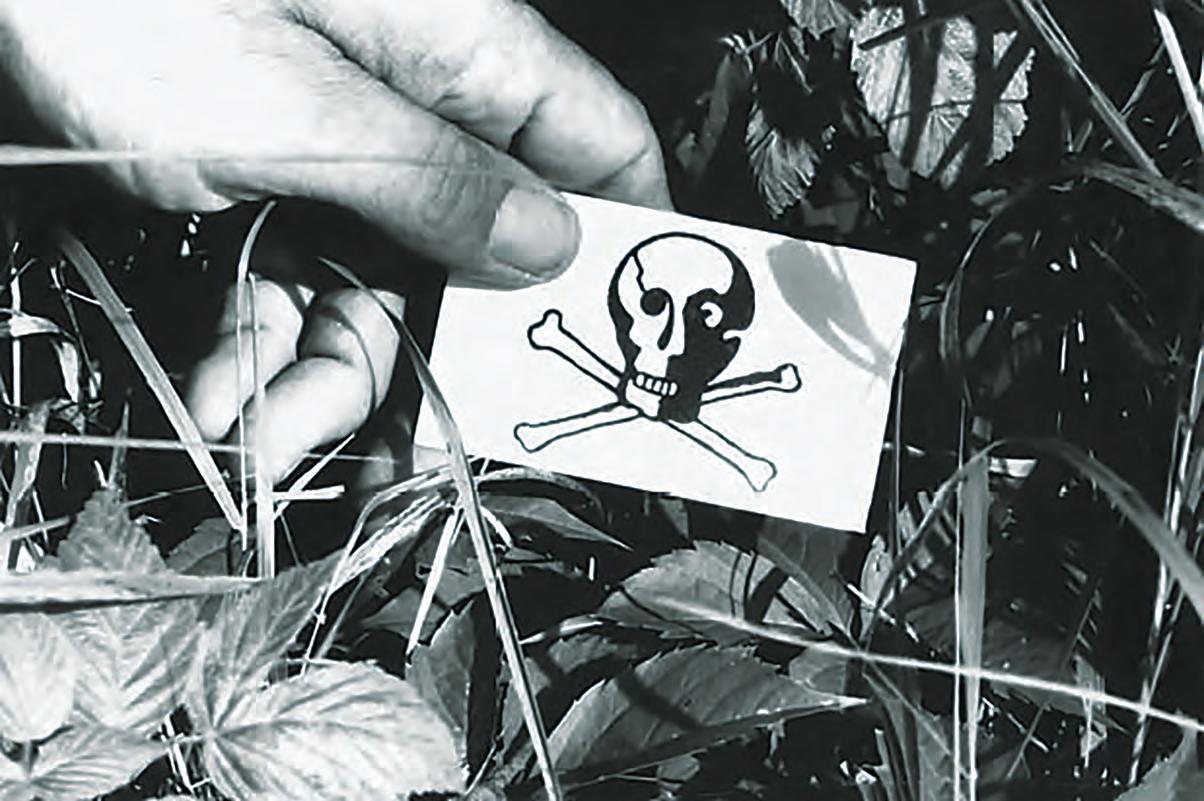
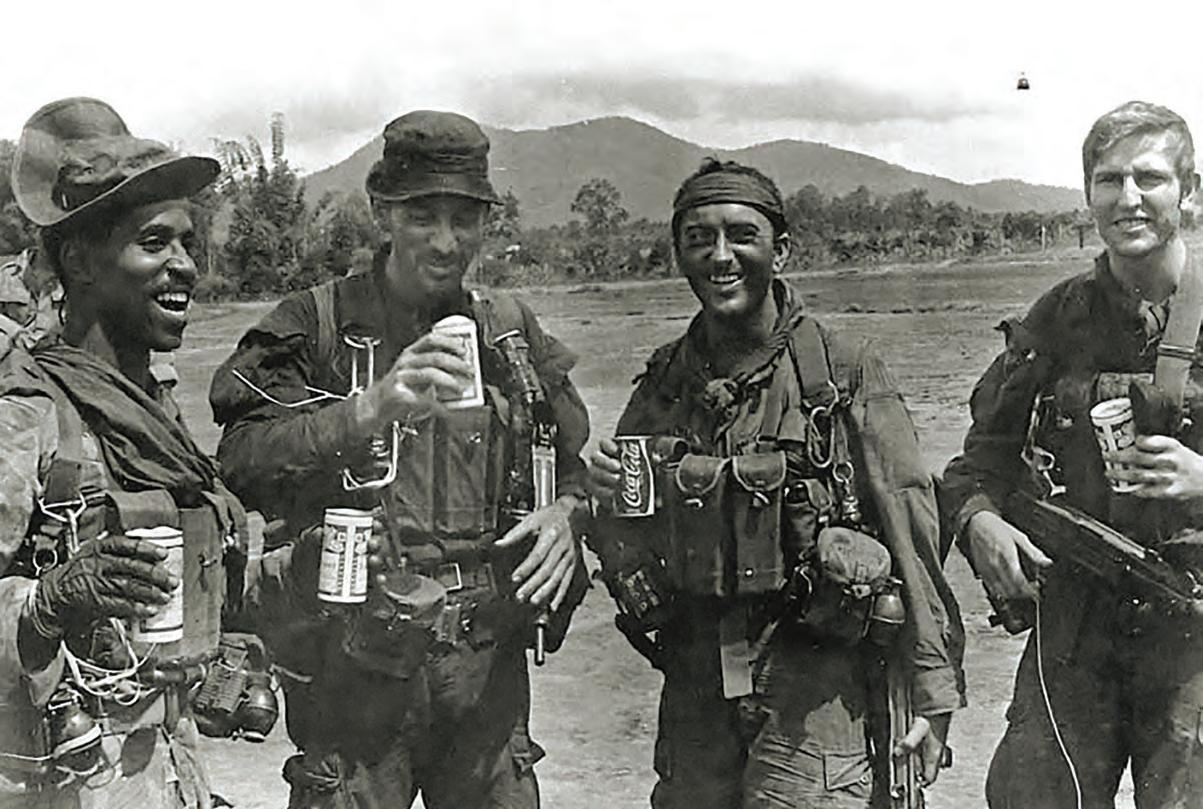
I J TOP LEFT: COURTESY OF BILL DEACY VIA CASEMATE PUBLISHERS; BOTTOM LEFT: COURTESY OF BRENDON LYONS VIA CASEMATE PUBLISHERS; RIGHT: COURTESY OF BILLY WAUGH VIA CASEMATE PUBLISHERS; TOP RIGHT: COURTESY OF JOHN PLASTER VIA CASEMATE PUBLISHERS; BELOW: COURTESY OF JIM STORTER VIA CASEMATE PUBLISHERS VIEP-230700-SOG-PORTFOLIO.indd 49 4/21/23 12:10 PM
HARD-FOUGHT VICTORY
IN OPERATION STARLITE IN 1965, U.S. MARINES

BATTLED A FORMIDABLE VIET CONG REGIMENT IN THE FIRST MAJOR U.S. OFFENSIVE ACTION OF THE WAR
By John Walker
PHOTO CREDITS
VIETNAM 50 VIEP-230700-STARLITE.indd 50 4/21/23 12:35 PM

PHOTO CREDITS
VIEP-230700-STARLITE.indd 51 4/21/23 12:35 PM
An M50 Ontos searches for a defensive position after landing on Chu Lai beach in 1965. The Ontos boasted massive firepower and provided support to ground troops during Operation Starlite. 51 SUMMER 2023
As dawn broke over Quang Nhai Province on Aug. 18, 1965, the political officers of the 1st Viet Cong Regiment looking on from the village of Van Tuong were startled to see an American naval force anchored just off the South China Sea coast. Within an hour, landing craft began disembarking riflemen from 3rd Battalion, 3rd Marine Regiment onto the shore—dubbed Green Beach—adjacent to the small fishing village of An Cuong.
Four miles west, on a swath of land pummeled by artillery, airstrikes, naval gunfire, and napalm, Marines from 2nd Battalion, 4th Marine Regiment were lifted by helicopter into three north-to-south landing zones at one-mile intervals. The 3rd Battalion’s M Company moved south from the Marine air base at Chu Lai and established a mile-long blocking position north of the engagement area by 4 a.m. that day.

With his “anvil and hammer” pieces in place, Lt. Gen. Lewis Walt’s Operation Starlite was underway. Attacked and pursued eastward, the Viet Cong would be unable to escape by sea. They would have to stand and fight or attempt to escape and evade.
Operation Starlite took place when it did for two reasons. Gen. William Westmoreland, commander of U.S. Military Assistance Command Vietnam (MACV), had made it clear by early August 1965 to Walt, commander of III Marine Amphibious Force, that he expected Marine infantry units to conduct “major combat operations” against communist forces throughout the I Corps Tactical Zone without delay. A 17-year-old deserter from the 1st VC Regiment surrendered on Aug. 15. This man was personally interrogated by Maj. Gen. Nguyen Chanh Thi, commander of I
Corps. Thi was convinced of the deserter’s claims that the 1st VC Regiment was based in Van Tuong and planned to attack the air base at Chu Lai, and he immediately notified Walt. When American intelligence confirmed the presence of insurgents in the area, Walt acted immediately, leaving Aug. 1617 for planning and preparation. He planned the attack for 6:30 a.m. on Aug. 18.
Not all the deserter’s claims proved accurate. The 1st VC Regiment had just concluded a successful summer campaign. By late July, its four dispersed battalions had infiltrated northward into base areas around Van Tuong 1, Nam Yen 3, and elsewhere, and had no plans to attack Chu Lai. The 1st VC Regiment—the 40th, 60th, 90th, and 45th Weapons Battalions—was a well-armed and seasoned force led by a veteran cadre that had scored repeated victories over ARVN forces in the last half of 1964 and first half of 1965. On July 5, 1965, it had overrun and almost annihilated the 1st Battalion, 51st ARVN Regiment at Ba Gia 20 miles south of Chu Lai, but had also suffered extremely heavy losses and needed time to rest, refit, and begin recruiting and training new conscripts.
The Marines were unaware that elements of the 2,000-man enemy regiment were absent. The 1st
52 VIETNAM TOP LEFT: U.S. ARMY; RIGHT: BETTMANN/GETTY IMAGES PREVIOUS SPREAD: CORBIS VIA GETTY IMAGES; THIS PAGE: KEYSTONE-FRANCE/GAMMA-KEYSTONE VIA GETTY IMAGES
VIEP-230700-STARLITE.indd 52 4/21/23 12:35 PM
U.S. Marine riflemen disembark from helicopters near Chu Lai in 1965 following search and destroy operations. Gen. William Westmoreland expected the Marines to conduct “major combat operations” that year throughout the I Corps Tactical Zone.
VC Regiment’s commander, Le Huu Tru, his deputy, and the battalion commanders were attending a post-campaign conference in the mountains west of Chu Lai, leaving command to political officers, while the 90th and half of 45th Weapons Battalion were still 15 kilometers south of the engagement area. The remainder of 45th Battalion, along with 40th and 60th Battalions, would be present in the battle area on Aug. 18 with 1,500 men at most.
With the regimental command post located at Van Tuong 1 just four kilometers from Green Beach, Nguyen Dinh Trong, the 1st VC Regiment’s top political officer, moved to delay the Marines while the command post was either reinforced or relocated. Duong Tong Minh set up a defensive position in a trench halfway between Green Beach and Van Tuong 1, then moved close to the beach and prematurely detonated a mine in the path of the oncoming Marines that did no damage. Lt.
Phan Tan Huan prepared a defensive position south of An Thoi 1, from where he would direct 57mm recoilless rifle, machine gun, mortar, and small arms fire at any Marine unit within range.
Hostilities commenced in earnest when Companies K and I, 3rd Battalion, 3rd Marine Regiment disembarked from LVTP-5s (Landing Vehicle, Tracked, Personnel 5, also called amphibious tractors or “amtracs”) and advanced abreast toward An Cuong 1. On the right, Capt. Jay Doub’s three platoons of K Company came under automatic weapons fire and called in airstrikes, then moved forward and cleared the northern third of the village.

Backed by two M50 Ontos fighting vehicles, K Company’s platoons continued west and secured
the high ground beyond the village.
The M50 Ontos was a tracked, lightly armored anti-tank vehicle boasting massive firepower. It was equipped with six 106mm recoilless rifles, a .30-caliber machine gun, and several .50-caliber “targeting” guns; the .50-caliber M-8C spotting rifle for the 106mm M-40 recoilless rifle was not a machine gun, but a magazine-fed single shot that fired a special marking round. The M50, used by the Marines as an anti-personnel weapon, struggled in harsh terrain; crew members were exposed to enemy fire when they had to leave the vehicle to reload the rifles.
K Company pivoted right and advanced northward toward Phase Line Banana. On the left, I Company, 3rd Battalion, 3rd Marine Regiment, cleared the rest of the village and continued westward to link up with 2nd Battalion, 4th Marine Regiment a mile inland near An Cuong 2.
On Green Beach, Lt. Col. Joseph Muir, commanding officer of 3rd Battalion, 3rd Marine Regiment, had moved his command post ashore and was joined there at 7:30 a.m. by Col. Oscar Peatross, CO of 3rd Battalion, 7th Marine Regiment and overall commander of Starlite’s ground forces. Capt. James McDavid led L Company, 3rd Battalion, 3rd Marine Regiment ashore at 7 a.m. and had his three platoons spread out on the battalion’s right flank and dig in.

At 6:45 a.m., UH-34 helicopters shuttled G Company, 2nd Battalion, 4th Marine Regiment into Landing Zone (LZ) Red, while E Company, 2nd Battalion, 4th Marine Regiment and Lt. Col. Joseph Fisher’s battalion command post landed at LZ White at 7:45 a.m.
The eight-hour ordeal of H Company, 2nd Battalion, 4th Marine Regiment began when it landed at LZ Blue onto ground occupied by 1st VC’s 60th Battalion. LZ Blue lay in an exposed position between Nam Yen 3 and Hill 43, a wooded knoll dominating the otherwise flat terrain. The enemy allowed the first wave of helicopters to land unmolested. Afterwards the Viet
53 SUMMER 2023 TOP LEFT: U.S. ARMY; RIGHT: BETTMANN/GETTY IMAGES PREVIOUS SPREAD: CORBIS VIA GETTY IMAGES; THIS PAGE: KEYSTONE-FRANCE/GAMMA-KEYSTONE VIA GETTY IMAGES
Left: Lt. Gen. Lewis Walt launched Operation Starlite as a preemptive strike against the 1st VC Regiment, reported as planning to attack the Chu Lai air base. Right: Marines prepare for action after arriving on landing craft at Chu Lai in August 1965.
VIEP-230700-STARLITE.indd 53 4/21/23 12:35 PM
Crew members were exposed to enemy fire when they had to leave the vehicle to reload the rifles.
SOUTH CHINA SEA
battle to have taken place to that date involving American troops. The U.S. Marines successfully surprised the Viet Cong with their speed in attacking and resilience in face of fierce counterattacks. The Marines compelled the enemy to withdraw from what had been a Viet Cong stronghold and launching point for operations.
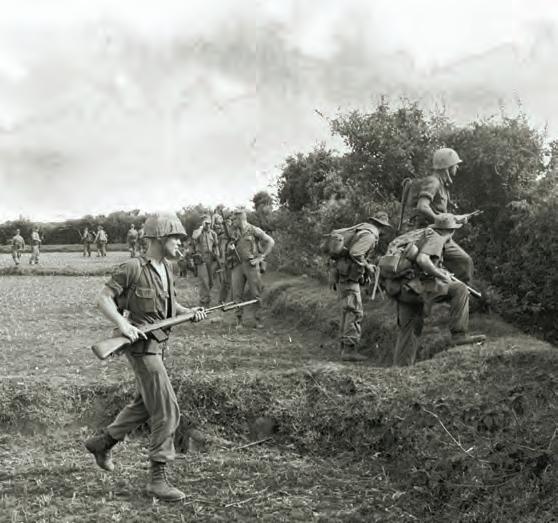
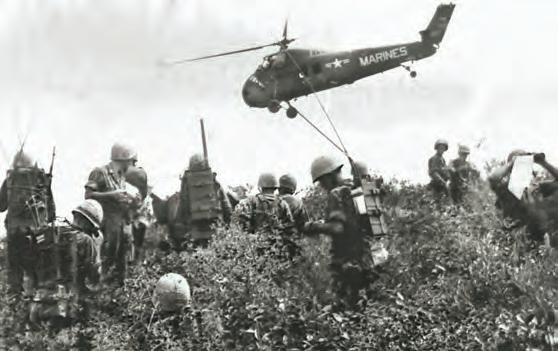
Cong poured .51-caliber (Soviet 12.7mm) heavy machine gun fire into the succeeding waves and into the Marines working feverishly, in merciless 105-degree heat, to establish a perimeter around the landing zone.
As the fighting escalated around LZ Blue, the companies farther north made good progress. G Company, 2nd Battalion, 4th Marine Regiment left LZ Red and searched two nearby hamlets, found nothing, and continued pushing steadily eastward against light resistance. They eventually dug in on M Company, 3rd Battalion, 3rd Marine Regiment’s right flank at PL Banana.

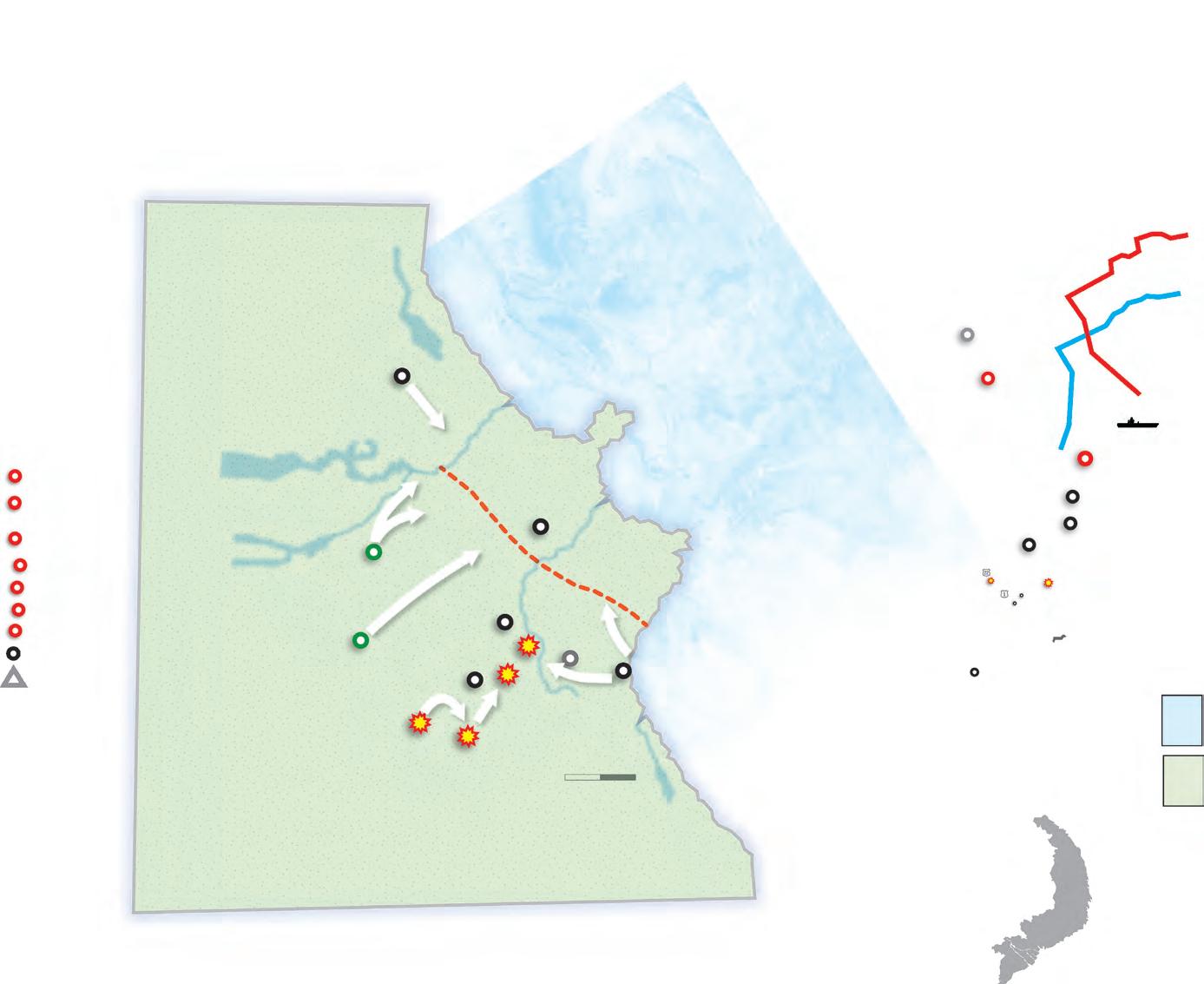
Advancing northeast from LZ White for 200 meters, E Company, 2nd Battalion, 4th Marine Regiment came under mortar, machine gun, and small arms fire from an estimated 70 insurgents on a ridgeline to their front. Thanks to the lavish use of supporting arms—particularly Marine A-4 Skyhawks and F-4 Phantoms rocketing, strafing, and napalming the enemy— the company fought their way up the ridge and cleared it, evacuated casualties for an hour, and continued north at around 11 a.m. At noon, they made contact with 50 more insurgents. Another firefight ensued.
Advancing, E Company spotted a force of about 100 insurgents in the open, heavily armed and moving briskly south. The timing was auspicious. Whiskey (“Howtar”) Battery, 3rd Battalion, 12th Marine
Regiment had been lifted via helicopter into M Company, 3rd Battalion, 3rd Marine Regiment’s position that morning. The 20-round barrage it delivered killed about 90 of the enemy. (A “howtar” is a hybrid 107mm shell mounted onto the platform of a 75mm pack howitzer.) By 3 p.m., E Company, 2nd Battalion, 4th Marine Regiment had fought its way to PL Banana with moderate losses and was settling into defensive positions.
Around noon, Muir ordered his executive officer, Maj. Andrew Comer, to send a resupply column to I Company, 3rd Battalion, 3rd Marine Regiment, then a few hundred meters north of Muir’s command group. Comer assembled three M67 “Zippo” flame tanks (napalm only), five amtracs loaded with ammunition and water, and 23 Marines led by 2nd Lt. Robert Cochran. Column 21 moved out at 12:30 p.m. The convoy had advanced only a few hundred meters between Nam Yen 3 and An Cuong 2 along a trail flanked by
54 VIETNAM NATIONAL ARCHIVES NATIONAL ARCHIVES (BOTH); MAP BY JON C. BOCK
LZ Red
LZ White LZ Blue Company M 3rd Battalion 3rd Marines Van Tuong An Thoi (2) An Cuong (2) Hill 43 An Cuong (1) Phase Line BANANA Nam Yen(3) Ambush of Resupply Column MILES 0 1 3rd Battalion 7th Marines 3rd Battalion 3rd Marines Company G 2nd Battalion 4th Marines Company E 2nd Battalion 4th Marines Company H 2nd Battalion 4th Marines Battalion Command 2nd Battalion 4th Marines OPERATION HEADQUARTERS Chu Lai Air Base VIEP-230700-STARLITE.indd 54 4/21/23 12:36 PM
NHO NA BAY
rice paddies and trees, dikes, and hedgerows, when a mortar disabled the lead tank. The entire column then came under a devastating barrage that killed Lt. Cochran and halted the advance. Trapped inside their amtracs and tanks, the Marines returned fire with every weapon at their disposal. Yet by late afternoon most of the armored vehicles had been disabled, casualties were high, and the column was down to just one vehicle-mounted automatic weapon returning fire.
Sgt. James Mulloy, who later said he could see “hundreds of insurgents in every direction,” abandoned his amtrac, hid in a nearby paddy, and kept up a steady stream of M-14 rifle fire that stymied repeated enemy attempts to overrun the convoy. The column’s radio operator, panicking, kept his handset keyed on “send,” blocking incoming calls requesting detailed information. Due to communications problems, Column 21 couldn’t be located and remained in place until it was extracted the next morning. The enemy unit that launched the ambush, 1st Company, 40th VC Battalion, also suffered severe losses due to their habit of attacking in large, close formations.
K Company, 3rd Battalion, 3rd Marine Regiment had advanced two kilometers northward when both 2nd and 3rd Platoons, save one squad led by Lt. Burt Hinson, were pinned down by heavy fire coming from trench lines to their front and left flank. Firing his .45-caliber M1911A1 pistol, Lt. Hinson led his lone squad on a charge up the slope to their front, driving the surprised insurgents and their automatic weapons from the crest of the hill. After 1st Platoon captured the enemy trench on the left flank, the pressure along the entire front was relieved. After Muir ordered L Company, 3rd Battalion, 3rd Marine Regiment, to come up from Green Beach and deploy on K Company’s right, the two companies continued northward. By 1 p.m. they were setting up defensive positions along PL Banana.
Unsure of the enemy force’s size, 1st Lt. Homer Jenkins, commanding H Company, 2nd Battalion, 4th Marine Regiment, ordered one platoon to at-
tack Hill 43 and two platoons to attack Nam Yen 3. Both thrusts were easily halted. Jenkins called in airstrikes and led an attack against Nam Yen 3 with all three of his platoons. An entire enemy company occupied the village. As 3rd Platoon moved forward, it was hit by a fury of automatic weapons fire from a VC-occupied hedgerow. Although the Marines killed a number of insurgents and captured the hedgerow, H Company was unable to suppress the torrent of enemy fire and could advance no further into Nam Yen 3. Lt. Jenkins regrouped his company and led another attack against Hill 43, and with the help of M48 Patton tanks finally captured the crest of that hill. Needing more Marines on the ground, Col. Peatross summoned one company from his reserve, I Company, 3rd Battalion, 7th Marine Regiment.
The airstrikes called by Lt. Jenkins had halted the advance of Capt. Bruce Webb’s I Company, 3rd Battalion, 3rd Marine Regiment east of Nam Yen 3. When the barrage lifted, I Company continued to its assigned position opposite An Cuong 2, only to come under fire from An Thoi 2 and from high ground southeast of An Thoi 1.

55 SUMMER 2023 NATIONAL ARCHIVES NATIONAL ARCHIVES (BOTH); MAP BY JON C. BOCK
VIEP-230700-STARLITE.indd 55 4/21/23 12:36 PM
A Marine rifleman surveys the damage left in the aftermath of a U.S. airstrike on a Viet Cong village on the Van Tuong peninsula on Aug. 22, 1965, during Operation Starlite. The VC made skillful use of harsh terrain to camouflage their well-fortified positions.
Aware the company to his left, H Company, 2nd Battalion, 4th Marine Regiment, was in difficulty, Webb asked permission to attack An Cuong 2, though it was in 2nd Battalion, 4th Marine Regiment’s area of responsibility. Muir assented.

Webb and his men advanced and encountered a fortified village numbering about 25 huts, honeycombed with dozens of camouflaged trenches, tunnels, bunkers, spider holes, and huts with collapsing walls that allowed machine gun teams inside to open fire when the walls were lowered. The terrain was marked by dense vegetation, rice paddies, and wooded areas, leaving the Marines few open fields of fire. Hedgerows and thickets measuring six to eight feet high divided the rice paddies, providing the defenders with excellent cover and concealment.
ICompany, 3rd Battalion, 3rd Marine Regiment, had just entered the village when a grenade killed Capt. Webb and mortar fire wounded nine others. 1st Lt. Richard Purnell, the company’s executive officer, assumed command and called the reserve platoon forward. Again, armor and supporting arms turned the tide, helping I Company to capture An Cuong 2 and kill 50 insurgents in 90 minutes of fighting. Purnell radioed Muir and was told to resume his march north toward PL Banana. As I Company departed, a helicopter gunship was shot down northeast of the village, and on Muir’s orders Lt. Purnell left 10 men and three tanks to protect the craft until it was evacuated.

With Hill 43 secured, Lt. Jenkins regrouped H Company and renewed the assault against Nam Yen 3, backed by two flame tanks and three M50 Ontos. The advance was again halted, however, by intense fire from hedgerows on both flanks, with the insurgents now adding white phosphorus rifle grenades to the barrage. In the debilitating heat, a good number of Marines spent their water supplies and began suffering from exhaustion and dehydration.
Carrying their dead and wounded, I Company, 3rd Battalion, 3rd Marine Regiment arrived at PL Banana around 1 p.m. The company’s tired Marines got almost no rest as they were called back to the regimental command post to help search for Column 21, the “lost column.”
Notified the column had been ambushed, Muir ordered Maj. Comer to gather whatever support he could and move to the convoy’s aid, with I Company, 3rd Battalion, 3rd Marine Regiment leading. Comer’s rescue column—one tank, five amtracs, three Ontos, and most of Lt. Purnell’s I Company riding aboard the vehicles—left the command post around 1:30 p.m., unaware of the convoy’s location and unable to make radio contact.
After Comer’s column traveled just 400 meters and reached high ground 200 meters east of An Cuong 2, a projectile halted the lead tank. The bunched-up column came under a fierce barrage of enemy fire that killed five Marines and wounded 16. Much of the fire came from An Cuong 2, which had been “cleared” earlier in the day, after the enemy had reentered the village through a hidden tunnel network. After calling in airstrikes, the men of I Company again found themselves battling an enemy hidden in trenches and hedgerows surrounding the village.
Tank fire set the hedgerows aflame, adding smoke and dust to the haze blanketing the battlefield. Reinforced by L Company, 3rd Battalion, 7th Marine Regiment and two more tanks, I Company fought its way through An Cuong 2 as darkness fell on Aug. 18 and then searched un-

56 VIETNAM TOP: BETTMANN/GETTY IMAGES; BOTTOM: NATIONAL ARCHIVES CLOCKWISE FROM LEFT: AP PHOTO/PETER ARNETT; U.S. ARMY; BETTMANN/GETTY IMAGES
VIEP-230700-STARLITE.indd 56 4/24/23 11:13 AM
Above: A U.S. Marine wounded during combat with the Viet Cong is led to a helicopter evacuation zone in August 1965. Top right: A Marine trudges past an M-48 tank and MAG-16 helicopter evacuating Starlite casualties. Bottom right: Marines rush wounded men onto a helicopter for evacuation on the last day of Operation Starlite.
successfully into the night for the lost supply column. Muir called off the rescue when he learned the column was no longer in danger and ordered L Company to join the regiment at PL Banana. The exhausted Marines of I Company finally returned to the command post at 4:30 a.m., having fought for almost 24 hours while losing 15 dead and 55 wounded from their original 177-man contingent.
With Nam Yen 3 quieted by airstrikes, Lt. Jenkins gathered his company and armor—five tanks and three Ontos—and headed northeast for PL Banana. Around 11:30 a.m., he led the company into an open rice paddy between Nam Yen 3 and An Cuong 2 and quickly came under small arms and machine gun fire. With mortars raining down on the entire column, H Company, 2nd Battalion, 4th Marine Regiment found itself under fire from all directions and with no room to maneuver. With his position untenable, Lt. Jenkins finally received orders to withdraw to LZ Blue at 2 p.m.
After Jenkins and H Company moved out, their lead platoon had to alter course when medevac helicopters landed in the midst of the column. Moving to the flank, the platoon lost contact with the main body and was ambushed. Fortunately the men were able to link up with Lt. Purnell’s helicopter security detail, after which the combined force fought its way to safety. Jenkins and his two remaining platoons fought through several additional ambushes and arrived at LZ Blue at 4:30 p.m., where he was ordered to dig in and await resupply and reinforcements.
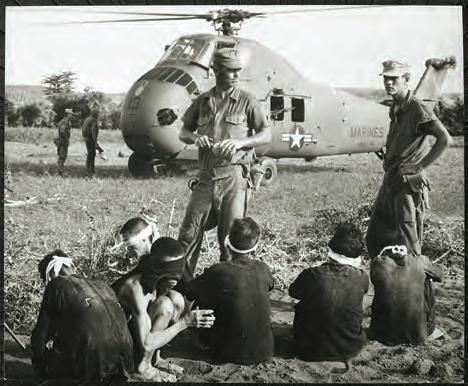
After eight hours of almost constant combat in crippling heat and humidity, the parched and exhausted Marines of H Company welcomed the rest. Though they hadn’t achieved their objectives, they had killed a good number of enemy soldiers.
The Marines spent the night of Aug. 18 shoring up their lines while Col. Peatross brought the rest of 3rd Battalion, 7th Marine Regiment ashore. Muir and Fisher found only scattered pockets of resistance when they attacked at 7:30 a.m. on Aug. 19. Snipers holed up in caves and spider holes continued to harass Marine patrols.
As the Marines moved into the area of the previous day’s heaviest fighting, they found 1st VC had largely escaped during the night, leaving one company behind to assist the villagers with casualties. M and I Companies, 3rd Battalion, 7th Marine Regiment, pushed through An Cuong 2 with no resistance, brought out the lost supply column, and established a blocking position outside An Thoi 2 by 3 p.m. By nightfall, the Marines had completed their sweep of the Phuoc Thuan Peninsula and organized resistance had ceased.
Due to the presence of so many hidden tunnels, bunkers, caves, spider holes, and machine gun emplacements discovered in and around Van Tuong 1, Gen. Walt continued the operation for another five days (Aug. 2024) to conduct a thorough search. After 2nd Battalion, 4th Marine Regiment and 3rd Battalion, 3rd Marine Regiment returned to Chu Lai on Aug. 20, the men of 1st Battalion, 7th Marine Regiment moved into the area and joined 3rd Battalion, 7th Marine Regiment and units from the ARVN’s 2nd Division for the search. The Marines killed another 54 enemy soldiers before Operation Starlite concluded on Aug. 24, bringing the total of confirmed Viet Cong dead to 614, along with nine prisoners of war and 42 suspected insurgents at a cost of 45 Marines killed in action and 203 wounded. Although both sides claimed victory, the Marines were more than satisfied with the results of what became the war’s first major U.S. offensive and the war’s biggest battle to date involving American troops.
The Marines had killed a disproportionate number of enemy soldiers fighting from expertly camouflaged, prepared positions in extremely harsh

terrain, had overcome extreme weather conditions and communication difficulties, and had evicted, at least temporarily, a formidable enemy regiment from its stronghold in and around Van Tuong 1.
Although the speed with which 1st VC Regiment replenished their ranks and returned to the battlefield shocked the Marines, their hardfought victory bolstered their confidence that American firepower, technology, and determination would eventually triumph over a tenacious, highly skilled enemy. V
John Walker served in Vietnam July 1970–June 1971 with the 173rd Airborne Brigade in Binh Dinh province. He lives in Oceanside, California.
57 SUMMER 2023 TOP: BETTMANN/GETTY IMAGES; BOTTOM: NATIONAL ARCHIVES CLOCKWISE FROM LEFT: AP PHOTO/PETER ARNETT; U.S. ARMY; BETTMANN/GETTY IMAGES
Top: A suspected Viet Cong begs for mercy as a Marine takes him into custody south of Chu Lai in August 1965.
VIEP-230700-STARLITE.indd 57 4/21/23 12:36 PM
Bottom: Viet Cong prisoners await transport near a UH-34D Seahorse helicopter with Marines standing guard during Operation Starlite in August 1965.
A LAST-MINUTE RESCUE MISSION
There has been no shortage of literature about the North Vietnamese Army’s final advance on Saigon and the many and varied means by which the last withdrawing Americans got various South Vietnamese out of town before the Presidential Palace sprouted the gold star on a red and blue field of the Viet Cong (soon to be permanently replaced by the gold star on red of a united Socialist Republic of Vietnam). Each is about as personal as every participant’s story. Ralph White’s memoir Getting Out of Saigon is no exception—which is to say that it’s its own sort of exceptional.

White was an employee at Chase Manhattan Bank’s Bangkok branch when higher-ups gave him a special assignment in April 1975: Keep Chase’s Saigon branch open as long as possible and, if (well, when really) the communists pre-
vailed, get out with all the senior staff he could. White had been in Vietnam before, in 1971, but his principal assets for this assignment were that he was young (27), competent, single, and most of all expendable. Fortunately for him, he also seems to have been open minded, resourceful and, when it came to sorting out the right people to assist him from among what he called “delusionals,” “pilgrims,” and “realists,” he was a quick study.
While the American ambassador to South Vietnam and chief “delusional” Graham Martin clung to the illusion that Saigon could never fall to the communists—who were a few days’ march away—White got a different perspective from the brother of a teenaged prostitute who greatly appreciated his efforts to get her out of the country and into a better life. Her brother happened to be a Viet Cong and he gave White all the help he could as well as a summation of the “bloodbath”

58 VIETNAM BETTMANN/GETTY IMAGES
Getting Out of Saigon: How a 27-Year-Old American Banker Saved 113 Vietnamese Civilians by
White. Simon & Schuster, 2023,
MEDIA DIGEST
Ralph
$28.99
VIEP-230700-MEDIA-DIGEST.indd 58 4/21/23 9:13 AM
South Vietnamese citizens try to board a bus out of Saigon in the frenzied last days before the capital fell. A new book details the efforts of an American banker to help some of his Vietnamese colleagues escape.
TODAY IN HISTORY
AUGUST 8, 1974
PRESIDENT RICHARD M. NIXON ANNOUNCED HIS RESIGNATION. UNDER SUBPOENA THE NIXON WHITE HOUSE RELEASED TAPES OF PHONE CONVERSATIONS TO THE HOUSE JUDICIARY COMMITTEE ON AUGUST 5, 1974. THE MOST DAMNING PIECE OF EVIDENCE OBTAINED WAS THE INFAMOUS “SMOKING GUN” TAPE, WHICH DOCUMENTED THE EARLY STAGES OF THE WATERGATE COVERUP. NIXON ACCEPTED BLAME FOR HIS ROLE IN THE COVERUP, CITING A MEMORY LAPSE REGARDING WHITE HOUSE INVOLVEMENT.
For more, visit HISTORYNET.COM/ TODAY-IN-HISTORY

TODAY-NIXON.indd 22 3/31/23 4:38 PM
to come: “Not happening. They just want us to leave. They want their country back. As far as they’re concerned their choices have narrowed to capitalist occupation or communist independence. This day has been inevitable since President Truman turned down Uncle Ho’s pleas for help against the French.”

Even with that cold comfort, White faced obstacles aplenty on his own side when he took it
upon himself to get all the Vietnamese Chase employees out of the country—a challenge that came down to knowing the right “realists” and finding the right vehicles for passage by water or air (both, as it turned out). In the course of an intriguing tale worthy of Graham Greene—which White fully realized he was now living—the author learned as he went and got by with a little help from his friends. While admitting that he took some artistic license with the dialogue, White adds that, “The events related herein are entirely true.” What emerges from his memory is a bona fide page-turner.
—Jon Guttman
Pacification Problems
Robert Thompson’s meticulously researched book is a detailed narrative of pacification work in Phu Yen Province from 1966 to 1973. Although focusing on a single province, it is a significant contribution to the overall history of the U.S. pacification program. Phu Yen, a coastal province in central Vietnam, was important to South Vietnam’s economy because it was a large rice-producing region, second only to the Mekong Delta.
Clear, Hold, and Destroy: Pacification in Phu Yen and the American War in Vietnam
 By Robert J. Thompson III. University of
By Robert J. Thompson III. University of
Throughout the text, the author emphasizes that pacification was an integral part of America’s conventional war strategy. The destruction of communist forces by U.S. units provided protection and created breathing space for the government of South Vietnam, allowing it time to gain popular support. Too often scholars mischaracterize pacification as separate from the “big war,” and chastise military leadership for focusing on search and destroy missions rather than spending more time and energy on rural development. They discount the fact that elimination of the enemy’s combat capability allowed civic action initiatives to take root.
Thompson also implicitly contradicts revisionist historians’ assertions that the National Liberation Front (NLF) was “mortally wounded” after the Tet Offensive and that the VC infrastructure was eliminated by 1970. Events in Phu Yen and Binh Dinh Provinces demonstrated the resilience of the NLF.
By the end of 1965, the Vietnamese government had to import rice to feed Phu Yen’s population because the communists had expropriated most of the crop. This crisis prompted Military Assistance Command, Vietnam (MACV) to send the 1st Brigade, 101st Airborne Division to the province in January 1966 to protect Tuy Hoa Valley’s forthcoming harvest. Known as the “rice bowl,” Tuy Hoa Valley encompassed over 800 square miles, including the provincial capital of the same name. The veteran 95th NVA Regiment,
determined to preserve its rice supply, opposed the paratroopers. The valley became the scene of major fighting.
For three-plus years, the people of Phu Yen benefited from the presence of allied combat units. The 101st, 1st Cavalry, 4th Infantry Division, 173rd Airborne Brigade, and the South Korean military kept the NVA and the VC at bay, allowing the South Vietnamese and U.S. pacification teams to provide much-needed assistance in rural areas. However, in the summer of 1969, the specter of impending drawdowns caused by President Richard Nixon’s Vietnamization policy slowed pacification projects and created tensions between U.S. advisers and their Vietnamese counterparts.
As U.S. forces departed and logistical support diminished, there was a resurgence of communist activity. The enemy replenished its combat elements and rebuilt political infrastructure. Abductions, assassinations, and VC control of villages increased. Without U.S. support, ARVN battalions withdrew to Tuy Hoa City, giving the urban area a level of protection that eluded the rest of the province. A year after Vietnamization began, Phu Yen fell from 14th of 45 in MACV’s provincial security evaluation to the bottom of the list. One adviser called it the province that “went to sleep” since Vietnamese government officials appeared unconcerned about the deteriorating situation. During the 1972 Easter Offensive, the communists expanded control of villages and hamlets and occupied them when the inplace ceasefire went into effect Jan. 28, 1973. Communist flags brazenly flew over settlements on the outskirts of Tuy Hoa City.
Readers of Clear, Hold, and Destroy will gain a better appreciation of the frustrations felt by district and province advisers. Corruption was common. Regional militias required constant prodding to perform basic tasks, weapons cleaning,
60 VIETNAM
VIE-230523-004 VIEP-230700-MEDIA-DIGEST.indd 60 4/24/23 11:14 AM
Oklahoma Press, 2023, $24.95


VIE-230523-004 Tupelo Tourism 1-2 pg.indd 1 4/13/2023 11:20:52 AM VIEP-230700-MEDIA-DIGEST.indd 61 4/21/23 9:14 AM
patrols, and nightly ambushes. District chiefs, usually ARVN majors, often refused to challenge the VC. American advisers’ isolation increased during the latter stages of the U.S. withdrawal as anger spread among Vietnamese who believed they were being abandoned by the United States. As peace negotiations in Paris edged closer to an agreement in the waning days of 1972, the advisers’ after-action reports documented the last
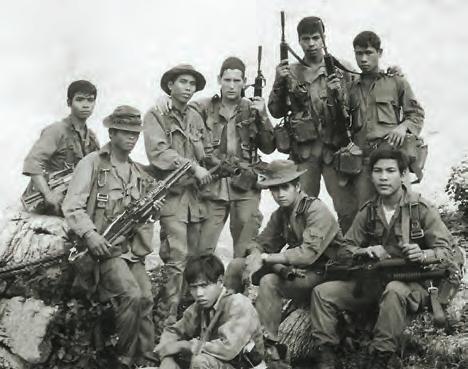
gasps of the U.S. pacification effort. In early 1975, the Politburo in Hanoi launched what proved to be the war’s final offensive.
In Phu Yen Province, the 320th NVA Division finished what the 95th NVA Regiment started 10 years earlier. Massed infantry formations and firepower of the 320th overwhelmed the remaining ARVN defenders; the province was another domino that fell to the NVA. In the book’s closing, Thompson reinforces his thesis, writing, “Conventional warfare had dictated pacification from beginning to end in Phu Yen.”
—John Howard
A Worthy Tribute To True Heroes
I can say without hesitation that SOG Kontum: Top Secret Missions in Vietnam, Laos, and Cambodia 1968-1969 by Joe Parnar and Robert Dumont is one of the best histories assembled by Vietnam War veterans that I have ever read. This is an ideal companion book to John Plaster’s SOG: A Photo History of the Secret Wars, which we profiled in our portfolio. This book is a very moving tribute to the heroism of the top-secret unit based on research and oral histories gathered from SOG veterans themselves.
memories of the men described shine all the brighter for it because they kept going despite it all, not only for themselves but for others.
SOG Kontum: Top Secret Missions in Vietnam, Laos, and Cambodia, 1968–1969
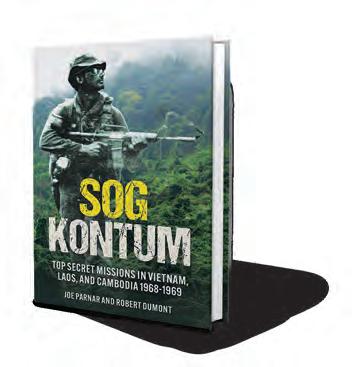 by Joe Parnar and Robert Dumont. Casemate,
by Joe Parnar and Robert Dumont. Casemate,
2022, $37.95
It is true that Special Forces fighters draw admiration for their toughness, grit, and prowess in the field of battle—and there is plenty of that to be found in the book. Those who love soldier stories as much as this reviewer will find much to appreciate and enjoy while reading about SOG men navigating do-or-die missions, backed by quick wits, combat skills and a salty sense of humor. Reflecting on all their daring, you might be tempted to think that such men were invincible—but they were not, and it is actually the tales of human vulnerability contained in this book that makes it outstanding. Amid all the glory there are plenty of stories of fear, pain, and human frailty–and the
One of the many examples of heroism described in the book is that of John Kedenburg, who would be posthumously awarded the Medal of Honor. Kedenburg had the opportunity to be lifted from a fierce enemy onslaught but sacrificed himself to allow an indigenous trooper to be saved by the evacuation helicopter. Author Joe Parnar was called upon to wash his fallen comrade’s body for transport back to the United States. He writes: “I was never an overly religious person, but I recalled the story of someone telling Christ they were not worthy to loosen the thongs of his sandals. This is how I felt as I unlaced John’s boots.”
SOG operatives entered enemy territory wearing “sterile” clothing with no items that could give the enemy any indication of their individual identities or nationality.
This powerful sense of sacrifice permeates the book and makes it profound and unique—especially when one considers the void of secrecy in which SOG existed. These soldiers entered enemy territory wearing “sterile” clothing, such as jungle fatigues spray-painted with black stripes, without any trace of individual identity. “Dog tags, ID cards, or any item that indicated an individual’s name or nationality could not be brought on a mission,” the authors write. Secrecy might seem glamorous to those of us looking on from a distance. But it meant that these soldiers, whose existence and purpose was officially denied by their government, fought and died within a proverbial vault of silence. It also placed them at risk of being totally erased from the annals of history and thus from living memory itself. Fortunately the authors have made a considerable and heartfelt effort to ensure that this is not the case—a worthy triumph honoring not only the SOG veterans living today but also the 407 U.S. SOG men killed in action and those who went missing and remain unaccounted for.
—Zita Ballinger Fletcher
62 VIETNAM HISTORYNET ARCHIVES
VIEP-230700-MEDIA-DIGEST.indd 62 4/24/23 11:15 AM
EDWARD R. FEDRICK






HISTORYNET ARCHIVES
BIG
Vietnam
The story of a soldier who served two combat tours in Vietnam with the famed First Infantry Division “THE
RED ONE.” He received four Purple Hearts after being wounded on four separate occasions while involved in some of the largest operations of the
War.
DARKNESS BRAVO A SOLDIER REMEMBERS BY
BOOK AND E-BOOK AVAILABLE AT AMAZON.COM VIE-230523-002
4/20/2023 We weathered COV ID -19 so now go with th e originator of th e battl efiel d return t o Vietnam—often copied but never duplicated! MHT has been Disabled VN Vet Owned nce 19 87! VN Tours Begin at $2,995! 13-Days Don’t Pay More for Less From Copycats! We weathered ID go originator th efiel d o Vietnam—often copied duplicated! & Op erated si nce 19 87! INFO @1-703-590-1295 NOTIFY@MILTOURS.COM READ THE MHTBLOG & FACEBOOK @ WWW.MILTOURS.COM MHT BACK ON THE BEACHES OF DA NANG! THIS WEEK IN HISTORY Join hosts Claire and Alex as they explore—week by week— the people and events that have shaped the world we live in. HISTORYNET.COM AN ORIGINAL VIDEO SERIES Check it Out! 9/16/21 11:20 AM VIEP-230700-MEDIA-DIGEST.indd 63 4/21/23 9:14 AM
36 CHAPTERS / 40+ PHOTOS
Edward Fedrick.indd 1
KEVIN “DASHER” WHEATLEY
THIS AUSSIE SAVED A CHILD’S LIFE AND GAVE HIS OWN FOR A FRIEND
By David T. Zabecki
HALL OF VALOR
Kevin “Dasher” Wheatley was the first Australian soldier to be awarded the Victoria Cross during the Vietnam War. Born in a suburb of Sydney in 1937, he enlisted in the Australian Army at age 19. He trained as an infantryman and served a combat tour with the 3rd Battalion, Royal Australian Regiment in Malaya between 1957 and early 1959. Advancing through the ranks to Warrant Officer Class 2, he deployed to South Vietnam in 1965, assigned to the Australian Army Training Team Vietnam. Wheatley earned the nickname “Dasher” due to his rugby skills and was known for his compassionate streak. He was once punished for going AWOL to save a stray dog and gave treats to local children in Vietnam. “He was a hard man, but there was a big soft side to him, too,” his son George later recalled.
During one of his first actions with ARVN regular troops in Quang Tri Province, Wheatley rescued a 3-year-old Vietnamese child who had wandered into the crossfire, running into the line of fire to shield her with his own body. In August 1965, Wheatley was working with U.S. advisors to coordinate an ARVN attack on a VC-held village. As the VC defenders faltered, Wheatley launched a one-man assault up a steep slope that finally broke the position. The senior U.S. advisor recommended Wheatley for the Silver Star, but the paperwork went into bureaucratic limbo because of Australian policies regarding the acceptance of foreign awards.
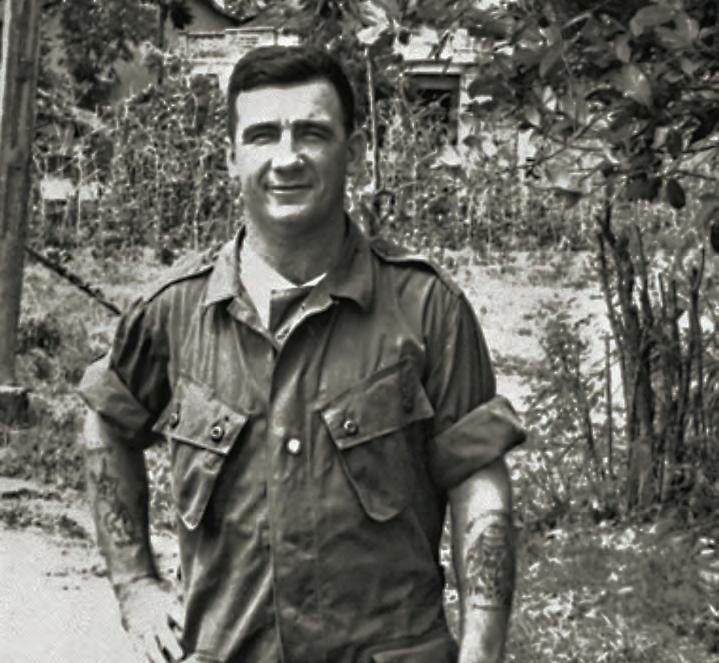
That September, Wheatley was assigned to a team under Capt. Felix Fazekas operating in coordination with U.S. 5th Special Forces Group in the Tra
Bong District of Quang Ngai Province. On Nov. 13, Fazekas, Wheatley, and Warrant Officer Class 2 Ron Swanton were advising a Vietnamese Civil Irregular Defense Group company conducting a search and destroy sweep 15 kilometers east of the Tra Bong Special Forces Camp. Fazekas accompanied the CIDG platoon on the left flank. Wheatley and Swanton accompanied the platoon on the right. At about 1:30 p.m. Fazekas’ platoon drew fire from a small VC detachment that fell back. The right flank platoon ran into a well dug-in company-sized force. Swanton was hit immediately in the chest. The CIDG platoon on the right started taking heavy casualties and scattered.
Calling for medical evacuation for Swanton, Wheatley half-carried, half-dragged his wounded comrade under heavy automatic weapons fire across 200 meters of open rice paddies into a safer area. He was accompanied only by a CIDG medic, Pvt. Dinh Do, who told Wheatley that Swanton was dying and had no chance of recovery. As the VC closed in, Wheatley ran out of ammunition. The CIDG medic withdrew as the VC closed to within 10 meters, urging Wheatley to do likewise. Refusing to leave Swanton, Wheatley held a grenade in each hand. As he retreated, the medic heard both grenades go off. The bodies of Wheatley and Swanton were recovered the next morning. Both men had died of gunshot wounds; Fazekas later wrote in his after-action report that both had been shot several times at close range.
When Wheatley initially was recommended for the Victoria Cross, it generated a certain amount of controversy. Australia at that time was still under the system of British imperial military awards, which required final approval of the British government. But Britain had refused to support America’s war in Vietnam, and there was some opposition to the award of Britain’s most prestigious decoration. In the end, Wheatley’s magnificent heroism and sacrifice overcame all bureaucratic resistance.
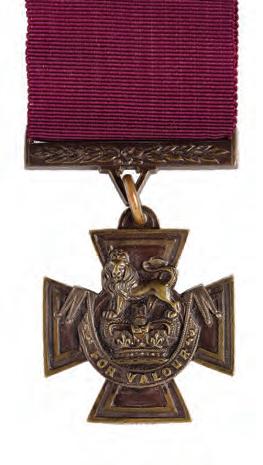
After his remains were repatriated, Wheatley was buried with full military honors at Sydney’s Pinegrove Memorial Park. The South Vietnamese Government awarded Wheatley the National Order of the Republic of Vietnam, Knight’s Degree; the Military Merit Medal; and the Gallantry Cross with Palm.
Miraculously, Wheatley’s U.S. Silver Star recommendation finally emerged from the bureaucratic maze. It was presented to his son, George, in December 2021. V
64 VIETNAM AWM A05546
Retired U.S. Army Maj. Gen. David T. Zabecki is Vietnam magazine’s editor emeritus.
VIEP-230700-VALOR.indd 64 4/21/23 8:54 AM
5 Countries, 5 Pure Silver Coins!

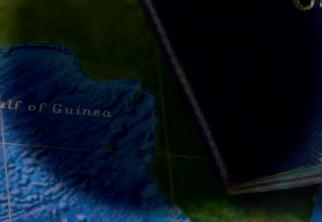
Your Silver Passport to Travel the World

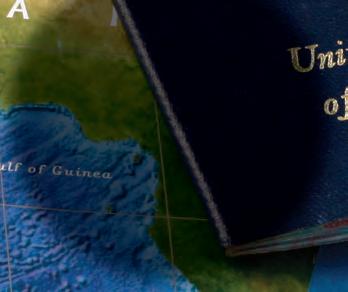

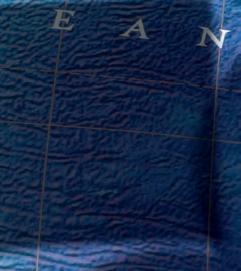

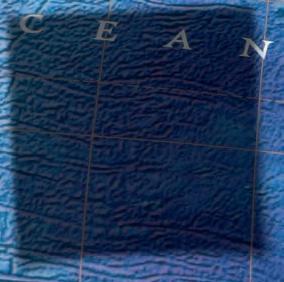


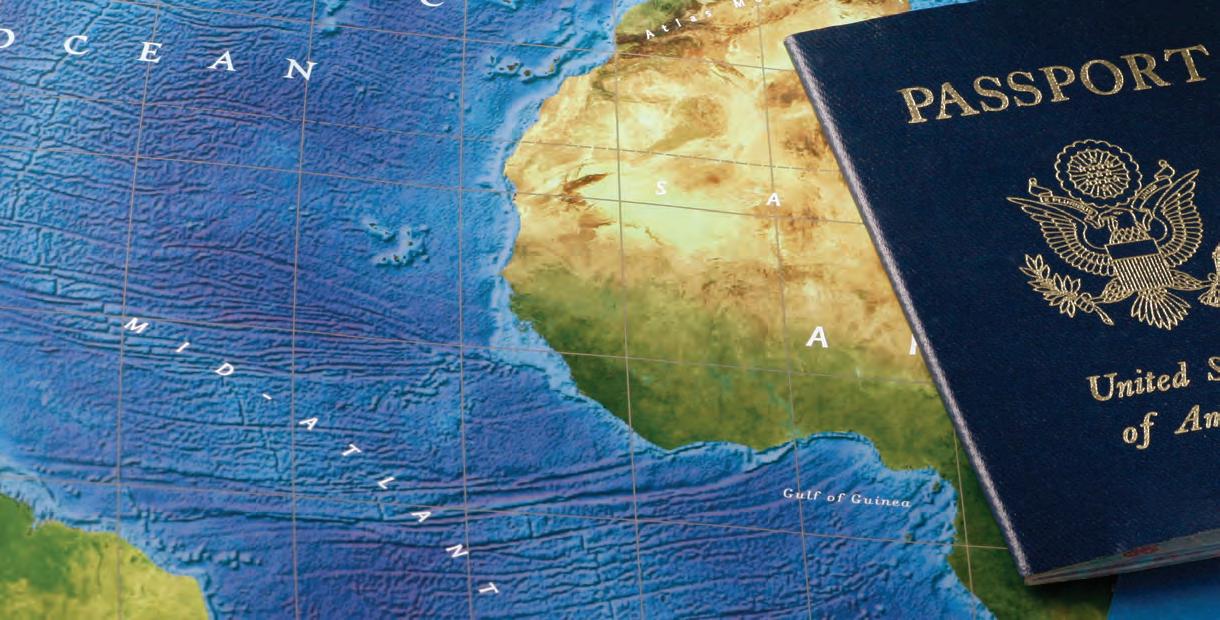
The 5 Most Popular Pure Silver Coins on Earth in One Set






Travel the globe, without leaving home—with this set of the world’s ve most popular pure silver coins. Newly struck for 2023 in one ounce of ne silver, each coin will arrive in Brilliant Uncirculated (BU) condition. Your excursion includes stops in the United States, Canada, South Africa, China and Great Britain.
We’ve Done the Work for You with this Extraordinary 5-Pc. World Silver Coin Set
Each of these coins is recognized for its breathtaking beauty, and for its stability even in unstable times, since each coin is backed by its government for weight, purity and legal-tender value.

2023 American Silver Eagle: The Silver Eagle is the most popular coin in the world, with its iconic Adolph Weinman Walking Liberty obverse backed by Emily Damstra's Eagle Landing reverse. Struck in 99.9% fine silver at the U.S. Mint.





2023 Canada Maple Leaf: A highly sought-after bullion coin since 1988, this 2023 issue includes the FIRST and likely only use of a transitional portrait, of the late Queen Elizabeth II. These are also expected to be the LAST Maple Leafs to bear Her Majesty's effigy. Struck in high-purity

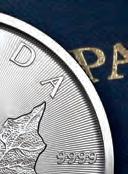
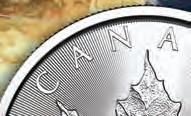

99.99% fine silver at the Royal Canadian Mint.
2023 South African Krugerrand: The Krugerrand continues to be the best-known, most respected numismatic coin brand in the world. 2023 is the Silver Krugerrand's 6th year of issue. Struck in 99.9% fine silver at the South African Mint.




2023 China Silver Panda: 2023 is the 40th anniversary of the first silver Panda coin, issued in 1983. China Pandas are noted for their heart-warming one-year-only designs. Struck in 99.9% fine silver at the China Mint.

2023 British Silver Britannia: One of the Royal Mint's flagship coins, this 2023 issue is the FIRST in the Silver Britannia series to carry the portrait of King Charles III, following the passing of Queen Elizabeth II. Struck in 99.9% fine silver.

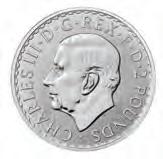
Exquisite Designs Struck in Precious Silver




These coins, with stunningly gorgeous finishes and detailed designs that speak to their country of origin, are sure to hold a treasured place in your collection. Plus, they provide you with a unique way to stock up on precious silver. Here’s a legacy you and your family will cherish. Act now!
SAVE with this World Coin Set
You’ll save both time and money on this world coin set with FREE shipping and a BONUS presentation case, plus a new and informative Silver Passport!
BONUS Case!

2023 World Silver 5-Coin Set Regular Price $229 – $199 SAVE $30.00 (over 13%) + FREE SHIPPING
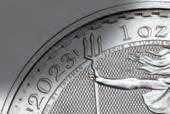
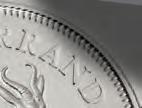

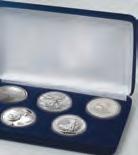
FREE SHIPPING: Standard domestic shipping. Not valid on previous purchases. For fastest service call today toll-free



1-888-201-7070



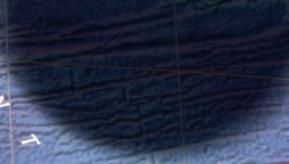
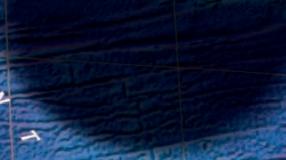
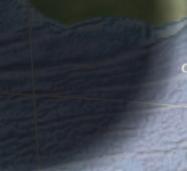
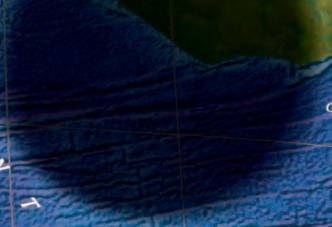












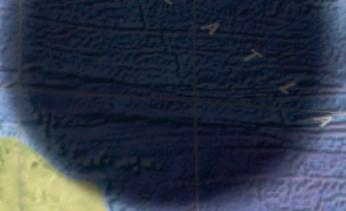
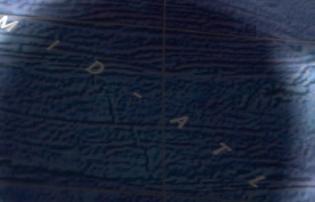

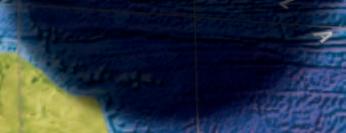
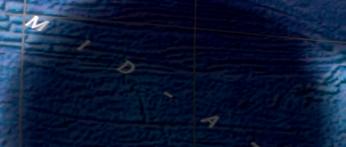












Offer Code WRD286-05
















Please mention this code when you call.










SPECIAL CALL-IN ONLY OFFER
Not sold yet? To learn more, place your phone camera here >>> or visit govmint.com/WRD
GovMint.com® is a retail distributor of coin and currency issues and is not a liated with the U.S. government. e collectible coin market is unregulated, highly speculative and involves risk. GovMint.com reserves the right to decline to consummate any sale, within its discretion, including due to pricing errors. Prices, facts, gures and populations deemed accurate as of the date of publication but may change signi cantly over time. All purchases are expressly conditioned upon your acceptance of GovMint.com’s Terms and Conditions (www.govmint.com/terms-conditions or call 1-800-721-0320); to decline, return your purchase pursuant to GovMint.com’s Return Policy. © 2023 GovMint.com. All rights reserved.
GovMint.com • 1300 Corporate Center Curve, Dept. WRD286-05, Eagan, MN 55121
VIE-230523-010 GovMint - 2023 World Silver Coin Set.indd 1 3/31/2023 7:06:42 AM







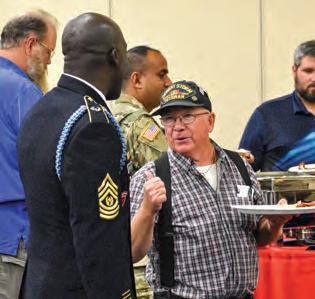

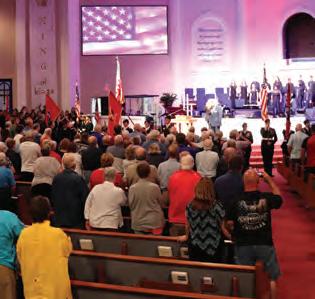
WELCOMEHOMEVETERANSCELEBRATION.COM 931.320.0869 | frances@visitclarksvilletn.com POW/MIA Remembrance Event Valor Luncheon Breakfast with a Hero Opening Night Dinner Featuring a Musical Patriotic Salute Legends and Legacies Concert Hank Williams, Sr. 100th Birthday Tribute Women Veterans Tea Veterans Picnic Welcome Home Parade VIE-230523-005 Clarksville CVB.indd 1 4/19/2023 10:24:23 AM






























 By Andrew McGregor
By Andrew McGregor
 By Barry Levine
By Barry Levine

 By John Walker
By John Walker






 By Jeff Harvey www.historynet.com/loc-ninh-
By Jeff Harvey www.historynet.com/loc-ninh-





















 —James Creech
—James Creech




























































































































 By Andrew McGregor
By Andrew McGregor














 By Barry Levine
By Barry Levine










 By Warren Wilkins
By Warren Wilkins













 By Zita Ballinger Fletcher
By Zita Ballinger Fletcher































 By Robert J. Thompson III. University of
By Robert J. Thompson III. University of


 by Joe Parnar and Robert Dumont. Casemate,
by Joe Parnar and Robert Dumont. Casemate,


























































































